#but also we want a very very specific motif from the first A Single Shot thing in Partizan
Text
someone's gotta make phrygian's triumphant musical theme that comes out in scenes like this and name it A Single Shot
#we wish we knew how to make music#hard mode is trying to convey the branched and Keith's description of the weird music that phrygian's true form is#but also we want a very very specific motif from the first A Single Shot thing in Partizan#like guys. guys. do you see this anime with us#can you hear it coming back whenever phrygian takes down something huge by themself in one hit#and the audience going nuts#it's not the main theme this is its own song and it's called a single shot and it is just for this beat#a rare beat but it IS recurring and it's SO cool#the BUILDING anticipation of teammates setting this shit up and everyone coming the fuck together#and then Phrygian giving it all they've got and hitting the final blow#and it's so cool#and then we are coasting on the comedown from that big BAM! climax in the song as Phrygian comes to talk to that prisoner#like this is just paperwork this is just closing it out this is just getting your reward#and then something goes wrong with the music and Phrygian's attempt fails and the guy doesn't leave#and the sound of the principality asserts itself and Phrygian gets hit with war-weary#please someone make this anime please#friends at the table#Palisade#Palisade spoilers#partizan spoilers#Partizan#first mate Phrygian our beloved
8 notes
·
View notes
Text
The character-specific leitmotif/theme stuff in Daniel Pemberton’s score for Across the Spider-Verse:

In opening sequence, “Spider-Woman (Gwen Stacy)”, Gwen’s material going through like 3 different formats immediately. Beginning with that calm/dreamy atmospheric stuff to indicate her most private experiences and domestic space (at home). Warm but sad. And then overlaid over the atmospheric stuff at 1:17 to 1:30 you hear what will become like an easily-recognizable Gwen motif/theme thing, though in this first reveal it’s distinct/memorable but it’s really quiet and almost completely alone and distant (she’s lonely). And even the structure itself of theme is like taking steps out and then back in, climbing and then stepping back down (like it’s reaching out, and then retreating again, like the traumatized Gwen). But then as the on-screen stuff transitions to Gwen’s public life/personae and exploits as energetic drummer and superpowered fighter at 1:33 we get like an explosive outburst of a much more action-oriented Gwen theme, and though earnest it sounds kinda like pastiche of like optimistic 1990s adventure (kinda like Gwen, earnestly wanting to engage with the world, but with like a veneer of forced/half-joking sunny Californian friendliness).
And then Miguel arrives, and in the part from 0:00 to like 0:30 in “Spider-Man 2099″ there’s the first declaration of Miguel’s theme with blaring distorted elephant trumpeting alongside like dirty techno pastiche. Nice. Instantly memorable though its first statement is singular and unadorned with any other accompanying music (very distinct/clear, like the first announcement of Gwen’s theme; and traumatized Miguel feels alone, like Gwen). Real cybertronic/laboratory feeling to it, evoking Miguel's mad-science-y world. Anyway, the theme is scary. A dangerous animal crying out in the dark night. Like you’re being hunted by a cyberpunk predator thing. Alarming and threatening and primal in a similar way to the first film’s Prowler theme (after all, while Kingpin and The Spot are arguably the chief threats to the wider world in the first and second films respectively, it is instead The Prowler and Miguel who are more like personal rivals/counterparts to Miles, and both, in a way, are a kind of family to him).
Then that spectacular and exhilarating moment in merely 20 seconds at 0:46 to 1:04 in “Indian Teamwork” where Miles is central (on-screen, even the other Spider-People around him are impressed, naturally taking cues from his leadership) and it’s the now-familiar electronic/hip-hop record-scratching Miles Morales sound/motif from first film, but as Pavitr appears on-screen, now it’s announcing itself aided with South Indian percussion instrumentation. And as their combined efforts lead to a climactic moment of heroism there is the triumphant general Spider-Man brass fanfare/theme (as the screen shows a money-shot, Miles and Pavitr effortlessly coordinate and cooperate, the two stars of the sequence), but the Spider-Man theme is backed not just by Miles’s electronic stuff but now also by like a powerful Karnataka sangitam vocal chorus, in harmony, as a kind of indicator for Pavitr.
And then the track during the finale (“Start a Band”), where Miles is trapped and defeated and basically stuck in a version of hell, with suspenseful strings. Before a threatening msked stranger he asks “Who are you?” (1:07), and awaiting any possible answer it’s like almost silent but with like a single metronome like a ticking time bomb, and then in response there’s like a little idk like “Doom” motif (1:12) when Prowler-Miles reveals his face (Oh no). But then the score adds the now-famous trademark Prowler theme howling (1:25) just as the menacing figure indeed confirms “you can call me The Prowler”. And then when we see Miles’ face as he considers the predicament and the electronic/hip-hop Miles motif comes back but now it’s punctured by an even more powerful doom motif (1:48), the doom now a part of his identity, as if Miles can’t ever escape the ramifications of what’s about to go down, whatever follows. Then the Prowler howling, still an alarm of sorts as in the first film, now also becomes like a desperate plea, crying in the night, and then as a levitating demon-like Spot appears on-screen outside of Miles’s family’s home about to “take everything” from him the general Spider-Man theme shows up again but it’s desperate and backed by the high-pitched pleading version/form of the Prowler howl. And almost like a response to the plea for aid, we cut to Gwen’s whereabouts (she’s committed to rescuing her friend) and the like Gwen motif of forceful garage/post-punk drums come in, and then as we see like Hobie’s tell-tale fractured glitch effect framing her (he’s committed to helping his friend, too) the electric guitar Hobie motif backs Gwen’s drums, as Gwen’s drumming becomes more insistent and confident (like her throughout this story, and now rather than running away from danger, Gwen is running towards the challenge). So that Miles’s electronic beat, Gwen’s drumming, and Hobie’s guitar coalesce, forming a coherency, and, finally, together, the Spider-Man theme. And we finally cut back to Miles, accepting the reality and seriousness of the situation, as the general Spider-Man theme rises despite and amidst all of the cacophony, with an expression of defiance and resolve, his fingertip alight with electricity on the verge of unleashing his power. End titles.
Fun stuff.
20 notes
·
View notes
Text
Mildly obsessed with the sheer contrast between how Fujiko and Jigen tend to be framed in this show, even when they're within the same scene (a head's up: I'll be mentioning stuff around some uh. extremely dubious consent and also suicidal ideation and suicide that's going on in Jigen's introduction ep in this post, just so you know!)


an illustration of what I mean more generally: Jigen by himself seems to often be framed against planes of white or shades of desaturated grey without a lot of detail -- there's this real sense of emptiness, and also symbolic of death and grief, I think. (Ciccolina also wears a white dress while you see her fascination with him, and the thing that binds them together is essentially suicidal ideation, while her own actual signature colour is an unsettled green.)
meanwhile Fujiko is constantly framed by circles and elaborate designs in vibrant intoxicating colours (peacock vibes!), in a way that's both stunningly beautiful and uncomfortably claustrophobic -- like she's constantly framed and hemmed in by the beauty of both herself and what she surrounds herself with. dare we say... almost cocoon-like, considering all the butterfly motifs going on all over the place. (also that GODDAMN OWL in the window up there... pls I want to go home).
a very smart anon ask I got also pointed out that a lot of the shots in episode 2 specifically make the characters look like actors on a stage, which adds that extra sense of artificiality and alienation to the whole thing and makes us subconsciously question their agency, which I thought was such a great observation!


this theme/contrast keeps going after that first introduction episode too (this is from the end of episode 8)! there's not quite as concentrated an amount of it after the intro, but it still feels consistent.
and the way those themes are divided up when they share a space is so interesting too:




interesting detail about this scene, by the way: the colour of the sofa... thingy goes from purple when Fujiko is in the room and dominating the space, to the green that's associated with Ciccolina once Jigen wakes up alone after Fujiko y'know. roofied him or whatever that was. (yeah gee I wonder why he doesn't trust her much lol)

so his own theme is almost monochrome and other people sort of... impose their colours on his 'world' whether he wants that to happen or not, metaphorically. it tells such a strong visual story about not being able to put up boundaries. which -- at first I heard Ciccolina's comment that his weakness was women and just went '*wheeze* are you sure about that one lady', but actually and especially in this installment... it's kind of true, if in an unorthodox way. his actual problem is that he doesn't seem able to set a single solitary healthy boundary with women. like he lets himself get hard dubconned into fucking in an ACTUAL COFFIN because Ciccolina framed it as the only thing that would keep her alive and they've entered into this exceedingly fucked up codependent dynamic where it's his job to do that for her psychologically as well as physically as a body guard. there doesn't seem to be any physical attraction or desire on his part through the whole thing but there is an unspoken idea that if someone who depends on him needs something from him, it's his duty to give it no matter what that does to him. Oh boy. Hey mr mafia boss man did you ever consider maybe y'know... getting your wife a fckn therapist instead and not have this whole Situation play out lmao
(Fujiko does seem to pick up on this fairly quick -- she tries a couple of rounds of her normal come-hither tactics, but it only takes her a few goes before she gets that no, he really is just uncomfortable and uninterested by the whole thing, but also... he won't use hard physical force to stop her, which is how she gets the drop on him eventually.)

then there's this at the end -- Fujiko is wearing Ciccolina's shade of green, lending credence to her saying Ciccolina reminded her of herself -- and thus essentially by being her co-conspirator in killing herself, she's in some small metaphoric way doing the same to herself. thus rendering Jigen only a completely baffled bewildered suicide weapon with very little agency in this situation lol. rather cruelly literalizing what he keeps telling people -- that he's just a hired gun; the magnum isn't just his life and his past, it's the sum total of what he's been living as (and it's been killing him!): a tool in other people's hands. at first I was a bit ?? about him getting out of the killing business under his own initiative, but when I look at it like that it makes sense -- in this continuity he sort of gets this last wakeup call that it's only so long he can keep lying to and dehumanizing himself before that takes over and becomes the truth. on the road he's on there's death ahead either literally or spiritually, and in this uh 'timeline' he gets out of there before he succumbs to it completely. (and as I've said before, I personally think First Contact!Jigen was actually further along that road when he met Lupin, so in an odd way this is a softer less broken Jigen, just in a much more fucked up show haha)
I do find it kind of heartbreaking how those completely central parts of him -- that capacity for dedication and care and loyalty and devotion, clearly yearning and fighting to still exist even within the supremely dysfunctional circumstances he's in -- both hurt him so bad and are maybe the biggest part of why the wakeup call works on him in this episode. he went and did something so completely counter to his own nature because he let himself be a tool with no will of its own for so long, and it startled him out of it, I think. (I mean she did also actively trick him in a truly screwed up way, but it is kind of the end station of how he's been living as well.)
with the added imagery of this being like a stage in this ep, they're also finally walking off the stage after Ciccolina's love note to death play is over, back into the world.
AND finally... here's a little thesis I have -- everything going on in TWCFM is always ultimately mostly about Fujiko in the end, even if she's not on screen for something. (and good for her honestly she deserves her day in the limelight.) so this little plot of Ciccolina's is actually telling us something about a part of Fujiko -- a reflection of someone who would want the only person who gave her hope to kill her, because...? because she wanted to force him into proving that the hope was never true after all, or as a test of it? because she thought he was the only one with the right to decide for her (after all in her mind he already did once)? because she wanted to hurt him as badly as he had hurt her by making her keep living? to show him something, since it's heavily implied he goes to that place in his head a lot as well? all of the above and more? well, there are some interesting parallels with the uncanny spoken word poetry in the opening credits here, huh, with its empty boys with nothing left to steal and the whole 'kill me, save me' setup of contradictions.
but then in episode 9 you have a very similar thematic thing going on where Fujiko sees herself in another woman and tries to destroy her as a way of destroying herself (rather more actively and viciously this time around of course lol), and instead of being reduced to the instrument to make it happen that time Jigen is the healthily protective nurturing force that stops her from being able to. Lupin might be the one to actually understand why she's doing it and in a way is what helps her stop before she goes through with it, but Jigen is the one who responds to an innocent abused girl in the middle of it all in, y'know, a human way. (The Woman Called Fujiko Mine!Lupin is like... an inscrutable unknowable trickster god come to gaze at Fujiko and Understand as if he can see the narrative from the outside, and he's quite hard to really like. get attached to for me, but I do like that his basic disposition is pretty much the same as always under that. and he is the one who brought Jigen in for this job too, like he knew he'd be needed.)
man I still have so many thoughts about it I can't quite explain, but it's definitely something about Ciccolina being an adult and the Tattooed Woman being coded as a child, essentially. Fujiko can work with the damaged and depressed but adult and in control through manipulation parts of herself, but she wants to utterly eradicate the young vulnerable innocent parts that have been hurt. which is not uncommonly how that works out in real life trauma too. (complicated a bit by the revelations in the last few eps, but thematically overall in the show I think this is what's happening).
#lupin iii#the woman called fujiko mine#fujiko mine#daisuke jigen#lupin iii meta#when I tell you this show does its most interesting storytelling in the art --#also the things one could extrapolate from this about jigen's mom... deeply troubling at best#I have no background in actually analyzing art but I've just tried to pin my feelings to the page here and hope it does something haha#I have a vague nebulous idea that jigen is often framed against darkness in the rest of the series once he's 'on his own'#but that might also be because you often see him in night scenes at that point? still not a lot of bright colours#unless lupin is around as well tho#I do think it says something about this show that ep 2 was one of the LESS uncomfortable eps to watch for me lmao#like it's messed up but not the '...can I just fast forward through this part or skip it 😬' messed up like some of the others#(still trying to watch the last two through my fingers sfakdjfa)#man this is one of those 'brain is pressure cooker' exorcism posts I have way too much stuff in here and i can't hear myself think lol#there may also be some yin/yang dark/light female/male stuff going on? but I honestly don't know enough about any of that to say lol
119 notes
·
View notes
Link
Congratulations to Adriano Goldman , ASC, BSC, ABC, Director Of Photography, for his Creative Arts Emmy win OUTSTANDING CINEMATOGRAPHY FOR A SINGLE-CAMERA SERIES (ONE HOUR) for season 4 episode 3 ‘Fairytale’ on September 11, 2021. Here are his insights on filming the episode with director Benjamin Caron.
‘The Crown’ Used Lighting and Composition to Trap Its Characters Inside a ‘Fairytale’
Director Benjamin Caron and cinematographer Adriano Goldman discuss how they destroyed Diana and Charles’ marriage before it even began.
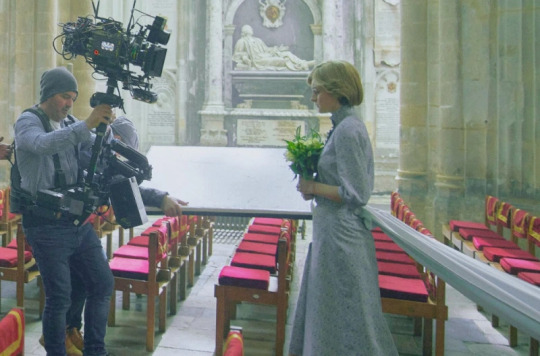
Behind the Scenes of “The Crown” Season 4, Episode 3 Photo: Netflix
Over “The Crown’s” four seasons, the halls of Buckingham Palace have become familiar visual signifiers for both the grandeur and the pressure placed upon the royal family. But in the third episode of this most recent season, “Fairytale,” cinematographer Adriano Goldman and director Benjamin Caron stretched the limits of the show’s visual language to create — and then to destroy — Princess Diana’s (Emma Corrin) fairytale fantasies.
Much of the episode is given over to Diana slowly realizing that, like many princesses stuck in a castle before her, she has fallen into a trap. But Goldman and Caron opened up the ways they shoot their Buckingham Palace sets to show how the demands of the Crown consume everyone on the eve of the fateful marriage.
They force the jaws of the trap open wide with a pre-credits sequence of Diana’s night out with her friends after Charles (Josh O’Connor) proposes to her. The scene is a departure in every sense, not just to the swank ’80s members’ club that Diana frequents.
“You try to deliver something that is more romantic, a little bit more colorful, fun to start,” Goldman said of the sequence in an interview with IndieWire. “We wanted to not change the style too much, but there should be a transition from a very colorful pre-title sequence, a very interesting and more romantic beginning.”
That romance is on full display, most noticeably in the brighter, guadier colors of the club and much warmer tones of Diana’s Earl’s Court flat. But Goldman’s camera also interposes itself almost as a fourth (slightly intoxicated) friend, swinging around inside the girls’ cab to get a look at both Diana and Buckingham Palace, or flinging itself down onto the bed with the girls at the end of the night. The look of the sequence stands in contrast to the stately shots and slow tracks which are the show’s normal rhythm for everyone in the royal family. Well, for everyone in the royal family except maybe Princess Margaret (Helena Bonham-Carter), who gets to dance by a pool every now and again.
“We really considered how we could reverse [that fairytale opening] and be very present with her, and [how we could] make her feel young, actually. Part of this is she’s a young girl going into the palace,” Caron said.
Caron and Goldman gave the audience several visual signifiers that are easy to clock in this sequence, as well as Diana’s goodbyes to her friends that follows: the gold and neon hues of the night out, the warm, eye-level close-ups of Diana dancing in the club, and a signature spiral staircase Diana descends to begin her life as a princess.
Over the course of the episode, these colors will fade. The close-ups inch slightly above Diana’s eyeline, so that it feels like the camera, along with the rest of the Royals, is looking down on her. And when a spiral staircase reappears, it will lead to Diana’s lowest point.

“The Crown” Season 4, Ep. 3 “The Fairytale” Screenshot
With Diana ushered inside Buckingham Palace to shield her from the press in the run-up to her and Charles’ wedding, Caron and Goldman emphasized how small and vulnerable Diana looks inside the palace walls. The opening of “Fairytale” had a long shot of the club, and Diana fit snugly within it. Once inside Buckingham Palace, the negative space often overwhelms Diana, and the camera backs away to show just how alone she truly is, perhaps best exemplified in the scene of her grandmother (Georgie Glen) physically tying her up while instructing her in how to speak like a royal.
Caron and Goldman deliberately call back to the romance of the opening to twist the knife, having Diana dance ballet inside the palace and then try to break out of the regimented structure of it as the pressure on her mounts. “I remember sort of holding the frame and I remember the camera operator was trying to follow us, but [I said no,] just hold the frame static and let her move in and around it,” Caron said. “So it really felt like someone trying to break out [of] somewhere.”
But of course, the camera never does let her leave the frame. Unlike the quick, fun cuts of Diana dancing in the club, there is no pressure release here. There is nowhere for Diana to go.
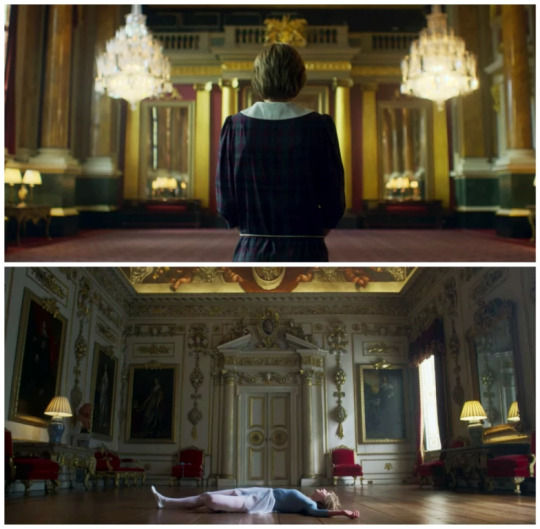
“The Crown” Season 4, Ep. 3 “The Fairytale” Screenshot
Caron wanted to use visual features that would feel right at home in a Disney princess story to their most punishing effect and perhaps the most powerful one of these motifs reoccurs when “The Crown” has Diana descend another spiral staircase. “[Ben] was very specific about this spiral because she’s going down on a spiral emotionally,” Goldman said of the shot that leads Diana down to the kitchen, a moment of late night desperation that kicks off her eating disorder. “He didn’t want to follow her on the steps, like on a steadicam. He wanted [the camera to be] facing down and going down with her to the very bottom of her feelings and her emotions.”
Caron described it as going to the “bottom of a well,” once Diana enters the kitchens and becomes enveloped in darkness — except for the fluorescent blues of the refrigerator lights, which makes the space feel like a morgue. This strong use of color, like all the changes in the episode, is grounded in the reality of whatever space Diana finds herself in. But the emotion and, indeed, the foreshadowing that Caron and Goldman are able to imbue those spaces with give Diana’s spiral real visual potency and a visceral sadness.

“The Crown” Season 4, Ep. 3 “The Fairytale” Screenshot
What is so thrilling about “Fairytale” is that it spares no one. Two striking scenes toward the end of the episode don’t have Diana in them at all, and yet push the series’ visual language to show how the palace and this marriage will swallow the characters who have been there all along.
In the first of these, Margaret tries to persuade Elizabeth, the Queen Mother (Marion Bailey), and Philip (Tobias Menzies) to call off the wedding. Caron wanted the scene to have a “conspiratorial, almost a Jacobian feel” to highlight the cold, businesslike calculations these four people are making for the happiness of two others.
“I remember saying to Adriano,’no no no, let’s go darker,” Caron said of this sequence and the next one. Goldman also recalled the desire to push the scene even further visually, lighting characters at harsh, dynamic angles or in almost complete shadow, so that the scene would feel spiritually closer to “The Godfather” than to the show’s usual style. The comparison is apt, given the mahogany browns and greens of the sitting room and the firelight that Goldman and Caron used to emphasize shadows falling into the crags on the characters’ faces. Vito Corleone could easily be sitting in a corner of one of those frames.
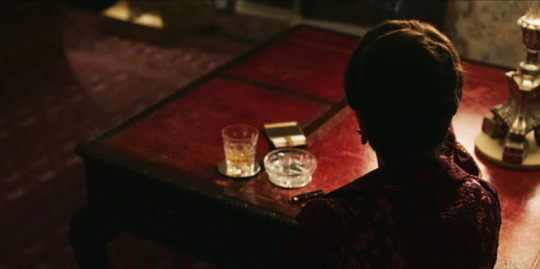
“The Crown” Season 4, Ep. 3 “The Fairytale” Screenshot
The next scene — when Elizabeth goes to find Charles and offer him a final few words on his marriage — Caron and Goldman viewed as a way to visually crystalize their relationship and how it is marred by their obligations to the monarchy. “Wouldn’t it be painful if you had Charles looking out the window and he felt the reflections of the fireworks and the noise and the celebrations outside?” Caron said about how he started conceiving of the blocking and framing of the exchange between mother and son. Each cinematic choice builds from a sense of what would be more painful, what would put more strain on the relationship.

“The Crown” Season 4, Ep. 3 “The Fairytale” Screenshot
The filmmakers created this visual strain between Queen and Crown Prince not just by keeping them at opposite sides in the composition, but by keeping one of the pair always just out of focus in the shots with the two of them — they can’t even occupy the same level of detail in the frame. Color plays a role, too, with bright blues and reds from the fireworks, reflections of the Union Jack, always being part of the light through which the audience sees the resigned sadness on Colman’s face and the abject misery on O’Connor’s. Goldman said this is the scene where he realizes he will never escape the system of the monarchy. “He realizes it’s too late. It’s a trap. He’s been trapped.”
“It always comes back to the Crown,” Caron said, and it is really from the perspective of the Crown itself that we watch the characters prepare to head to church on the day of the wedding. When the audience finally sees Diana in her dress, she faces away from the camera and moves into that oppressive cavernous space which has put so much pressure on her throughout the episode. It’s a slow, almost funereal march toward the fate the audience already knows awaits her. Charles, on the other hand, gets the close-up this time. But the camera, with equal grimness, tracks slightly down and in, so that his face begins to loom over the frame, making him look monstrous.
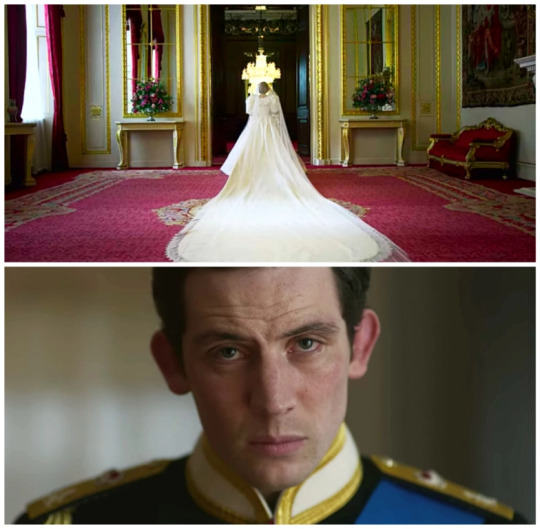
“The Crown” Season 4, Ep. 3 “The Fairytale” Screenshot
Of course by now, the visual choices that Caron and Goldman made for “Fairytale” have taught the viewer that there is another monster, a much more powerful one, looming over the episode’s final frame: The Crown is the monster that always gets you in the end.
#emma corrin#josh o'connor#princess diana#the crown netflix#the crown#emmy awards 2021#cinematography#adriano goldman#the crown season 4#thecrownnet
39 notes
·
View notes
Text
canaan bubble redux as a womb for story/character arcs
I’m sure most of this has been posted about before but: ever since my initial read I’ve been obsessed with the gross bodily/gorey stuff in the Canaan redux and I wanted to organize some of my constant+chaotic thoughts!!
TM has said that a lot of the motifs/events in the bubbles are actually “Silent Hill stand-ins” for story elements and she hopes we pick up on stuff, so here’s my Attempt!
At the same time that Harrow’s mind is being made a tomb for Gideon Nav Wake’s subconscious is pulled in to act as a womb for certain plot elements right alongside it. The chronology/time period of HtN mimics a full nine-month gestation. There’s a lot of very literal imagery here (which is below the cut), but I also think we’re meant to see it as metaphorical: we’re able to glean some things about character arcs based on how everything in the bubble goes down.
I’m particularly interested right now in those ‘side’ characters in the bubble who aren’t actually dead, who barely appear in the bubble at all except to get summarily offed, all in very distinctive ways. Judith, Camilla, Palamedes, and Coronabeth.
(cw below cut for some pregnancy/insemination imagery, canonical body horror and gruesome bubble deaths rehashed)
First of all just some quotes showing some of the imagery that I’ve attributed to being Wake manifesting pregnancy trauma stuff (there’s possibly some of Harrow’s conception trauma here, too) seeping through, for the purposes of this line of speculation.
This isn’t nearly all of it, but some things that stood out to me as possibly comparing Canaan House 2.0 to a functioning reproductive system:
(ch. 21) a “collection of large, rusted pipette needles” -- turkey basters?
(ch. 35) “great, slithering, pulsing tubes” which contain “whitish-pearl bubbled globules”-- this perhaps recalls ovaries/fallopian tubes, with the ‘globules’ being follicles produced by superovulation for insemination, or corpus luteum that supply progesterone to maintain a pregnancy.
(ch. 45) “stretched webs of organ [...] like nets of sticky venous spiderweb” --uterine walls, maybe; it’s all over the windows, totally encasing them in Canaan’s rooms, and arguably even contracting like a uterus would: “every so often they would tremble uncertainly and erupt in floods of bloody, foamy water.”
in the next pgh we get some more of the tools Wake would have used to conceive/upkeep the pregnancy: “pipettes, broken glass-fronted containers filled with dark fluid,” skeletons sitting atop piles of “capsules or pills” perhaps hormones/supplements. (also holding Drearburh tools, the way Wake’s skelly would have been doomed to do)
(ch. 43) “from that hole emerged a clattering pile of plex scope slides, the type you would preserve a cell sample between“ -- Wake would’ve had to carry out the IVF process for implantation, this also seems like apparatus for that
(ch. 47) there’s the “libation” Abigail uses to summon Wake which is... well. It’s a “thin, milky, whitish liquid pooled at the base, sluggish in the cold,” and the summoning involves a bunch of ‘come’ commands, which I think might be Muir making a very elaborate jizz-adjacent “silly buggers with the emissions” joke.
Just a note, cause I’m hopeless about Pyrrwake: the Seconds’ quarters are almost completely preserved from the leaky body horror (though it’s still cold in there)--as if they represented a sanctuary in Wake’s subconscious. There are also letters in the nonagonal coffin room which spell out an anagram of “PYRRHA” (ch. 47).
So with all that in mind, I’d posit that the fake-ghost deaths are all metaphorical “rebirths” of various characters arcs for ATN. I haven’t delved into what this imagery might mean for Harrow or Gideon specifically because I know there’s a LOT and it’s probably above my theoretical paygrade (I would love for someone to tack on with that though!!) but I can talk about ‘side’ chars on a very big-picture level.
Judith’s simulacrum gets knocked off first (ch. 18); shot through the heart (both atria) while she and Marta’s ghost are trying to complete the winnowing trial. The Sleeper shoots her 7 more times after that, I guess partly just ‘cause she can, but Ortus notes that it seems like there was an element of "Anger” to it. It’s possible Wake wasn’t pleased to have someone messing around with Pyrrha’s lyctoral trial, infuriated that anyone would be attempting to replicate G1d/Pyr’s original downfall. She then ignores Marta entirely and climbs back in the coffin (now with the sword) once Judith’s out of the way.
[Marta’s] scarlet necktie looked redder too—by the time they’d gotten hold of Judith Deuteros the blood had dried hers nearly black.
Cohort red-and-whites being stained black with blood, like a certain high-collared BOE uniform... could be another little clue to Judith’s "heart” for the Emperor (and for Marta, and pretty much everything else she knew) being lost and her realigning--though not willingly, at least at first--with the other side.
Cam and Pal’s simulacrums are plainly executed (ch. 21), they have their “faces obliterated” each by a single gunshot, and it’s as if they just stood there and let it happen. In the bubble, “Harrow had never seen Sextus or Hect except from afar.” These simulacrums totally avoid having their features revealed to Harrow. I’m willing to bet their faces being obscured and then exploded is one of the clues we get to their eyes being swapped around the next time we see them in the epilogue and in ATN.
Regarding the twins: They are essentially non-extant in the bubble. Ianthe never appears because she’s still kicking and, in her own words, “doesn’t live alternate histories” (GtN ch. 15).
Coronabeth’s simulacrum scene (ch. 37) is SO vivid and cryptic. It fascinates me because it definitely is, in part, trying to tell us something poignant about the initiation of Corona’s “worse twin” arc in ATN.
[Corona] was turned away from Harrow, and her riot of hair—half-caught in a fillet, half-escaping—was soaking wet, a dark and crinkling amber in the rain. She was not fighting or arguing. She was still as a statue, and ready and waiting as a dog.
Sounds like the fake ghost preparing for that major shift in allegiance. Silas is the one to ‘dismiss’ her, with his “may the blood of your blood suffer,” which perhaps is a really Templar-y way of saying ‘now go wreck ianthe’s SHIT.’ When Harrow accuses him of sending Corona to her death, Silas asks “Death?”--as if he sees that what’s really just happened, at least metaphorically, is (re)Birth.
[Harrow] thought she saw, absurdly, a sudden gush of watery blood, as though the fog itself had been knifed; but it was gone almost as soon as she had seen it.
Sounds a bit like amniotic fluid/water breaking? Coronabeth doesn’t ever seem to hit the ocean (bodies of water=necromancy and that’s not her deal), she instead just kinda poofs, and Silas says she would have ended up “on her feet.” Coronabeth is ditching her family ties and is out for blood, and I think her charisma, willpower, and sheer desire for revenge will move her a long way in the ranks of Eden--probably even to the point of echoing Commander Wake’s ambitions and actions. I could delve into that damn portrait mirroring Ianthe’s obsession w/ Cyrus’ paintings on the Mithraeum... but that is a whole other post!
So all of these are fairly baseline observations and I think there’s a LOT more to be expounded on, if y’all wanna reply/reblog/DM with additions I would freaking love that, every time I open a page of this book I find something I missed before and it’s such a delight. Thanks for reading if you got this far!!
#the locked tomb trilogy#gideon the ninth#harrow the ninth#htn spoilers#shoutout to kallistoi and rusty-k for bouncing ideas around w me
333 notes
·
View notes
Text
Final PBIO/IOTNBO analysis and theory
This post is my final analysis and includes some questions I have as we go into the final weekend of one of the best dramas in history. It is VERY long as I consolidate and expand on my previous analysis and theories.
I also lost a big chunk of this post while I was working on the draft just a few hours before posting, resulting to this post as a little inconsistent. Excuse me if my points are messy and some points missing with some issues untouched (because I forgot 😭). I think most points can be linked back to my past theories so you can read up on them if you haven’t.
List of my theories before ep 14:
Do Heejae and the other woman
Moonyoung’s background and Go Daehwan
Head Nurse is NOT Do Heejae, she’s the previous housekeeper
Maybe Head Nurse really is Do Heejae
As usual, please note that anything I quote may be a mix of Netflix’s subs and my translation because I know Korean and Netflix tends to miss nuances sometimes.
Firstly, Park Ok Ran’s dead.
Let’s get this out of the way first. (You can read my first theory on her role in this whole saga.)
“She can’t come anymore.”
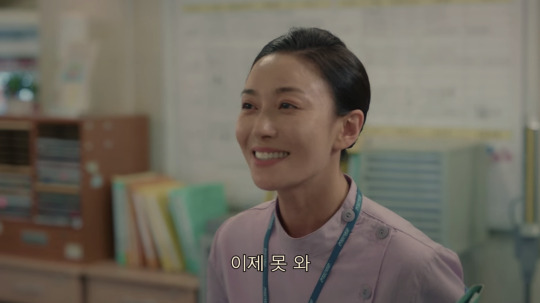
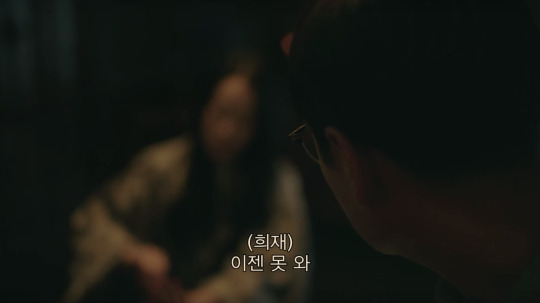
Can’t have her exposing Park Haengja. Or plot twist: she is alive and returns to save the trio from the villain 😆
No one’s memory is reliable
Not Kangtae’s as established in ep 6 that he didn’t remember his mother brought them to eat jjamppong because he’s the one who liked it, not Sangtae.
Not Sangtae’s. In spite of his good memory, it was established in ep 10 that he didn’t remember Kangtae saving him, so his memories can be flawed as well.
Therefore, not Moonyoung’s, and definitely not Go Daehwan’s.
There are few things that we can be sure because they are concurrent:
There was a female body in the basement that was disposed or disappeared.
The murderer of Taetae Bros’ mother wore Moonyoung’s mother’s a one-of-a-kind brooch.
There was a body in the reservoir.
Taetae Bros’ mother was the new housekeeper (I saw that some people disagree but here are the supporting screenshots).

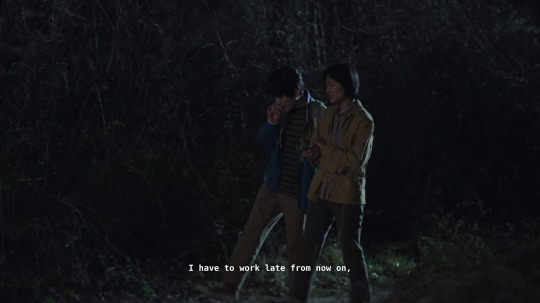
There were definitely two women
My theory that there were 2 women in Moonyoung’s family still stands and I’m expanding on it.
Let’s look at the family photos first. There are multiple versions of the family photo, and I suspect they were taken at different times. Here they are in what I think is the chronological order.
1) Photo in the basement: Go Daehwan had full-rimmed glasses, Moonyoung wore a scarf and stood closer to him with his hand on her shoulder, and the lady wore a fully black high neck top with the brooch on the right.

Before the family moved in, on the day Go Daehwan showed the lady around the house, he was wearing the full-rimmed glasses, and the house looked lived in (fully furnished, fully decorated, shelves full).
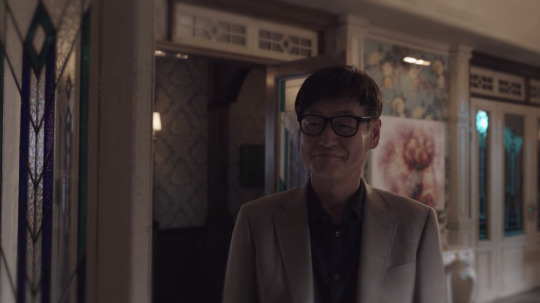
2) Go Daehwan’s photo: Go Daehwan had half-rimmed glasses, Moonyoung stood right in the middle and without the scarf, and the lady wore a blazer over a straight neckline blouse with the brooch on the right.
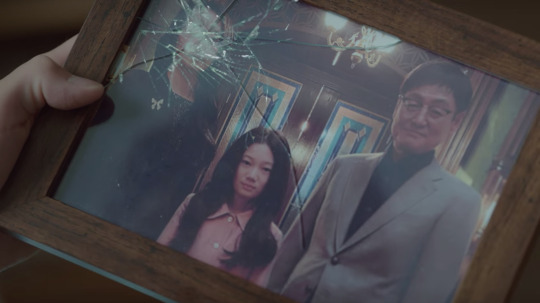
3) Park Haengja’s photo seems to be the same as Moonyoung’s: Go Daehwan with half-rimmed glasses, can’t tell whether Moonyoung was wearing a scarf or not but she sat nearer to the lady who wore the same blazer over a straight neckline blouse without the brooch.
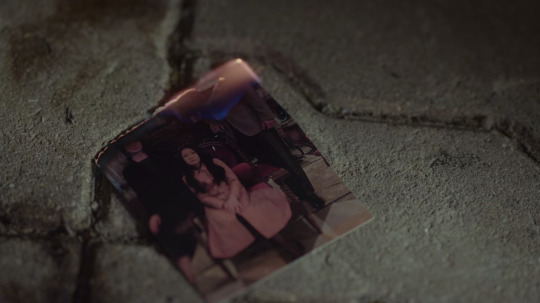

Go Daehwan had half-rimmed glasses when he realised his wife killed Taetae Bros’ mother.
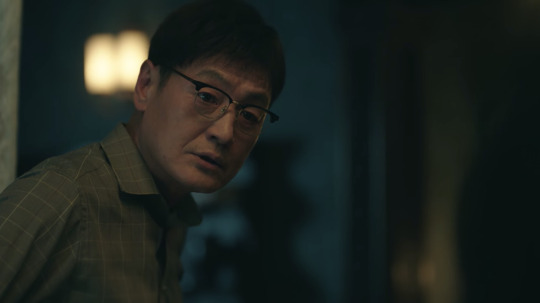
Photos are evidences of relationships. In a group photo, the people who are closer would pose closer to each other. These family photos tell us that Go Daehwan and Moonyoung were actually close, and showed us the progression of Moonyoung’s relationship with the woman.
But why were multiple photos taken? If they were the same woman, why are they still hiding the woman’s face in the photos?
When Go Daehwan killed his wife, he said, “If I die, my daughter will become a monster like you.”
Why was it “my daughter” and not “our daughter?” It’s even odder for Koreans because being a very collectivist society, they don’t claim people or objects as mine. They say “our country,” “our father,” “our daughter” to show unity even when they actually mean “my country,” “my father,” “my daughter.”


Moonyoung insisted she’s an orphan. Technically, when one biological parent dies, the child is an orphan (single orphan). So perhaps Moonyoung’s not wrong. And as explored in my second theory post, she might have been referring to her biological mother. The abusive woman was probably her stepmother.

Go Daehwan told Director Oh that his wife loved Moonyoung “terribly. Very terribly,” and we have Moonyoung who doesn’t want a child to not get jealous over Kangtae’s affection. Judging by the family photos (Moonyoung posing closer to the woman each time), perhaps the stepmother was jealous of the father-daughter relationship and became obsessed with Moonyoung.
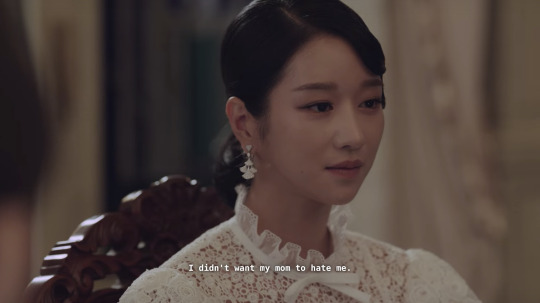
Would a child be afraid of their parent because they didn’t want to be hated? I was just afraid my mother would scold me (which was a lot). Right, we can argue that her mother was abusive, but this is something to think about.
Park Haengja: stepmother and crazy aunt
Bluebeard the French folklore, which ep 6 was based on, is about a man who married several times as he killed his disobedient wives. According to Wikipedia, his final wife had invited her sister and others over for a party before she snuck away to explore the forbidden room. Bluebeard found out and was about to kill her on the spot when her sister and brothers arrived to kill Bluebeard.
It was also in ep 6 when Taetae Bros moved in that they specifically had a shot of the dolls in Moonyoung’s old room (the brothers’ new room). I mentioned this previously: one male doll as Go Daehwan, two female dolls in similar dresses as Moonyoung’s mother and stepmother, and one small female doll.
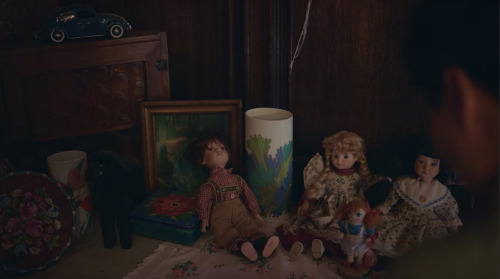
You can see the two dolls behind little Moonyoung in her memory of her father reading her a book.
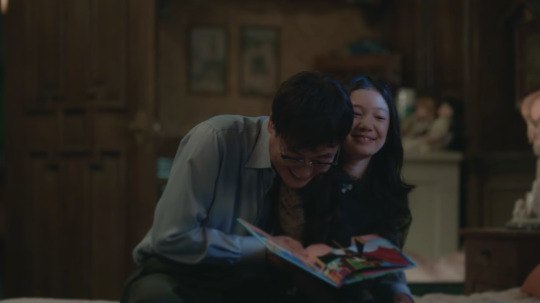
The dolls are a representation of the Go family in the house because in ep 7, only the small female doll (Moonyoung) was left, and I think there are 2 more new figurines as Taetae Bros on that cabinet but I can’t be bothered to search for a clearer shot 😁
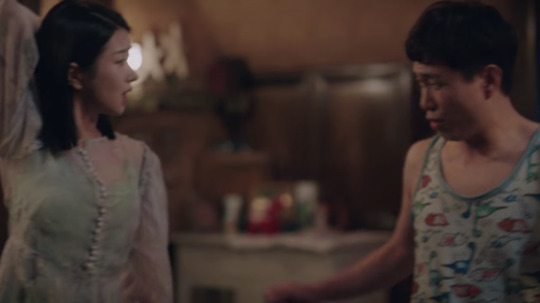
When Go Daehwan strangled little Moonyoung, afraid she would become like her mother, they featured one of the dolls in the shot.
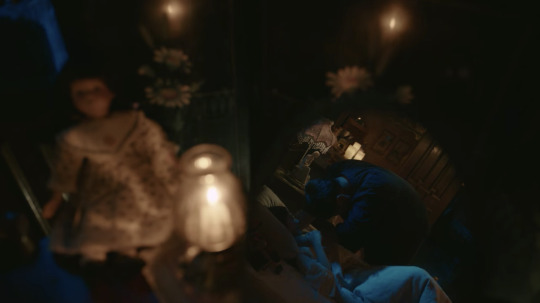
The point of mentioning the dolls is: Moonyoung’s mother wore a similar dress as the dolls in most of the flashbacks.
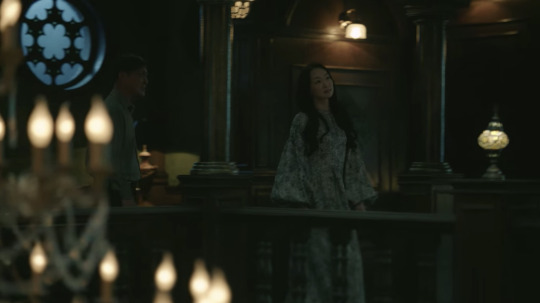
Ep 13 was based on the Korean folklore The Story of Janghwa and Hongryeon and its popular movie adaptation The Tale of Two Sisters (2003). IOTNBO has more links to this story than “the bystander is worse than the abuser.”
In the movie, Moon Geunyoung’s character frequently dressed in floral patterns (like the dolls’ and Moonyoung’s mother’s dresses).


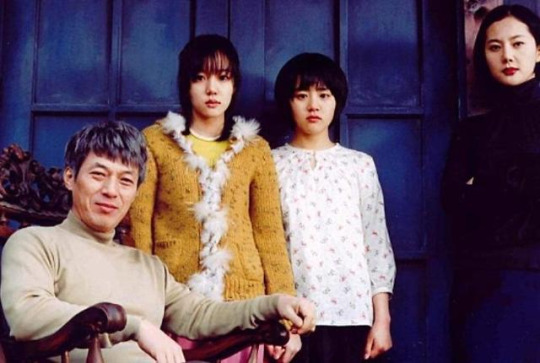
In both the folklore and the movie, the sisters were named after rose and lotus flowers. In the folklore, it’s the sister that died who was named after the rose flower. In the movie, it’s the surviving sister that was named after the rose flower. The rose is also a motif of Moonyoung’s mother.
The flower language of rose is love and passion. Personally, considering how Moonyoung always thought of her mother when she brushed her hair, and her love for a head pat, I think the rose also symbolises her mother’s "affection."
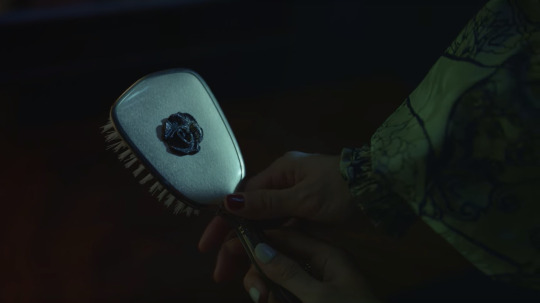
The movie is a story of two sisters who were abused by their stepmother so badly that one of them died. As it turns out, the remaining sister developed dissociative identity disorder (DID; the same disorder as the patient Yoo Sunhae) with two other personalities: her dead sister (Moon Geunyoung’s character) and her stepmother.
I take this as a lead that Moonyoung has a stepmother, who also happens to be her aunt obsessed with her sister. Wicked Witch of the West (WWOTW) coveted Wicked Witch of the East’s (WWOTE) ruby shoes; perhaps the aunt wanted to be in her sister’s shoes, figuratively AND literally.
Now here’s another “coincidence” from the same:
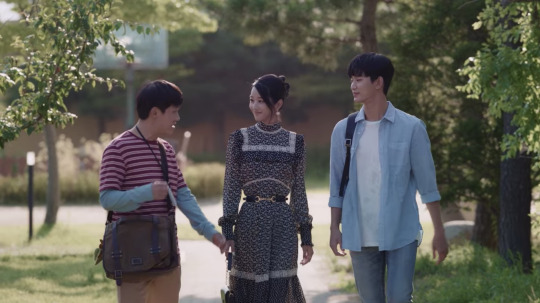

Left: Moon Geunyoung. Right: Im Soojung (sister with DID).
The story Go Daehwan read to little Moonyoung mentioned a bad wizard that wasn’t invited to the birthday party so he went to the castle.
The story Go Daehwan read to little Moonyoung mentioned a bad wizard that wasn’t invited to the birthday party so he/she went to the castle to cause trouble.
Glinda the Good Witch of the North described WWOTW as worse than WWOTE.
Go Daehwan, who had recognition and memory impairment, said his wife has an angelic face but a devil lives within. Perhaps he remembers two persons as one.
We learnt from Sangin that 1) Do Heejae came from a prestigious family of medical professionals, 2) she dropped out of 3rd year of med school, and 3) she cut ties with everyone in her family. Could she have a sister in nursing? Could she have cut ties with her family because they cray cray (or the good old "you’ll starve with a creative career")?
Park Haengja has not claimed herself as Do Heejae, and the woman in the family photos are still covered.
Following these, we can assume that Park Haengja’s the bad witch who is neither Do Heejae nor Moonyoung’s birth mother. She’s the stepmother and crazy aunt (I cover more about the sisters in the next section).
There’s always a crazy aunt or uncle.
It’s just too easy if Park Haengja really is Do Heejae. I’d also be disappointed in the writer if she takes this route because it’s cliché villain and this is not a makjang drama with illogical plot twists. It would also be a step back from all the efforts this show has been making to dispel stigma against mental illness.
So they were sisters and...
...one of them died. In water.
As per my first theory, the WWOTW and WWOTE are sisters in some adaptations of The Wonderful Wizard of Oz. WWOTE died under a house then disappeared into thin air, and WWOTW pretended to die in contact of water but she returned disguised as a good person. Sound familiar?
The Story of Janghwa and Hongryeon is a Korean folklore of a stepmother who abused two sisters to their death. She had her biological son push Janghwa the older sister into a pond and she drowned. The remaining sister couldn’t take the abuse any longer and drowned herself in the same pond.
The song “Oh My Darling Clementine” has a few variations but here’s the traditional lyrics (I removed repeated stanzas):
Oh my darling, oh my darling
Oh my darling, Clementine
You are lost and gone forever
Dreadful sorry, Clementine
In a cavern, in a canyon
Excavating for a mine
Dwelt a miner, forty-niner
And his daughter, Clementine
Light she was and like a fairy
And her shoes were number nine
Herring boxes, without topses
Sandals were for Clementine
Drove she ducklings to the water
Ev'ry morning just at nine
Hit her foot against a splinter
Fell into the foaming brine
Oh my darling, oh my darling
Oh my darling, Clementine
You are lost and gone forever
Dreadful sorry, Clementine
Ruby lips above the water
Blowing bubbles, soft and fine
But, alas, I was no swimmer
So I lost my Clementine
How I missed her! How I missed her
How I missed my Clementine
But I kissed her little sister
I forgot my Clementine
These stories are all about 2 sisters and dying in water. Whether they’re sisters or not, a woman died and she’s related to Go Daehwan somehow.
The Murder of the Witch of the West
Do Heejae’s novel hold huge clues. Here’s my translation of an excerpt from volume 9 shown in ep 10.
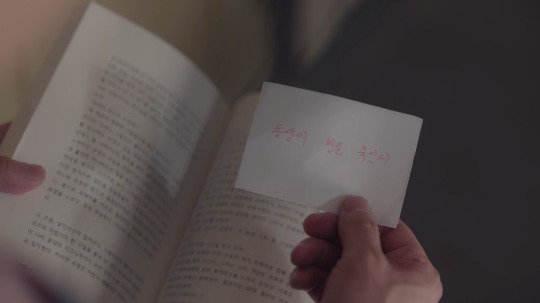
… __’s scalp skinned with a hunting knife without hesitation. The corpse’s lips sewed in a fence stitch. The body dismembered with a hand axe and thrown into the trunk. Yooyoung persistently as she watched the back of the West Witch leave unhurriedly after finishing the killing and leaving notes.
"Who the hell are you?"
"Why do you choose to kill happy people only?"
But as usual, there was no answer. Was it because of Yooyoung’s tenacity to catch the West Witch? Yooyoung always sees the West Witch at the crime scenes. A faceless woman who always observed Yooyoung work hard on finding the criminal before leaving abruptly. Yooyoung began to look at the crime scene from the criminal's perspective. Why here? Why kill by stabbing this way? As she simulates the crime, Yooyoung finds herself assimilating with the criminal. She felt a thrill from imagining that she stabbed and cut the victim. She’s getting confused. Is she a detective or a murderer?
Around the same time, a murder occurred. The West Witch mimicked a passage from The Wonderful Wizard of Oz, everything was in line with the Wicked Witch of the West, right down to the signature butterfly design. However, Yooyoung somehow felt guilty.
...
The suspect was a middle-aged woman in her 40s.
Yeah.
The misunderstanding
Othello killed his wife because he mistook his wife for committing adultery.
Romeo and Juliet mistook each other’s plan. Romeo died from drinking real poison, and Juliet faked her death before realising the mistake and killed herself with Romeo’s dagger.
Janghwa was framed and wrongfully accused by her stepmother for being unchaste. Her father believed it. When Janghwa ran away, her stepmother and stepbrother chased after her, and her stepbrother (under her stepmother’s instruction) pushed her into a pond to drown to her death.
What did Go Daehwan misunderstand? What misunderstanding did his recognition and memory impairment cause? Why was his wife being crazy but looked so shocked when he turned her around?
I do not believe that his memory of killing his wife is a complete memory because it has been mentioned multiple times that his memories are corrupted. I think it’s fragments of different memories pieced together.

What’s going on with Park Haengja?
There are a few possibilities.
Park Haengja is Do Heejae’s sister who coveted her sister’s position and grew obsessed with her sister’s novel.
Do Heejae’s Moonyoung’s biological mother and Park Haengja’s her stepmother.
OR Moonyoung’s biological mother died when she was born, Do Heejae’s the stepmother (abusive but still her mother because she raised Moonyoung), and Park Haengja’s the obsessive aunt.
She got so obsessed she came to believe she’s Do Heejae.
So obsessed she was always keeping an eye on Moonyoung to fulfil the prophecy that is the novel. ("You’re my greatest creation," and volume 3, shown in episode 10 with Park Ok Ran’s copy, has passages that describes episode 3.)
Park Haengja’s the one who killed Taetae Bros’ mother (screenshots of Do Heejae vs murderer below).
She took advantage of Go Daehwan’s cognitive impairment and instigated him to kill the real Do Heejae. She’s the one who saw Go Daehwan kill the woman and hide her in the basement.
Do Heejae wore her butterfly brooch on right, the murderer wore it on the left. Do Heejae always wore red nail polish and a gold rose ring, the murderer did not (although she could have had them removed if it’s premeditated).
Moonyoung’s mother:

Murderer:
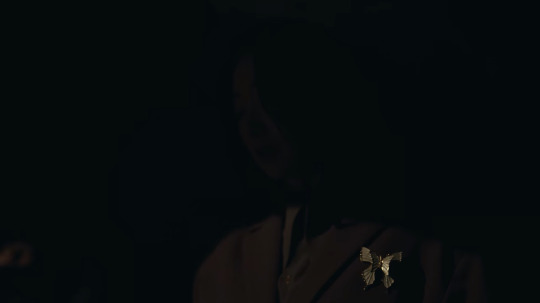
Moonyoung’s mother:
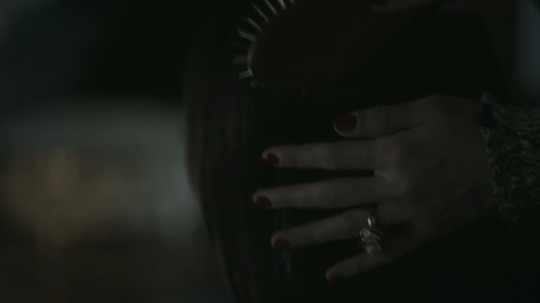
Murderer:
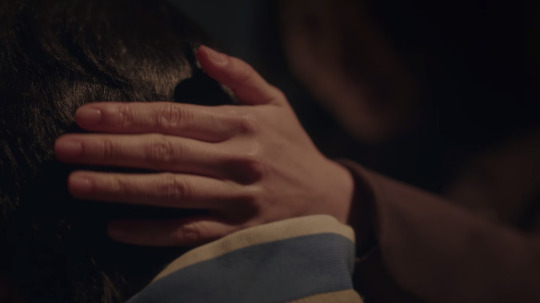
Clearly Do Heejae didn’t wear her brooch all the time, so it would have been easy to steal the brooch. However, Do Heejae wore her ring all the time, so Park Haengja can only get the ring after she dies and "truly” become Do Heejae.


End.
I think I recovered most of my points but they’re still feel incomplete 😭
Let me know your thoughts 😊
#psycho but it's okay#it's okay to not be okay#kdrama#kim soohyun#seo yeji#oh jungse#jang young nam#i just refuse to believe she's do heejae#that's too simple for this drama
68 notes
·
View notes
Text
I was going to release this as a long video essay but devices and software had conspired against me and eventually drained my patience, so here it is in the written form. My magnum opus. My 15 pages long analysis of the three Infinity Train seasons currently out.
1. Introduction
So for starters, I watched Infinity Train way too late, only a few weeks before the release of Book 3. And it immediately gave me MANY many thoughts, head full... Needless to say, when the first 5 episodes of Book 3 were released I was HYPED. So hyped that, being on a vacation out in the countryside, with better connection only availble upon climbing a nearby hill, I made some. sacrifices. To get there after dark, when everyone else was sound asleep.
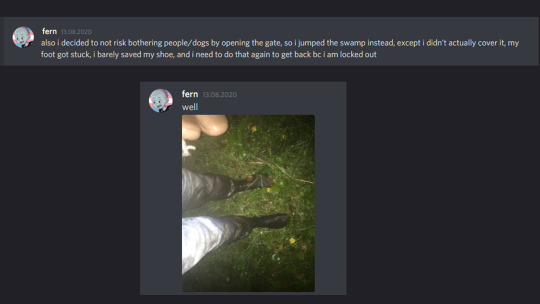
[id: two screenshots of separate discord messages by someone with a handle “fern”, one reading “ also i decided to not risk bothering people/dogs by opening the gate, so i jumped the swamp instead, except i didn’t actually cover it, my foot got stuck, i barely saved my shoe, and i need to do that again to get back bc i am locked out”, another reading “well” with a photo of a person’s legs covered in black dirst from feet to knees. end id]
And by the rules of friendly bullying, I am now destined to have that night haunt me forever. Naturally.

[id:discord chat search results for the word ”swamp” (38 results found), cropped so that a part of one message is readable, saying “... KNOW it was the SWAMP that embraced ME, not the other way around”, another (by someone with a handle “Fleur” saying “you already DID embrace a swamp”. end id]

[id: a message from the same person saying “he asks ‘how was your swamp’”. end id]

[id: a message from the same person saying “big words coming from mx. soggy feet” with an angry red overlay. end id]
And, well. The first two Books had left me with a sense of assuredness, the underlying motif of them appearing empowering and infinitely comforting, and I was excited to get another supporting pillar in season 3. Another story to turn to in time of need to remind me that I have the power to make my life a better one, that it is never too late to make something of where I am. And, well, it's not that Book 3 didn't continue the topic of personal choice and growth, but the story it told added... let's say, more weight to the idea of personal development.
That is perhaps only natural: narratives need to grow, to develop, to take the themes explored in them further, deeper with every coil of the spiral. And a more, grave, exploration of them will only bring them closer to life. But in the aftermath of Book 3 I had to deal with a certain sense of powerlessness, not being able to fit it into a neat system, put it on a shelf in a shiny frame of witty analysis and call it a day. But, quite ironically, I believe that this exact feeling of unending change and death of comfort is the exact thing the show wants us to get comfortable with. And that's what I want to talk about here. Infinity Train's core narrative of an individual versus the wrold, individual versus change. The very concept of personhood, the relationship between the person and their environment and the way to approach it that is shown as perhaps the most productive.
I’ll start with my Many Thoughts on the first two books to explain what I thought was the underlying message of both of them.
2. Book 1: The Perennial Child and the Unproducitve Protagonist Complex
Book 1 establishes the core elements of the narrative wonderfully, the writing is smooth, effortless, beautiful and takes you on a wonderul, deeply impactful and bittersweet emotional ride. We have Tulip, The Perennial Child herself, who has to renegotiate her relationship with the world, with life, change, and other people's power to bring said change. Tulip is also to learn true connection and make peace with its price.
The narrower narrative of a story centered around a divorce is a perfect gateway into a broader one, so let's explore the specifics of the foremer first. Tulip's mindset is the mindset of a child from a dysfunctional family. The notion of blame is very strong in her perception of the world. On one hand, she sufferes from a misplaced sense of responsibility for the way things are, as she admits in her conversation with One One. That is the most natural for someone who grew up in an unstable environment, with parents whose relationship was not harmonic and healthy. A child caught in the middle of adults' anger and argumments internalizes that anger and those arguments as something having to do with them. And that's what we see Tulip go through, with her having to listen to her parents fight because of her needs.
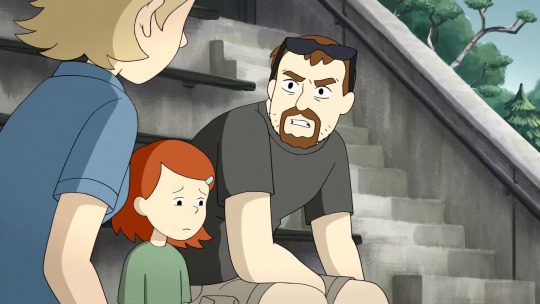
[id: a screenshot from Infinity Train Book 1 showing younger Tulip, a read-headed girl, sitting between her two parents upset as her father is telling something to her mother angrily. end id]
Tulip also has to step in as a caregiver to a suffering adult, tucking her dad in at night; the dialogue emphasizes that their usual roles are being reversed in that situation. Growing up in the middle of constant conflicts, having to provide care and comfort and stability to someone who was supposed to take care of her, had naturally resulted in a deeply ingrained painful perception that Tulip is the one responsible for her environment, is the one to blame when it is “broken”, and is the one who should step up and fix it, make it right.
Then, on the other hand, there is the notion of blame Tulip puts on others, specifically her parents. Here, we see the same mindset but reversed: Tulip feels caught in the middle of their divorce and demands that they make it right, make it work, for her sake. She needs her family, she needs stability, she needs her parents to work out their schedules, she needs to get to the game design camp. And she is prone to seeing her parents as people who are cruelly destroying her life and her family for no apparent reason.
I am not calling her entitled, of course; ideally, stability is exactly what parents need to provide their children with. That is their mission. And when they fail, it is more than natural for children to feel hurt and betrayed. In a way, they are. Tulip's agony over her parents' divorce is never mocked nor undermined in the show, either; it is shown with the deepest compassion. So this is not so much about calling her feeligns invalid, but about looking for ways to redefine the situation in a way that would help Tulip heal. The way out of her agony seems to be to abandon the mindset that puts her at the center of her family life – and at the center of the world, in general. Things are not that simple; people have reasons for behaving the way that they do outside of how it affects her; and avoiding and rejecting that truth hurts her, first and foremost. Feeling like the center of the universe isn't so much selfish or arrogant or toxic; it's just painful, and Tulip needs to step out of it, for her own sake.
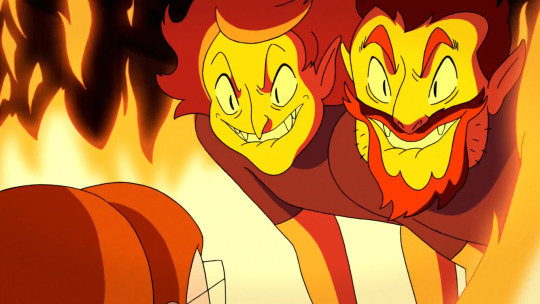
[id: screenshot from Infinity Train Book 1 showing the two adults from before, Tulip’s parents, with exaggerated demonic features, surrounded by flames. end id]
An important thing to discuss is that the notion of “blame” can only exist if there is indeed something wrong with the world. Let's go back to Tulip's defining conversation with One One, in which she gets to say some incredibly important words: “It's not your fault the car is this way.There isn't a fault, it just is.”. “No fault” can mean “no one to blame” as much as “there is actually nothing wrong with the world”. The words “It just is” carry this simple and raw reality check that forces us to accept the way things are, with no emotional withdrawal or avoidance of it.
The world simply is the way it is, and even if the way it is hurts us, it doesn't mean that what hurts us is wrong.
I would like to suggest that the Unfinished Car itself, the residents of which continue adapting to their unconventional reality and genuinely thriving in it through acceptance and flexibility, are here to emphasize that. We may not like the way things are, but that doesn't mean we should go looking for someone to blame and force to “fix” them, be out ourselves and others. We shouldn't ferociously attack what hurts us with wrenches, kicking and screaming and tyring to get it to Work Already. Sometimes the only thing we can do is to accept the reality of it, let go, and see what we ourselves can do to feel happy and content in the present circumstances.
Making peace with the way the world is, renouncing responsibility for it outside of her personal decisions, is exactly what Tulip gets to learn on the train. Being half-abducted by it during a time when Amelia has taken over and no one is there to give a nice welcoming message with specific instructions, Tulip is deeply distraught by the mysteries surrounding her, and infinitely frustrated by her seeming inability to 'logic' her way through the challenges. She boards the train as a girl whose main need is to create a semblance of control over her environment, through understanding it.

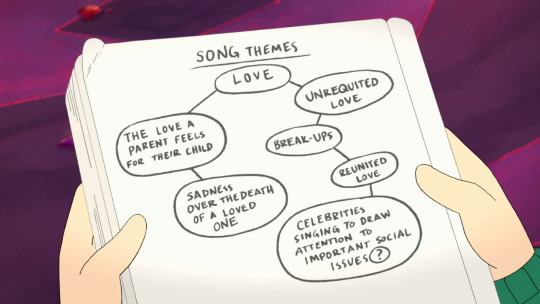
[id: two shots of Tulip’s sketchbook where she is tryng to figure out train’s puzzles. end id]
She is at the center of the universe, she is responsible for the way things are, and it is up to her to figure them out.
That is a lone, individualistic journey of a single person who only wants to deal with their own life, their own problems, and Tulip does not welcome any companions at the beginnig of it. It makes sense for her to seek solitude: she feels overwhelmingly responsible for her own little personal world, just how unbearable would it be to let it merge with other people's lives, for her to suddenly be at fault when those she cares about are hurt? Not to mention that new people are new unknowns, new factors that can make her life harder, more confusing and painful. For a person stuck in her desperate desire for control, it makes a lot of sense to prefer to deal with her problems on her own and expect others to do the same.
Meeting One One, who is the first to care, and Atticus, who is there to dispense his pearls of wisdom about the resources we find in each other, the value of friendship and its ultimate worth in the face of responsibility and risk of loss that comes with it, is what helps Tulip find comfort and humility in her relationship with others. She is simply one of the many people influencing each other's lives; she is not at the center, not at fault for the pain that comes to others, even if they were hurt through their association with her; it was their chocie to lend her a hand or a paw, and they had the right to make that choice.
Similar humility of being just one of the many is found in Tulip's relationship with the world at large, too, shown through her relationship with the train. First, she is frustrated and impatient, trying to figure out the most rational logical way to proceed in her attempts to control what happens to her next. Then, as she finds joy and connection, things become easier, she finds a rhythm that works for her, as seen at the start of “The Ball Pit Car”. And then soon after that, in swoops Amelia, ready to wreck havoc and quench Tulip's progress by trying to kill one of her friends and turning the other into a monster, and pinning it all on her.
Losing Atticus is far too big of a blow, and so Tulip gives up her lessons and falls into fatalism, feeling like she has no control over her fate, like she will never be allowed to make it off the train.
But the core component of Tulip's character is her ability to “bounce back”. She loses her progress quite tangibly, with the number going up – and yet reverses that development rapidly, when she gives it all another try and subsequently learns the truth about Amelia. Finding out that the current self-appointed conductor who has been terrorizing cars and threatening Tulip and her friends is just a person, Tulip asks a very important quesiton: “What's stopping me from doing what she did?”. She stops interpreting her surroundings as alien, hostile and created to act against her, in weird incomprehensible ways that seem to be mocking her attempts to find a shred of logic to them. Instead, she takes full control of her own actions and starts using her environment to her own benefits, much like Amelia did. But Tulip takes it a step further and approaches it in a healthier fashion. Where Amelia is desperately trying to make the world do her bidding, Tulip states a simple objecitve: help her friend, - and looks at her options.
Tulip steps into her power when she realizes her choices and actions matter and have full weight. That restores her faith into being able to help Atticus. She cannot control her surroundings fully, she cannot control how other people behave, and trying to make herself responsible for it is unfair to herself and others and hurts everyone. She can, however, make her own choices and use her own skills to strive to perserve what is important to her.
Once again, that mindset is directily opposed to Amelia's. In Book 1, Amelia is stuck in the constant attempts to recreate her life, to change the world around her, to bend her environment to her will instead of growing internally, accepting the change and adapting to it, taking responsibility for her own feelings and not for what surrounds her. The key motivation in the prison she has created for herself is grief. Unwilling to let go of the world she once shared with someone she loved, not wanting to accept the passing of something that was incredibly important to her, Amelia stagnates, rejects the thought of progress, of healing, of moving on. To start to get over such a loss is to create distance between yourself and what you are mourning. When you move on, you leave it futher and furher behind with each step. And so Amelia decides to stay exactly where she is: in the depth of soul-shattering suffering. Symbolically, she never even leaves the pod she was delivered to the train in, stays at the very beginning of her recovery journey, turns her pain into her armor until forcefully broken out of it by Tulip.
The two characters are perfect for each other as counterforces; even more so, the very environment that Amelia has created, the one that frustrates Tulip with all the unanswered questions and mysteries, is the exact one that would motivate this girl to grow. This is something to keep in mind when approaching Infinity Train's narrative: Amelia is a perfect antognist to Tulip, and it is through encountering her that Tulip grows. Amelia's mistakes result in Tulip's progress.
A key moment in the two characters' confrontation is Amelia's offer to give Tulip a car of her own, where her and her family can be pitcture-perfect and happy in the exact way Tulip wants them to be. By that point in the narrative Tulip has already had to face the truth of her family situation, the reality of it, it not being anyone's fault nor her parents' whim, sad things simply just happening for reasons outside of anyone's control. And with Amelia's offer, she has to come painfully close to the truth that she has just started making peace with once again. She has to really internalize the fact that her real parents were not happy together, and wouldn't be happy in this simulated reality; and if they were, they would not truly be the people she knows.
Tulip acknowledges the painful and beautiful truth of life: if you want to be surrounded by real people you can love, people that can love you, you need to give them the freedom to live their lives, freedom to hurt you, to walk away, to change the life you share, to have their own personal feelings that might be different from the ones you wish they had. They need to have freedom to make choices. It is scary, and it hurts, but that is the only way to have something real. While Amelia is obsessed with molding her environment in the image of her perfect life, and failing miserably, Tulip realizes that to reunite with her parents she needs to accept that, as long as they are in her life, things can change between them; and that is okay. That is the only way love can exist. With the risk of loss and pain, not any less worth it for that.
At the end of her journey, Tulip has learned the nature and price of connection, and her place in the complicated, irrational, incomprehensible world. She gets to accept that things don't need a reason for happening, that there is not always someone to blame and demand reparations from. She gets to accept that she is just one person - but that realization gives her so much personal power. As just one person, she is free from the weight of the world she used to carry on her shoulders; as just one person, she has the full scope of her personal skills and power to protect herself and those she loves, to change with the world and adapt to it, once she starts treating it as a friend and engaging with it on its own terms. At the end of her arc, she truly gets to say that she is ready for everything: she learns a whole new way to approach life that makes handling change much less painful.
She is a protagonist that gives up the protagonist complex, telling her she is the central point of the larger narrative. And through that, she finds peace and flexibility.
What is fascinating is that the narrative itself then supports that idea by removing Tulip from the center of the show. In the next book we follow the arc of Lake, my beautiful perfect child. And with it being centered around the idea of Lake's personhood and them transcending the role of a denizen, that decision could not have been any more metatextually perfect.
3. Book 2: Cracked Reflection and the Relationship between Personhood and Connection
In the first season, Lake is a side character that appears for just one episode, contributes to the protagonist's journey and is then gone. But as the story shifts and focuses on them, we see their struggle as they try to break out of the role of a 'supporting character' and prove their completion and worth outside of their contribution to someone else's story. Their intial place in the narrative and their initial position within their own story echo each other beautifully, and this is the exact kind of writing excellency that has me absolutely hooked. Thank you Infinity Train.
Quite interestingly, the idea of personhood is explored in relation to the theme of connection. Lake shares their journey with Jesse, and the two character arcs mirror each other, dealing with the relationship between personal freedom and external bonds.
Lake and Jesse operate under the same false pretense that to connect to people means to be what they want you to be, that in order to have friends you have to sacrifice who you are, what you want. They approach this false predicament from the opposite ends: Lake by avoiding any connection altogether and Jesse by readily caving in to peer pressure, adult pressure, just... general imposion of everyone else's expectations, because he suffers from the compulsive need to be liked and accepted. Lake refuses to fit in and is left to deal with their horrifying situation alone, Jesse hurts himself and those he loves in order to fit in.
It's very interesting how the narrative connects reflectiveness to connection. 'Empathy Goes', the song about friendship that Jesse sings, starts with lines “When I look at you, I see me” – words that take on a quite literal uncomfortable meaning for Lake.
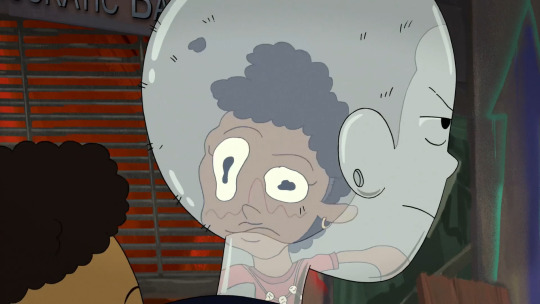
[id: a screenshot from Infinity Train Book 2 of a small girl looking at her reflection in a reflective child (Lake)’s head, Lake unamused. end id]
Then the thematic core of season 2 – Lake's conversation with the dying Sieve, in which the latter torments them – introduces the thought that, by befriending Jesse and helping him grow, Lake became what he needed them to be; became his reflection.
That is, of course, not true. The idea that Lake had simply fulfilled the role of a denizen is disproven by the fact that they are the protagonist of Book 2 that goes through the same journey as Tulip, meeting the exact people and creatures and foes that influence and challenge them in the most important ways. At the end of the day, their victory was not changing their external circumstances but their internal approach to them.
As this awesome person has pointed out, that to get off the train, Lake had to embrace their reflectiveness. However heartbreaking was their enraged plea to have their personhood recognized, they never really did change One One's mind. In his perception, they remained a denizen, “so good at helping”.
The truth is, however, is that yes, Lake has helped Jesse - by being themselves unapologetically, by not fitting in, by showing him that that is an option, and in that life, you can still be loved and cared about – because Jesse without doubt cares about Lake very deeply.
But Jesse has helped Lake, too, has changed them – by giving them connection and recognition, by showing them they can be accepted and loved without the need to change who they are, without the need to tailor themselves to another person and 'mirror' them. At the end, the two get one escape for two people – because their journey was a shared one, because their paths cannot be separated, because they have influenced each other equally.
And much like Amelia was the perfect person to challenge Tulip, One One with his inability to think outside of the algorythm and acknowledge Lake's personhood, was perfect for challenging them and putting them into a situation where they had no other choice but to accept, acknowledge and appreciate the connections they have made, and the fact that those connections define them - partially.
Reflectiveness represents bonds, letting other people into your life, letting them influence you, teach you something, ask something from you – and, fascinatingly, that seems to be a part of what defines us, gives us personhood. Are we just what we do for other people? No, obviously not. Are we simply what separates us from others, what makes us unique, who we are completely on our own, with no regard to what unites us with other people, what they bring into our lives and what we bring into theirs? The answer Infinity Train provides appears to be no, once again.
Lake names themselves – finds a true, real name that they identify with, when they embrace their reflective nature and see themselves in a body of water that, yes, lets the world in, reflects it, while also undoubtedly having a life and depth of its own. Personhood, real, full human experience seems to be the subtle dance of individualism and connection, both what defines us as separate from others and what tethers us to them.
I mentioned how Lake's journey being similar to Tulip's is a part of what validates their personhood. That's one of those fascinating things in Infinity Train's writing: how the intial split of the cast into the passenger and supporting denizen characters appears almost like commentary on the protagonist complex, with Tulip actually having to internalize the idea that the world and her life are not centered solely around her, are not all about her happiness and growth, that some things happen just because they do, not because they have something to do with her.
Then, opening with a lead that needs to outgrow the protagonist complex, the show moves on to that character's narrative foil and shows them grow into the central point of the narrative, fighting to have the world recognize them as the main character of their separate, independent story. And to us viewers there is no doubt that Lake is a person of their own and has full rights to personal protagonism – they are the one we are watching, whose struggle is the focus of the Book, they are who we sympathise with in the story.
This wonderful meta decision really drills in the idea that every single character we only ever catch a glimpse of is the main hero of their own journey, and has a full life and full personhood outside of the role they play in the story we watch unravel. At the same time, as per the rules of narrating, we only see the people and events that serve the current protagonist's growth. Through that, and through being an antalogy that unravels by latching onto a secondary character time after time, book after book, exploring their own journeys and inner worlds, Infinity Train creates a breathtaking polycentric model of reality, in which every single person is the main character on their own path, with people around them contributing something of value to that path – and the main character contributing something to theirs, becoming in turn a secondary supporting character in someone else's story.
Tulip and Atticus are a wonderful example of that: embarking (hehe) on the same journey for different reasons, helping each other, accepting the responsibility that comes with being each other's friends and companions, welcoming the pain that comes with connection and at the end aiding each other in their quests. And Jesse and Lake are much the same.
The idea of companionship being the escape is only directly introduced in Book 2, but it had already sprouted in Book 1. The themes of connection, renegotiating one's relationship with the seemingly hostile world, and coming to terms with everyone's place in it as one of the many, but having endless personal power over our own narrative, are constantly and continuously present in the show, with the differnet smaller plots and character arcs beautifully overlapping.
___________________________________________________________
Analyzing all of this in the past, I felt incredibly secure and confident in the seeming underlying lesson. That there is no reason to fight the world at large, the things that are outside of your or someone else's control. And that doesn't mean “not standing up to those who are hurting others”, as shown in Tulip's confrontation with Amelia, Jesse's confrontation with the Apex. It means that some things, like where you have come from, what the relationships of people around you are, and who you have lost, cannot be changed, and our subconscious attempts to fight them only hurt us in the end.
The idea of our boundless ability to find resources in ourselves and people around us, learn from people that surround us, accept their help and offer them ours, find love once we accept the change love brings; the idea that we always have the ability to thrive in our current circumstances, once we accept that we ourselves are getting in our own way, out of the unwillingness to let go of something we hold dear; the idea that we can always, always bounce back, that it is never too late for any of us, and that true companionship will always be there to give us escape...
The idea of the world as our friend, with its own will and wishes, something that is not to be controlled and bruteforce- reasoned through, but something to engage with...
These all gave me strength, held me up, and gave me a new paradigm that allowed me to look at the reality from a place of comfort and assuredness. The paradigm of the complicated web of life where everything is in its place, where our shortcomings create valuable lessons for someone else, where our choices, even if they hurt us and others, create lessons, as established by Sieve, have their place in the big picture, like what we see with Amelia's mitakes and Tulip's progress.
Then, the idea that in that big picture, you are exactly where you need to be, always, because you always have the only thing you need to grow and recover and thrive – you have yourself and the people around you. How infinitely comforting this is, how solid.
And then Book 3 has arrived. And holy shit y’all.
4. Book 3: Cult of the Conductor and Trust vs Control
And once again, this season has not necessarily disproven all of the aforementioned stuff, just... put a lot more emphasis on the reality of pain people have to endure. In this book we had to witness simultaneously a recovery – within Grace's arc, - a descend – within Simon's, - and an actual, raw trauma, that Hazel had to suffer through on screen. We had to watch Simon murder Hazel's caregiver and repeatedly make her feel unsafe, and Grace withdraw herself and leave Hazel alone because of her ungoing identity crisis. We have to come uncomfortably close to the reality of the pain that shapes people, and with how horribly we all can hurt each other. That pain is no longer obscured by the passage of time, it's not something in the character's past. And that is... very rattling.
But, once again, the constant running themes and motifs remain. Once again, the show tackles the idea of change, of connection and the relationship between the individual and the world.
Regarding the latter, what we see with the Apex is the protagonist complex projected on a group. The Apex myth simultaneously places them at the top of the world – hence the name – and makes them the poor victims of the evil False Conductor that of course seeks to destroy them and targets them specifically. Grace and Simon developed the idea of themselves and their group as the sole people for whom the train exists, as well as the chosen deliberate targets of the entity that had taken over their environment, instead of accepting that maybe the world does not revolve around them!
Upon meeting Amelia they learn that they are not chosen, that they are not on the train because the outside world did not recognize their value, that there was never someone at the top who had their best needs in mind, and that the entity that calls the shots now does not actually know anything about them besides the fact that they exist.
The theme of connection makes a comeback hand in hand with the motif of empathy, with the book opening with Jesse's song 'Empathy Goes'. And that's what's being explored in Grace's and Simon's respective arcs with relation to denizens: their ability to show compassion and recognize someone else's personhood.
The narrative is multi-layered here. On one hand, what is being explored is a group mentality, a cult mentality that paints the outside world as simultaneously inferior and hostile, and we can see Grace and Simon accidentally inventing some pretty mean propaganda techniques. Whew, those kids. But then on the other, the idea of denizens as projections, 'nulls', incapable of actual feeling, only pretending to be real people... this brings to mind such complicated and staggering concepts as philosophical zombies or the idea of the world as something that is simply a projection of your, you currently reading thinking person, brain, where nothing is real except for your own consciousness. And since it is simply impossible to possess others and make sure they are indeed living breathing feeling creatures and not just NPCs in one wild, wild dream, empathy becomes a fascinating choice. What we're left with is 1) believing that other people do in fact feel what they say they do, 2) treating them with respect just in case or because being mean feels bad, or, 3) you know, deciding that we're on top of the world, and are the Apex predator, and everything exists for us, and we can do whatever we want with people around us.
It's interesting to see this mindset as a group mentality, but it makes sense, too; with the Apex we get to watch what happens when a group only recognizes the personhood of those that are a part of it. The thing is, there is no actual empathy within that group, either; we see that once Grace stops fitting into it as smoothly. To the Apex, she becomes a 'void', a nothing, something hollow, devoid of status and power and therefore rights and feelings that need to be respected. Simon's approach is “whatever I do not like is not real”, so by proxy, the new version of Grace is nothing, and should be erased.
This lack of empathy can be tracked deeper and deeper down to Simon as the extremely tyrannical leader, his refusal to recognize the personhood of anyone who does not agree with him. It is natural for us all to act as if what we believe is correct; otherwise, why would we believe it? But Simon takes it to the extremes, refusing to even for a second consider an alternative point of view, and ends up locked in a mindset in which he is the only person entitled to the ability to see the truth, and everyone else somehow is inferior and incomplete. That's the protagonist complex, that's the experience of a person who considers themselves at the center of the world. Why would he out of all people be the keeper of truth? He simply does not ask himself that, because he does not stop to think about the existence of others, or their experiences.
However, it wouldn't be correct to say that Simon is completely devoid of empathy. It's just that his version of it is extremely self-centered and unable to discern between his personal situation and someone else's reality. As my awesome friend @buttercup-bug has pointed out, the relationship between Grace and Hazel and Simon and Hazel is built on extending that limited, conditional empathy. As they have noted, the golden and silver masks at the start of the season that are performing the song 'Empathy Goes' represent the two of them, the golden one directly intersecting with the one Grace wears, and in general gold and silver matching their color schemes.
The position of the masks matches their position on the stage, as well: they are the two leading figures in the big messed-up play that is the Apex, removed from reality, avoiding it, living in their own little world. They perform that reality in different ways, Grace leading with smiles and emotions/emotional manipulation, Simon being more uptight and serious.


[id: two shots from Infinity Train Book 3, showinng first a scene with halves of two theatrical masks, a sorrowful and a laughing one, surrounded by undefined actor creatures; then Simon and Grace, two young people, Simon white and blonde, Grace black, with shortr dredlocs, wearing a golden masks, holding hands with each other and two other kids in a curtain call manner, with fire raging behind them. end id]
Now, returning to the empathy motif: as it was pointed out to me, the two extend their empathy to Hazel in their own ways, representing their relationship with the inner child. Grace relates to Hazel as a lonely young girl seeking connection with other children, and engages with her in a fun, upbeat way, making it so they enjoy each other's company and spend time together like friends do. That helps her get closer to Hazel, get genuinely attached and through that let Hazel influence her worldview a bit, and be there for Hazel through harder, less fun things as well, till.. a certain point.
Simon, on the other hand, sees himself in Hazel as someone stranded on the train and under the care of a denizen, and automatically perceives Tuba as a threat. And he expresses his empathy in a direct, serious, violent way, by doing what he thinks needs doing: by getting rid of Tuba without making time for smiles and fun times.
Grace is the leader, she engages with people emotionally, making them feel needed and special and through that keeping the group together. Simon is the general who leads the army in what he perceives as the Apex's attempt to protect themselves. His approach does not leave much space for bodning. And it makes sense for him as someone much more focused on safety to have his understanding of denizens as dangerous run deeper, be more at the forefront, in his focus. He’s the one calculating the “danger levels” of encountered denizens. And of course the incident with The Cat makes it much more personal.
I think it's fair to assume that both Grace and Simon must've had some unfortunate run-ins with the inhabitants of the train, with Grace being initially so set in her belief that denizens are dangerous because they are unpredictable, and you never know what they will do next. Though the only time we actually see her endangered is by the steward that Amelia had reprogrammed. Either way, the two had started off feeling endangered by the unpredictable and unreliable creatures surrounding them, and probably, in their attempts to find a reason to trust each other and feel safer around each other in a dangerous and confusing world, decided that passengers must be inherently good, denizens must be inherently bad.
There is, however, no actual trust in that, none at all between them.
I'd say that “trust”' is the core motif of season 3. Infinity Train tends to adopt an aphorism that keeps reappearing throughout a season, pronounced by different characters or in different contexts, highlighting the thematic movement and change and the development of the theme within the plot. In Book 1, it was the collocation “bounce back”, as the core of Tulip's character. In Book 2, we had “You can't spell 'escape' without 'companionship'”. In Book 3, our boy Roy introduced the phrase “Teamwork starts with two people trusting each other”. Simon's horrifying rendition of it emphasized the idea that not everyone counts as a person, so not everyone is deserving of trust. You can only rely on those who fit your narrow criteria of one.
However, even when Grace and Simon were on the same side of the barricades they've built with their own hands, they could never actually trust each other. Their bond and their care for each other were extremely conditional, hinging on the ultra specific image of a passenger, and influenced by the power hierarchy they had created.
We see that Grace is reluctant to trust Simon or the Apex with the changes happening to her, with her number going down, because she didn't want them to think “less of her”. Her personal issues, her fear of loneliness and abandonment and the idea that she needs to be something specific, someone who is always strong and right for people to stick around her, have certainly played into that. Grace is so used to comforting herself through saying the world is mean to her because she is special; she wears her “special” status as a mask, she has the highest number, she is “so good at the train”, and that's what keeps others around her in this reality, keeps them needing her. But it's not actually about her as a person. But it is also just the system the two have established. Numbers are power; one's number going down is their failure.
The amount of trust only diminishes as the plot progresses, with Grace's perspective shifting but her not being able to trust Simon with those thoughts and feelings – quite understandably, since he remained adamant about his beliefs till the very end. Grace could never truly trust Simon outside of the invented value system they've been existing within for many years. And that is reflective of her constant inner struggle, not being able to trust anyone with her self, without any myth explaining why she is awesome and irreplacable. Hazel was the first person who spent time around Grace while also falling out of the equation, not being influenced by the Apex propaganda, and that is why their bond was so life-changing to Grace – aside from the aforementioned grounds for empathy.
Now, was Simon ever able to truly trust Grace? I think he desperately needed to, and facing the fact that Grace has in some ways betrayed that trust by keepings things from him was one of the things that played into him going off the rails. (...That pun was not intended. )
As it was pointed out many times by many viewers, Simon seems to know quite a lot about funerals, which means that he probably had to attend one as a kid. Then, his relationship with The Cat seems to be a metaphor for neglectful parenting due to an addiction. The Cat is a collector, her treasures seeming to be extremely important to her. The voice in which Simon says the words “She is collecting again” hints on a long, ongoing problem. Then in the memory of his meeting with Grace, we see that The Cat had actually probably endangered him on one of her car crawls. Overall, Simon's childhood seems to had been an extremely unstable one, with nothing and no one he could truly rely on, with parental figures either dying or neglecting him. It is similar to Tulip's struggle, but most likely running even deeper.
We see Simon continuously leaning on Grace, which at times causes her frustration: she snaps and asks bitterly if she always has to tell him what to do. When Grace starts behaving weirdly, starts changing, acting in a way that Simon can't understand and is not used to, he probably feels endangered, like his life is growing incomprehensible and unstable once again, like things are slipping through his fingers and out of his control.
But at the end of the day, not one of them was truly relying on the other. Grace never trusted Simon to just stick around because he liked her, she needed the upper hand, the leading position, the idea of being “very good at the train”, and the system in which they should stick together as the passengers threatened by the dangerous environment and “the false conductor”. Simon never truly trusted Grace as we should trust those we love: with the freedom for them to grow and change and still remain someone we can feel safe and happy around. Instead of taking that leap of faith and relying on her to do right by him, he was in fact leaning on the system they've created, clinging to it desperately to the very end. People may change, but the system will stay the same, as long as he doesn't reconsider his worldview, and he had decided to never abandon it, whatever happens.
The lack of trust is warranted by their treatment of each other. How could Simon rely on Grace if she had never shown him her true self? How could Grace trust Simon with her genuine self if he needed her to be something very specific and unchanging? Their bond, while being something that helped them through the lonely existence in a weird, dangerous place, was in fact incredibly, tragically toxic. That is not something that people acknowledge easily. These two held onto their semblance of friendship for dear life, but that only worsened their respective problems, made them less and less capable of actual genuine friendships.
Both of their characters are very complex and convincing, and before I speak directly of some less pleasant parts of them I want to establish that I love Grace and am so very proud of her, and glad to see that a Black woman character did not remain an antagonist and got explored deeply and compassionately. And that while I was absolutely enraged by Simon's actions throughout the season, I can also appreciate the depth and complexity of the show's writing in his arc, and the tragedy of it, and I do feel for him quite deeply.
It is also worth mentioning that, even tho they are on the older end of 'kids', they are both kids still, with their formative years spent in unfortunate, unhelpful environments, and the age of growth and self-discovery happening in an actual cult, even tho it is one they had locked themselves into.
So now, to what can be perceieved as the darker parts of their characters. A unifying element of both Grace's and Simon's characters are their desire for control. Both scared of what life would be without it, they bend over backwards to make people behave in the way they need them to.
Grace does that through emotional manipulation, she directs her entire demeanor into making people see her as the most knowledgable and powerful, someone they need. She makes them want to be a part of the gang, telling them that it makes them special and brave, as well as making them belive that the outside world means them harm, which is... a classic cult tactic. She hides the truth from them when the truth threatens her position and bonds with them. In the culmination of her personal growth, she admits the reason behind it: she did everything in her power to not be left alone. She tried to control the way other people see the world, and through that control how they see her, thinking that that will make them want to stick around. But her manipulation was what kept her from creating genuine connections, so after she first fell out of her own equation and then pushed Hazel away in the last desperate attempt to fit back into it, there was no one left around her. She made people need her cult, not her person. She never let them know the real her that would make them want to stay. The truth is that people change constantly, and we can't eternally push ourselves to live up to a specific expectation, so any attempt to keep people around with anything else than our genuine self are simply doomed.
Simon does not have the same talent for manipulation that Grace does, despite his attempts to use her own techniques on her when trapping her in her memories.

[id: screenshot from Book 3 showing Grace looking at Simon, who’s sitting next to her with a grave expression on his face. end id]
Lacking subtlty, he seeks to control the world around him through brute force. We see him repeatedly grabbing Grace in an unsettling, scary, invasive and violent manner. He is unable to influence her mentality like she influences the mentality of other people. He can't act subtly, through emotion and manipulation. And his desperation to control the world and force it to work in ways that suit him get externalized through physical aggression.
That does not excuse him, nor does his desperation warrant sympathy, but the idea of his shows of power being actually signs of powerlessness seems... captivating, reassuring somehow. People who lash out at us do so because they don't actually get to control how we feel, and never can. They can influence and wound us deeply, but they can never actually fully control us, they don’t get to rewrite us.
...Buuut back to the character analysis. Much like Grace who at the start was holding the position of “whatever doesn’t pleases or entertains me gets wheeled” (perhaps a reflection of her “never needed them anyway” attitude seen in how she feels about her failed attempts at friendship), Simon also denies everything that doesn't suit him, not just the value of it but the reality of it, too. Despite all reason, he refuses to believe that he had been living a lie for the last uhh number of years. If something isn't working the way he wants it to, if someone is behaving in a way he doesn't like, he deems them broken and wrong. As Grace points out, her memories are only a true and reliable source to him as long as he likes them, and once he doesn't, they must be lies.
Simon is the very embodiment of stagnation, complete lack of flexibility – out of his compulsive need to control the world, to have it remain the same and stable, after the turbulences of his childhood. He is very, very much like Tulip – but he is not given a chance to 'bounce back'. Amelia, another example of deep stagnation and refusal to accept the changes in the world, is allowed that decades after boarding the train. She might never leave it, but she can still make an effort, she can still grow, bit by bit. Simon never makes it to the point where he is ready to accept the reality and start making peace with it.
I assume that for the biggest part of the show he is simply constantly triggered. He spends time with Grace, like they used to, before the Apex – but they met and started travelling together right after The Cat had abandoned him. Then they encounter a child who has no one but a supposedly unreliable denizen taking care of her – another thing to remind Simon of his own neglect. Then they straight up bump into The Cat, and Simon learns that her addicition is still active, that nothing has changed, that what happened to him wasn't enough for his parental figure to reconsider her ways. Then things start changing, Grace starts behaving differently, abandones the 'passenger-denizen' binary and makes him feel more alone and directionless than he probably has been in years.
But after he traps her in her tape and returns to the Apex, there is at least a couple of month for him to get out of the spiral and reconsier. All Of That. and yet he doesn't. At this point his actions are not solely motivated by the very unstable state he was in – which is not to say that he wouldn't need to take responsibility for them either way. But a certain amount of time and distance from it all could have been used for reflection, and yet Simon stays firmly in his position of clinging to the system and revelling in the ultimate control he had found by becoming a leader. He creates a myth of Grace as someone who is worthless because she is unfit to be a leader. He paints himself as more reliable and powerful through the firmness of his beliefs. With him, you can always know what the rules are going to be, how to be the best. Perhaps, in his twisted horrifying perception, he was giving the Apex kids the stability he'd never had.
Going back to the question of why Simon was not given the opportunity to bounce back... Obviously, a core element of his character is his refusal to change in any form, and that’s on him. But with making peace with change being a big theme in the show from season 1, with Amelia doing the same for decades and eventually getting to a place where she had finally accepted it... This is a heavy and fascinating narrative decision.
It's good to consider that Amelia never actually succeeded at controlling the world in the way that she needed. Among all the characters, her grief was the most hopeless, most desperate: she tried to reverse time, she tried to bring someone back to life. Unlike her, Simon achieved some at least perceived control that he had been striving for. The danger of his character is that he executed his power over actual physical people, and he felt like he could actually decide what their life was going to be, what his life was going to be. He never got to lose it all, like Grace did. He never got to face just how hollow his illusion of control was. So in some ways within his arc him not getting redemption makes sense.
But what does it mean for the show at large, for the underlying message? It feels inconsistent with the Infinity Train's narrative to just make Simon out to be a cautionary tale of what happens to those who deny change, or a foil to Grace who did ended up accepting it; we've already established that in the show's polycentric system, every character is more than just a part of someone else's journey, has full existence and autonomy outside of that.
Once again quoting my wonderful smart friend @buttercup-bug, I want to refer to the end of season 3 in which Grace tells the ex-Apex kids that it is not fair for her to decide for them what their place on the train is, who they are, what life is to them; and in the same way, the unconcluded story of this book can be open to interpretations, with every one of us getting to choose what to take out of the simple reality of it. Simon's story simply happened. We can take whatever lesson we need from it.
But before we part our ways and each one decides what to think of the bone-chilling end of his arc, I want to point a couple more things out.
5. The Train as a Metaphor for Life
Something that has really fascinated me about the show's narrative ever since my marathon of the first two seasons is the concept of the train. One One seems so very sure the train inspires growth, and yet, as we have learned in season 3, he, the Conductor himself, does not actually know much about the passengers' life aboard it except their numbers. There is no established system, there is no assigning of the denizens, there is no rulebook for them, they are not aware of the specific problems of the passengers they meet. Passengers can actually die on the train, which is wild if the goal of it is to make them grow and flourish. We are so used to thinking that to heal, one needs a perfectly supportive, comfortable and safe environment, and yet the train is challenging, dangerous, unpredictable.
I think the idea here, with characters time after time having to come to terms with life being confusing, ever-changing, often painful and entirely outside of our control, is that the train is not necessarily there to soothe the wounds but to raise the stakes, challenging people in such a way that their choices and their actions and approach to the reality have much more serious consequences. Tulip learns to accept help and help others in situations that actually threaten her and her loved ones, while what she would risk in the past when shutting herself off was just upsetting some friends and family and, you know, being fundamentally alone. Jesse went from letting others bully his brother to balancing on the edge of selling Lake out, which would end their entire existence. Grace went from being a child who creates fights and eggs others on to do something stupid to being an actual teenage cult leader. The train raises the stakes exponentially, and that makes everyone on board reconsider the real price of their actions.
Aside from that and giving specific directions for growth through numbers, though, it doesn't really... do anything. It functions the way life functions: things just happen, people just behave in ways that make sense for them, and everyone has full autonomy. At the same time, we see characters encounter the exact companions that make them grow, the exact enemies that challenge them in the most important ways. To once again quote Fleur @buttercup-bug a.k.a. the established sponsor of all of the behind-the-scenes Infinity Train discussions, the train is both ambigious and very meta, and “acts both as a narrative arc machine in a storytelling sense and as a lesson provider in a life sense, which bridges the gap between story and reality in a really personal way”.
That is a wonderful way to put something that captivated me upon my first watch. The train is a metaphor for life. It is contrasted against the metaphor for death or non-existence: the lifeless wasteland through which it is constantly moving, the wasteland populated by soul-sucking parasites also symbolical of nothing other than death. The train is life that is always moving, never the same, outside of our control, bigger than us, not obeying our wishes no matter how hard we try, challenging, populated by other people that have their free will, which often hurts us. And yet, the train is a provider of companions, which are to be our escape. And they are not crafted or tailored to us, nor are we crafted for them - and yet as our paths intersect, we impact each other, and we learn from each other in incredibly meaningful ways.
When thinking about this, I've landed on two possibilities. Either the Engine or the Train – something separate from One One – is a great and omnipotent mind capabe of foreseeing how things would unravel to everyone's utmost benefit, placing the correct people at the correct places, weaving an incredibly complex web of connections in which we always meet the companions we are supposed to meet ot exchange lessons with... or it doesn't need to be at all. And I think I like the latter much more.
The train doesn't need to be that, because, as I've already proposed earlier, ourselves and the people around us, whoever they are, are all we ever need. Wherever you are right now, wherever the Universe has put you, you are supposed to be there, not because it has some grand plan and knows something that you don't, but because no matter your circumstances, you already have what you need for growth. You have yourself and you have other people and their stories, and the connection they can offer you. (Hazel, who is perhaps the most mature character we meet – which is tragic considering how many dysfunctional adults she has to be around – seeks to connect with everyone around her who is not outwardly dangerous, no matter how little in common they seem to have. And eventually something is found, some strand of connection, creating empathy.) People around you always have something to offer. You yourself always have something to offer.
I would hold onto that idea, as well as the idea of “bouncing back”, of it never being too late to get better. And I felt a bit off-balance when Simon was not given a chance to do that. But in a way, shifitng the story from fated encounters that kickstart someone's progress, like the one between Tulip and Amelia, Lake and Jesse, gives even more weight to this concept, by putting our personal decision to change into focus.
It's not all about meeting this one specific person who will show you the error of your ways; even more so, sometimes people who have a lot in common and mirror each other hold each other back instead of helping each other grow. Sometimes one of them changing only pushes the other further down when they refuse to accept that. And at the end, it is all up to us.
Getting a little bit existential here, but we are fundamentally the only ones who define our lone separate experience, and we are always on our own and solely repsonsible for ourselves. Connection is always there to support us, to teach us something, and playing a role in someone's life is what makes us real and vice versa, and at the same time we are all masters of our own destiny. We do not bear responsibility for other people's actions, and they do not bear responsibility for ours. Some environments are more suited for our growth, some less, but at the end of the day the choice to take whatever opportunities we have is up to us.
Which means that we don't have to sit around waiting for the Logical Point in our character arcs to achieve a breakthrough. The world is always there for us to engage with, to hear what it has to say. The question is, are we ready to accept it? To see it for what it is? With time it will grow louder, ignoring the truth we're avoiding will become harder, but the choice to listen is always ours. We can do it sooner rather than later. Or we can do it... never, refuse the reality, refuse change and the nature of life. Because we are the ones responsible. We can't blame the world for not delivering the needed lessons sooner in life, because even if it did, nothing would stop us from ignoring them. We can't feel entitled to endless lessons and endless comfort from people around us. We should take care of ourselves.
Which means that, wherever we are, at any point of our lives, we can always grow if we listen, if we open ourselves up to the truth. And the truth is that life is incredibly, undescribably complicated. It stretches across so many different individual experiences, and it does not prioritize a single one of them. We are a part of such a vast web of events and connections, and it is foolish to consider that the world is the way it is just to spite you or hurt you, or that it should change, stop and start spinning in the opposite direction just to ease your pain.
Things happen that no one is to blame for. There is no fault in the way the world is. Nothing is broken. Life goes on, endlessly, life changes, people change, people leave, people hurt us. That is okay. We can always change ourselves, we can be flexible and open and alive, we can extend our hand to the world and work together with it in true companionship.
Life is the way it is, wild and uncontrollable, and you cannot escape it, you cannot escape change, as long as you are alive. But you can make peace with that. Through acceptance, love and connection.
Gohms, creatures dwelling in the desert that symbolizes non-existence, parasites that symbolize death, are what awaits those who choose to get off the train. Those who try to escape the endless movement and challenges of life. You cannot truly stagnate, you cannot stop moving, you cannot stop things form changing, as long as you exist. As Simon attempts to control the world, still it, for the very last time, that is what happens to him. He stops existing. By refusing change, he refuses life itself. And loses it. And maybe it's not about him never getting to arrive at a point that would tip him over and change him. Maybe it's about his choice to not take all the opportunities that were presented to him before. Maybe he could've done something very different, whether that would have changed his fate or not, with whatever time he had left.
#infinity train#infinity train book three#infinity train book two#infinity train book one#meta#tulip olsen#lake infinity train#grace monroe#simon laurent#trauma mention tw#childhood neglect tw#addiction tw#analysis tag#OOF#ive been waiting to get this out of my head for so LONG
42 notes
·
View notes
Note
If your interested, I also mentioned that Apollo was the god of oracles and prophecy. And there was that prophecy about Endeavor bringing everyone's demise in the form of Dabi :) even if he wasn't mentioned by name, we know he's the 'darkness' Endeavor's light will summon. And to fit in with that more, Dabi killing Endeavor will erase him from the narrative, which is like the dreams he was having.
(Continued) If Dabi = Apollo, and to Apollo, Hawks were his messenger birds then hmm whatdya think? *nudge nudge* He! Knows! The! Thing! Horikoshi is probably mixing a lot of stories. Someone once wrote that Icarus fell all the way down to Tartarus, but I can't find any source for that. We know he drowned at sea, but is there anything written on what happened after in detail or is that it? I'd also like to mention, while we're on the topic of myths.
(Continuing) Hawks' eyes are similar to the eyes of Horus/Ra are they not? His eyes are a big deal in the manga, and Ra is known as 'The Hidden One' Now we know Hawks is always hiding himself behind his feathers, there's at least three specific panels of him doing that. The MOST INTERESTING part is that Ra has many names, and one is secret, because knowing that would mean having power over him. (Applies to Dabi too in a way tbh.) but! We're thinking of Keigo Takami here ;)
(Last part) And Dabi held the power over him when he shouted it out and made Hawks lose his cool there. Bonus: Horus lost his left eye in a war with Set, and Dabi's foot was on Hawks' left eye and burned it. - anon from Foxy's tags.
I am VERY interested in the extended/multiple myth angle, particularly in regards to Hawks, Foxy anon. (Thanks for dropping by to talk, btw.) I've read everything over that you've sent, and if it's okay, I'd like to review your thoughts and chime in at the end with my own. I'm going to do it under the cut, though, because this is going to get long. Lol
I absolutely agree with you that Dabi is likely either a front-runner or the main agent of darkness summoned by Endeavor's light. The concept of the prophecy was introduced in canon, and I don't doubt Horikoshi plans to explicitly bring it up again. Considering Dabi's supposed dark connections to Endeavor's past he's a prime candidate to knock Endeavor out of the sky. When you combine this with the fact that Dabi's hair is black while Touya's appears to be snow white with the character for "light" spelled out in his name, it's hard to believe Dabi won't have some major role to play in this prophecy. The thematic idea that Apollo/Touya, as this more symbolic role than anything, in the background gives Hawks this prophecy to pass on about the incoming darkness is also not unlikely.
I'm not so sure the Hawks = Horus-Ra angle tracks as cleanly, though. Still, I'll follow your thought process first and give it the benefit of the doubt when discussing it before adding my thoughts. I'll be referring to Horus and Ra as the same entity as from my cursory research they were occasionally combined into the same deity and both share some nominal similarities with Hawks. Please also note Egyptian mythology is not my strong suit, and it has its own complexities I'm unfamiliar with. I'm only working with what I know and can research on the surface.
The note about his eyes are fascinating considering the fact that the Eye of Horus and the Eye of Ra are both major, destinct parts of the Egyptian mythology as well as having their own separate symbolic meanings and power - The right Eye of Ra representing the sun and having associations with aggression and destruction while the left Eye of Horus, representing the moon, was associated with healing, sacrifice, protection and wisdom - even being referred to as "the all-seeing eye."
Yet as potentially rich and interesting this angle is, I'm not entirely sure it's close enough to canon to stick.
My first objection starts with his proposed equivalence to Ra who is considered king of the gods and creator of all things as well as the personification of the sun itself. Imo, this is just too lofty of a position to accurately attribute to Hawks. Despite losing the sweet "bird of prey" aesthetic, I think Thoth would probably be a better fit as the god of the moon and writing, particularly as he restores the Eye of Horus. There's also the issue of which eye is burned and the significance of them - seeing as Hawks' left eye was burned, which according to this theory would be the Eye of Horus, it would make more sense for this to read as Hawks losing his motivation to work for those more selfless, positive qualities that up to this point have defined his character and leave only the Eye of Ra, the more destructive and violent tendencies, to reign unless some other character embodying Thoth restored it for him.
This premise of the right and left eyes on its own is positively dope and has a Shonen series begging to be made of it. However, I find it too far removed from the proven inspiration of HeroAca so far to be much more than a neat thought exercise for our purposes today. At least for the moment it would make sense to stick closer to the Greco-Roman angle we have at the moment, especially considering how closely tied together Dabi, Endeavor, and Hawks canonically are. If the Icarus story is meant to be the case as well and we wanted to flesh out Hawks individually more, I could see an angle that keeps the bird motif as well as the consequences of Daedalus/Endeavor's hubris directly impacting him as well.
Nevertheless, with the Egyptian aspect set to the side for now and sticking to our speculation around the Icarus myth for the moment, I'd like to posit that if Horikoshi is actually intending to take the larger mythos around Daedalus to explain the dynamics of these characters Hawks will be playing the role of one or two myths outside of merely acting as Dabi/Icarus' tattered wings. It requires some creative liberties to work; but nothing I'd consider too outside the realm of reason to break it.
Long before the tower, and even the birth of Icarus himself, Daedalus had an apprentice - either Talos or Perdix depending on the source. This apprentice was brilliant - even more so than Daedalus himself - and looked up to him to emulate him in his admiration of him. Though in this myth Daedalus commits the upcoming crime himself out of jealousy of his apprentice, if we tweaked it to mean "due to Daedalus' jealousy, Talos/Perdix was pushed out of a tower to his demise" the angle still works depending on the direction the manga takes. Athena - goddess of wisdom, and interesting in the context of HeroAca, the clever, noble, and positive aspect of war - looked on Talos/Perdix with favor and before he could be killed by the fall was transformed into a partridge who, remembering his past life, never soared or climbed to high places again and only nests close to the ground.
Like the other roles it's a stretch, and we really don't have enough canon material to work with to prove it either way, but a couple of notes in particular gives this theory enough merit for me to keep tucked in the back of my head as we go on.
A more direct, cause and effect relationship with Endeavor should he actually be playing the role of Daedalus.
The specific note of admiration and subsequent betrayal leading to the younger's downfall due to the previously unknown envy of the older.
If this myth pertains to events that have already happened in the manga (i.e. the fall of Talos/Perdix was Hawks' "adoption" by the HPSC) the low-dwelling partridge transformation fits not only because of Hawks' humble and wary nature but because of the symbolic blessing of Athena in particular being the catalyst for the change.
If this is meant to be indicative of events that will happen in the future (Hawks' burned wings, the epiphany about Endeavor, etc) it still works whether Hawks gets his wings back or not. In the case he doesn't he will be a grounded bird, though far from useless and still radiant; and if he does it leaves open the opportunity to squeeze in another myth - that of the Phoenix - instead of the partridge which ties in much more strongly with the theme of transformation and rebirth while keeping with the bird motif as well as ties in Endeavor's personal trademark of fire. This second ending also has the potential to work thematically whether Hawks forgives Endeavor or not depending on the interpretation - the Phoenix rises again reborn despite the fire, or the fire itself gives the Phoenix new life to soar again.
In this case, both Perdix and Icarus fall from high towers due to Daedalus' hubris - the first lured there out of false pretense through no fault of his own and the second out of desperation and even mania to escape and live his own life; but notably, while Icarus loses his wings and falls to his doom, Perdix reaches the ground safely and continues on to live on transformed as a new being.
Again, this is all speculation, and Horikoshi can crush our dreams completely with a single chapter release, but the thought experiment is fun even if I wasn't sure every myth brought up quite works with the canon revealed to us so far, and I get the added bonus of learning about new mythologies I might otherwise not have looked into myself.
Thanks for dropping these in my inbox, anon! I know I may have shot down the Egyptian myth part a bit in regards to fitting with canon, but your points make for killer AU potential! Are there any other characters you see as having parallels to Egyptian gods - other AUs I’ve seen have given Dabi the role of Anubis, for example? I'd love to hear more!
#she speaks#bnha spoilers#bnha manga spoilers#mha spoilers#spoiler!dabi#spoiler!hawks#dabi is icarus
15 notes
·
View notes
Text
Bravely Default and BD2
Here it is, the partially prompted bravely default rant/retrospective/whatever the fuck!
With the announcement and demo of bravely default 2 out now for a bigger market than the original game ever had, I feel that as a massive fan of the original I should put some amount of effort into explaining what the appeal of the original is, why bravely second missed a lot of the appeal, and why bravely default 2 has been very, very worrying so far.
If you care about any of that, come on in and I'll try to actually avoid spoilers this time and make this a more legitimate recommendation of a game than usual.
THE APPEAL OF BRAVELY DEFAULT
The games obviously have a beautiful art style, especially when it comes to the backgrounds. Every city is like a painting, a beautifully composed shot that you see from just one direction to give you one very strong impression. While the overworld and dungeons are fully 3d and do not have as strong of an artistic impact, they are still very competent and have good colors and cohesive elements.
The character design, including the job outfits, the monsters, and all the villains are just top notch. Simple, evocative designs that make the most of the 3DS' limited hardware and build upon the teams skill in making handheld games look good. (its the same team that did the ff3 remake and 4 heroes of light, which looks absolutely kino on original DS) The music is also consistently excellent, with great use of motifing, a full and varied orchestra, and many good slow paced tracks for most of the non-combat segments. Shit like "Conflict's Chime" being the main battle theme, "Infiltrating Hostile Territory" being a common dungeon theme, and "That person's name is" as the rival boss themes makes even the seemingly repetitive songs a constant joy to listen to.
The story is pretty decent, it's not the best part of the game, and there are definitely some aspects of the story some people loathe, but the characters (specifically ringabel fuckin love him) are pretty good and the make for an enjoyable experience. The side material like D's journal are really well done and integrate into the main narrative well for how tucked away and ignored it is.
The gameplay and systems are also some of the best of any RPG I've played, and I've played far too many. The job system from ff3 and 5 is brought to an even greater depth with the addition of universal job abilities, allowing any character of any job make use of another jobs features to create an endless depth to strategy. The way various jobs can mingle together, and how no job is completely perfect on its own makes for very compelling team composition and unit design. The extensive amount of jobs helps as well for replay value and for assuring that no easy winning strategy is found by all players.
The BP system makes battles take on a very unique pacing as the player and enemies can choose to save up turns or blow them all at once to make more complicated strategies possible, or to make the most of an enemies vulnerabilities. This powerful option gives the player a meaningful way to capitalize on their knowledge of the game, while also allowing them to make truly detrimental mistakes. That may sound not good if you're a fucking baby, but nobody wants an RPG you cant lose, but losing because you fucked up is much better than losing because the enemies are just stronger than you or anything to that effect.
But the single greatest part of bravely defaults, which creates the games wonderful balance and unique design philosophy, is that the player is expected to hit the level cap long before finishing the game. Reaching level 99 should occur somewhere just after the middle of the game, at the point where the player has access to almost every job and has encountered almost every type of threat. Reaching level 99 brings with it a certain security, the implication that from then on, all enemies will also be level 99, and that any failure to defeat an enemy will be a result of a bad strategy or the players own mistakes. The game is not easy, and is certainly intended for veteran final fantasy players used to the games with job systems and changing up your entire party to combat a single encounter. Leveling up is not a slow grind part of the game, as you have a lot of control over the speed and frequency of battles, and it is not difficult to keep up with the games level curve.
The other layer to this unique design is that the game expects you to "cheat", or use strategies that would be overpowered and frowned upon in most other games. Bravely default easily expects you to know or discover strategies such as: applying a status to all enemies and killing every enemy with that status using another spell, cycling a counter move over and over to have a nearly invincible party member, applying a healing attribute to a self-damaging character to get huge damage at little cost, casting reflect and dangerous spells on your own party to bounce them at the enemy, or duplicating a move that does maximum damage 15 times in a row. The game builds all of its encounters with the knowledge that your team will be the maximum level and that you will be using the most vile tactics you can come up with, and the game will do the same. Bosses and even common enemies will employ equally vile tactics using the exact same moves that you have access to, meaning you can learn from your enemies or quickly grasp the enemies strategy through your own experiences. One of the late game dungeons is entirely optional, but involves several fights against parties of 4 just like your, using the same jobs and skills you have gained during the game as a perfect test of your ability to develop counter-strategies, instead of relying on your own overpowered tactics. This type of design is really not something you find in many games due to the prominence of grinding or the lack testing strategies, and it is the most true appeal of bravely default to me.
BRAVELY SECOND EXISTS I GUESS
So bravely second, a direct sequel to bravely default, definitely is a video game. It uses the original game as a base to generate more content, but completely misses the appeal of the original, and the new content added makes the experience even less focused. Overall, it's still a fairly alright RPG, but it fails to follow up on bravely default in a meaningful way or to provide as compelling of a gameplay experience. Here's some of the things it fucked up.
The game reuses almost everything the original game had, including the same music, world map, and most of the original's towns and dungeons, while adding a few of it's own. Going through areas you've been before never feels good, and the new areas lack the quality or brevity of the original game, leading to uninteresting areas that overstay their welcome, despite being the only break from repetitively reused content.
This extends to the classes but in an even worse sense. One important trait of the original jobs is that they were not perfect by themselves. While every job provided some useful abilities to be shared with other classes, or provided a good base with which to make a character, no class was without flaws. The new classes in bravely second are a lot of the opposite, they are closed loops that think of everything they could have to make a good standalone character. The 4 starter classes you get in bravely second are all brand new, and there's almost no reason to use any class besides those 4 as they are just insanely good. The priest and magician specifically augment magic in a way that makes spells infinity scalable into the end game, completely trampling on any other magic classes territory without needing the extra effort of grinding a new class out. Many of the new job concepts are actually really interesting, like going back in time to return to a healthier state, or a class that changes the stats and attributes of all units in a battle, allowing for all new kinds of strategies; but these classes lack any opportunity to be used to their full potential since they don't mesh well with other jobs and are limited by their self-centered design.
Another completely missed aspect of the original is the level curve discussed before. Bravely second only really requires you get somewhere in the ballpark of level 60-70 to comfortably beat the final boss, and getting too leveled up is really hard to avoid if you are plan to try out various jobs.
Second also fails to account for how many incredibly strong strategies the player can come up with, and even introduces some of its own strategies that it has no way to counteract, such as halfsies (the first skill the first class gets) pretty much splitting the game in two by tripling the value of items like phoenix downs, and allowing for fool-proof strategies by making 1 character focus entirely on defense, effectively making the party unkillable. Essentially, if you play second after having played the original (like any sane person would) then you will absolutely destroy the game with no sense of satisfaction.
The story is also a large step down, enough to become an annoyance, as the writing style changes to a strange romantic comedy situation with, for lack of a better term please forgive my sin, anime writing, but like bad anime writing, ya know the kind of shit that makes people write off all anime cus a lot of it is awkward and unpleasant to listen to. The story tries to mess with some big concepts like "what if new game + was a real thing???" and time travel and shit like that but it doesn't mesh with the tone the rest of the game has and that tone doesn't mesh with the world or art style and it's just a mess.
BRAVELY DEFAULT 2 SEEMS KINDA POOPIE SO FAR
So unfortunately, the big appeal of bravely default being part of it's end game makes it hard to judge how 2 is gonna go given we only have a demo of the beginning, but given that the original team behind bravely default has slowly been stripped out of the series as it goes on, the outlook is bleek.
Most immediately obvious is that the artstyle has made a horrible transition from handheld to console, somehow even worse than pokemon. The areas are all fully 3d and lack the style or compositional excellence of bravely default, and the outside environment look like asset store products. The small proportioned characters with simple features to be readable on a small screen have been replaced with identically proportioned characters with excessive detail and ugly features, and look horrible up close on a big screen. Only the negatives of the art style have made it over, and everything good has been made unsavory. The character and enemy design overall is much worse as a result, everything is messy, unclear, and clashes with everything else. It's an absolutely shocking downgrade.
The characters themselves are overly hammy and feel like shallow attempts to have a similar party dynamic to the original without having identical character types, and the writing as a whole doesn't seem to have improved from second, which was already quite a step down from the original.
The gameplay also has not done anything different or interesting yet, and seems to be selling itself to people haven't heard of or gotten enough of the BP system. Enemies being on the overworld as opposed to random encounters shows they have dropped the player agency over encounter frequency, which is dumb. The battles lack any of the flow the original had, especially when using the battle speed option, as the camera does not present everything very well and changes position often as a result. Overall, I have not enjoyed the bravely default 2 demo and feel it shows nothing but a continued decline in the series that likely should have just been a single game. With the release date being set for sometime this year, I feel there is no chance any amount of player feedback could save the game or even begin to pull it in the right direction, as it seems to be fundamentally flawed with an inescapable feeling of shovelware.
SO WHAT?
Basically, all I wanted to say here is that the original bravely default is a very unique experience I think every RPG fan should give a good chance (and just do all the optional stuff during the "repetitive" part of the game, it's where all the best content is you bozo) and that the sequels are NOT the same experience. I guess it's kind of mean to just say "hey don't buy or like this new thing cus its not like the old thing" but people should know why there's a bravely default 2 in the first place, and should fight for what made the original great. I worry that BD goes down the same sad path that FF did, becoming a completely hollow, middling series that strayed so far from it's home that a whole new series had to be made to give the fans of the old style a place to go.
Thanks for reading, and hope you got something out of it.
#bravely default#bravely series#bravely default 2#juvenile rant#vote now for the next rant! including things such as The Great Ace Attorney and why it's kino#or why i think arms is a really well designed game even tho i'm fucking shit at it#very exciting topics indeed#or ya know whatever other shit you think i have a lot to say about
45 notes
·
View notes
Photo
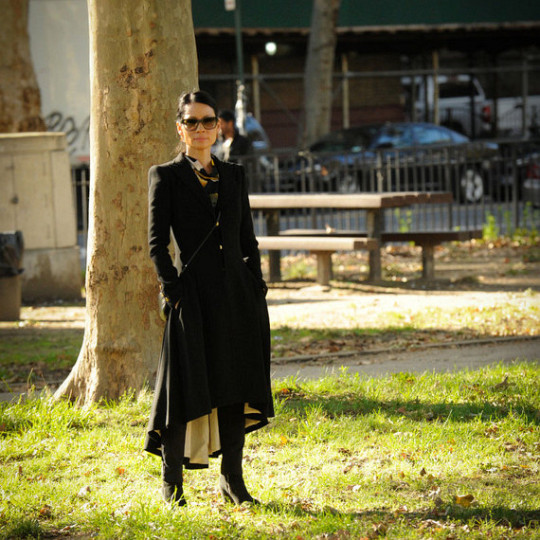
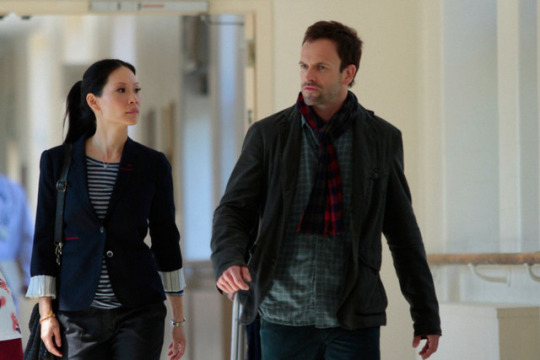





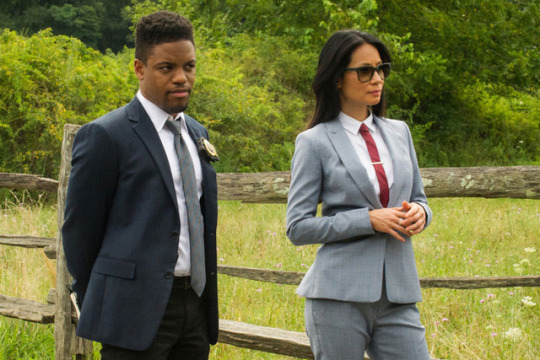
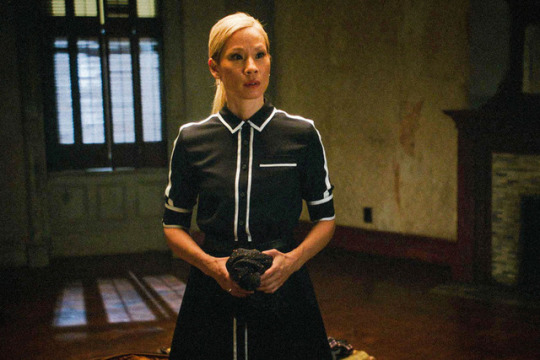

Vulture: Elementary’s Joan Watson Is the Best-Dressed Detective on TV
In the seventh and final season of Elementary, Joan Watson is blonde. The character’s style has constantly evolved alongside her detective career and partnership with Sherlock Holmes (Jonny Lee Miller), but in all her years on the show, there has been very little change to Lucy Liu’s locks. With just 13 episodes left, though, Joan has drastically altered her hair, which in turn means one last style shake-up for the best-dressed detective on TV.
Credit for that goes to costume designer Rebecca Hofherr, who has worked on the CBS procedural since its second episode in 2012, and who has guided Joan’s transformation from predominantly casual-leaning clothing to more structured menswear-inspired pieces. Hofherr spoke to Vulture about the narrative and fashion influences behind Joan’s costume evolution, including how they put their own stamp on an iconic duo and the sartorial challenges of shooting a 20-plus-episode season in New York City.
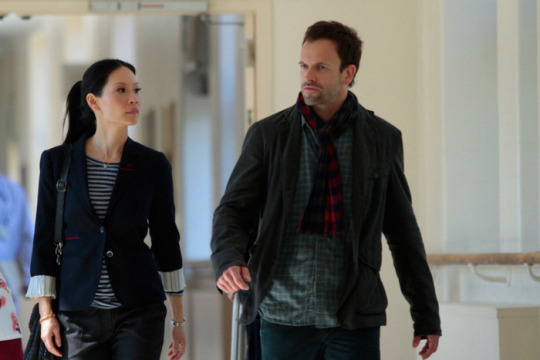
Joan’s styling was much more relaxed in the first year of Elementary. As his sober companion, her relationship with Sherlock was initially a professional commitment. She was not yet a detective and she was very much in the background of the investigation scenes. “Her clothing was very casual because that’s what the job called for,” Hofherr says. As Joan got more versed in the crime-solving world, her role shifted from sober companion to Sherlock’s protégée. By the second season, her costuming moved toward a slightly more sophisticated and buttoned-up approach. “As cheesy as it might sound, you need to put on a little more armor when dealing with the NYPD and all these criminals,” says Hofherr.
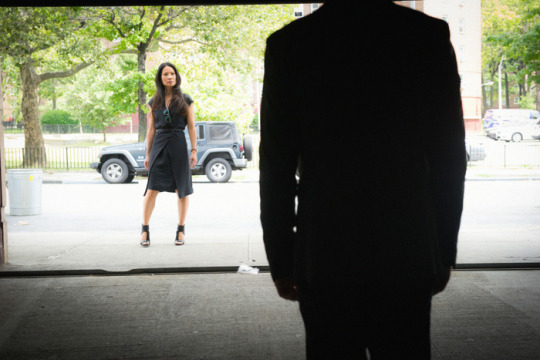
Joan’s wardrobe isn’t an either/or between suits and dresses, or even casual and business attire. She didn’t become a detective and suddenly stop wearing comfortable clothing. The suits reflect a change in Joan’s status and independence as an investigator, but dresses and sandals are still a vital style ingredient. During one Hofherr’s first conversations with Liu, they agreed Joan should “feel like a real New Yorker.” Expanding on this, Hofherr included staple items such as blazers or sandals, which most women have in their closets to dress an outfit up or down. “It was really nice to be able to incorporate them into a professional world for Joan,” she says.
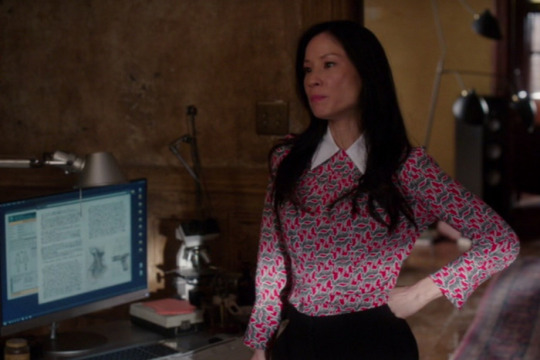
Discovering the true cost of a TV character’s wardrobe is an eye-opening experience. Joan’s closet is definitely packed with high-end items — Hofherr’s go-to favored designers for Joan include Victoria Beckham, Saint Laurent, Isabel Marant, and Stella McCartney, with Rag & Bone as her signature bootee choice — but to ensure her clothing reflected that New Yorker aspect, Hofherr also shopped at Zara and H&M. “It was really important to do a mix,” she says. “I think that’s pretty much how everyone shops. I don’t think it’s realistic to only shop at high-end stores.”
Noticeable costume repeats tend to be outerwear, but Hofherr also uses staple investment pieces such as high-waisted black pencil Victoria Beckham pants. (Dressing them with an inexpensive top, she adds, is “a great way to get a lot of outfits out of a really expensive pair of pants.”) There is an aspirational element to Joan’s garments, but the high-low mixing reflects how a lot of people shop. Hofherr also notes with a laugh that “pretty much everything Lucy wore from Zara, I also own. I was like, Oh, I can afford that.”

The one item that has appeared in all seven seasons? Joan’s red men’s Elder Statesman “house sweater.” Most people have a cozy garment that they only wear in the comfort of their own home, Hofherr explains, and Joan is no different. Sherlock and Joan’s brownstone home doubles as their office, but she wouldn’t be wearing suits at all hours of the day and night while solving a case. As Liu has worn this sweater so many times on the show, Hofherr says that not only has it molded to her body but it also has the pulls of a well-loved garment. It is also a color Joan doesn’t typically wear, which visually makes it a “nice change.”
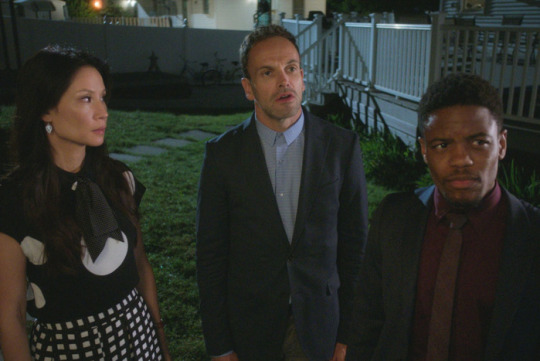
Joan doesn’t eschew color, but a black-and-white motif runs through the first season to the last. Regardless of whether it is a suit, skirt, or a more casual outfit, sticking with the same color tone allows for experimentation with pattern. In the above outfit from season four’s “The Games Underfoot,” she wears a Saint Laurent polka-dotted tie with a checkered J.O.A. skirt and polka-dotted Ji Oh blouse. Sometimes the costume choice reflects Joan’s career, but on occasions like this one, it shows that Joan has a “fashionable side” too. “She can throw these things together and look really cute,” Hofherr says.
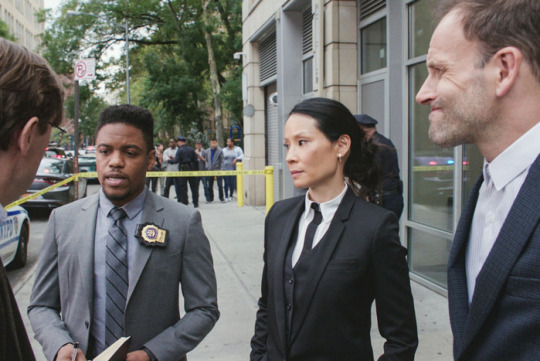
Two big style turning points emphasize Joan’s drive for equal footing with Sherlock as a detective. First came the ties, introduced at the end of season three. Suits followed, making their initial sartorial stamp in season five. The message is clear: Long gone are the days when Joan was Sherlock’s student. As with a lot of Joan’s costuming, she doesn’t stick to one specific suit-and-tie combo. In fact, the Marc Jacobs shirt above (which Hofherr got from one of her go-to sites, Shopbop) is a bit of an optical illusion, as it doesn’t even include a tie. Vests were thrown into the mix after Hofherr made the decision to stick with suits. It is also a nod to her relationship with Sherlock: Up to this point, Hofherr points out, vests have been Sherlock’s thing, so this costume mirroring is “a little nod to her respecting him so much.”

“I went to all ends of the Earth!” Hofherr laughs when talking about the many ties Joan has worn on Elementary. Men’s offerings were out of the question for someone of Liu’s stature, as they are just too wide and long. She snapped up everything Saint Laurent and Gucci had on offer, but she also shopped at uniform companies, bought a few kids’ ties, and even made them in-house. Maybe a Joan Watson tie line should be next? “If all these designers are going to sell women’s suits, I would love for them to start making women’s ties,” Hofherr suggests.
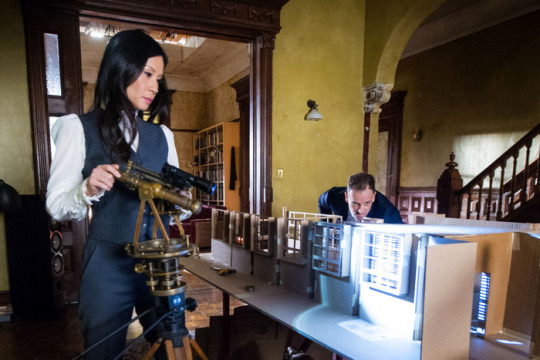
Another later costume addition was the Victorian-style Isabel Marant blouse. In part, this outfit was a hat tip to the original Holmes and Watson, but it also added another variation on the suit theme. One of the biggest challenges when doing a show with a full 20-plus-episode order is obtaining enough clothing, particularly for a fashion-forward character like Joan. Hofherr says that she needs 50 outfits a month — on average, Joan has five changes per episode — and costuming was made trickier because designers don’t typically replenish their collections between seasons. “We end up making a lot of clothes based on designs we love and change a few things because I can’t find 20 Victorian-style blouses or 20 men’s-style blouses,” Hofherr laments. “I can find five, but then that’s it for four months.”
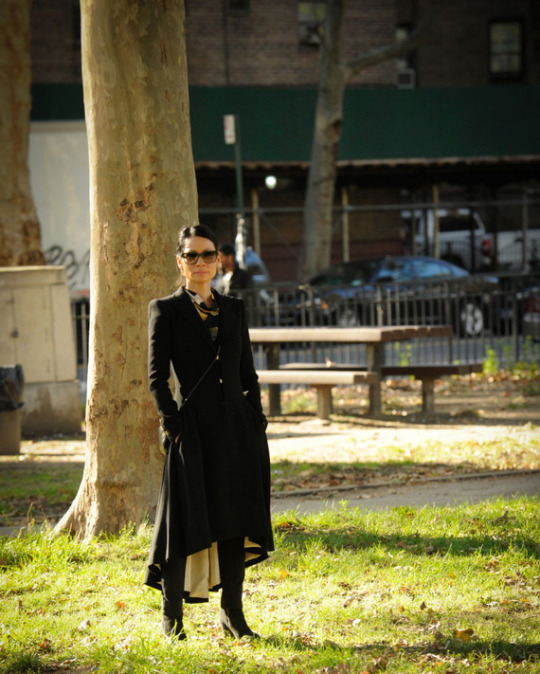
Fashion seasons are not the only Elementary costume challenge, as shooting outside in New York City from July to May means having to find clothing that fits all weather cycles. (The 13-episode final season was a bit easier, though, because they only shot until December.) Sherlock sticks to the same styles — “This guy would buy 20 of the same shirts, the same sport coat, and the same pants,” Hofherr says — and he has also worn the same Tom Ford winter peacoat for seven years. On the flip side, Joan has many changes, but she isn’t going to have a different coat for each outfit, as that is neither practical or realistic for either the character or the designer. Hofherr’s preference was to have between five and ten on hand: “If we got the coats fitted and ready to go we could just recycle them episode after episode.” Outerwear is something that is repeated across various seasons — including the Alice + Olivia coat above — but accessories like hats, gloves, and scarves are switched out to keep things fresh.

Sometimes the weather also dictates the type of hat required: “I originally got that hat because we were shooting outside one day in the rain and they didn’t want to have umbrellas,” Hofherr says. The wider brim of this Barneys-brand men’s hat has since been worn on a number of occasions, as has the tie-waist Marissa Webb windowpane check coat (which will reappear in the final season).

Of course, the story also dictates what Hofherr chooses for Joan. At the end of season six, creator Rob Doherty didn’t know if they were going to get renewed, so they shot two different endings. This particular Diane von Furstenberg dress fit both the ending we saw and the alternative they filmed — though Hofherr couldn’t provide any other details without spoiling the end of season seven as well. “I wanted it to be timeless, as I didn’t know if it was the last time we were ever going to see Joan Watson,” she says. “It was a little bit of an ode to all the Joans we have seen throughout the seasons. I felt a suit would have been a different look for that final scene.” No surprise, then, that it is also one of Hofherr’s costume highlights.

Hofherr couldn’t pick a single favorite outfit, but this one she considers to be the most significant. At the end of season three, Sherlock has almost killed a man and relapsed, but Joan’s loyalty doesn’t waver. “This is where we start to see the Joan that we will forever know,” says Hofherr. “And I think this is the best version of Joan too.” The pink skirt is by Roland Mouret and the shirt is Uniqlo, which is another high-low outfit mix. It also happens to be the first time Joan wears a tie, which is a huge style turning point.

Hofherr also spoke in depth about working with Liu, not only as an actress but in her role as a director. (She has stepped behind the camera six times on Elementary.) Referring to Liu as “one of the most inspirational women I’ve had in my life” — she also did the costume design on the Liu-starring Netflix rom-com Set It Up — she says Liu is “willing to take risks, but she knows exactly when to take them.”
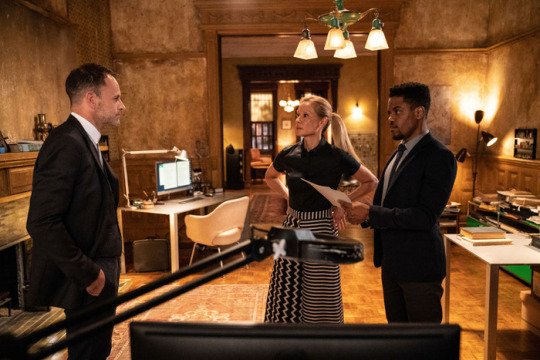
Which brings us back to the blonde mystery. Hofherr had already FaceTimed with Liu sporting her new hair color, but the styling was a task of its own. “She walked in for her first fitting of the final season and I didn’t recognize her,” said Hofherr laughing. They did plan fewer outfits than previous seasons’ fittings, she adds, “because we were figuring out what works with the blonde hair and what doesn’t.” Don’t worry: There are still plenty of outfits to come, particularly in the last two episodes. (Hofherr teased that Joan will have ten-plus changes.)
The signature black-and-white motif remains, including these fabulous Stella McCartney palazzo pants. “I always know it’s a really good outfit when all the crew members ask me what it is,” Hofherr says. That is the exact reaction Liu got when she stepped on set in this particular costume.
#joan watson#lucy liu#rebecca hofherr#elementary#elementasquee#behind the scenes#who dresses you girl#i think what you do is amazing#read more
1K notes
·
View notes
Photo
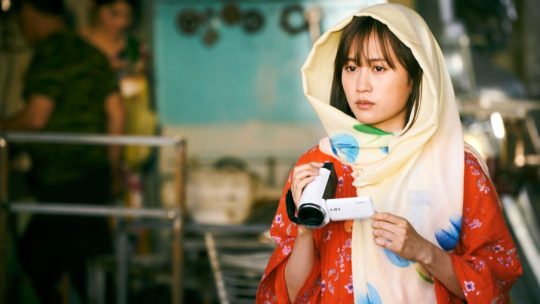
Chameleon.
For Japanuary, J-horror auteur Kiyoshi Kurosawa talks to Aaron Yap about upending genre expectations with his dreamy new travelogue To the Ends of the Earth, the unconscious connections between his films, and how it’s time for a proper evaluation of Robert Zemeckis.
Kiyoshi Kurosawa’s continued, uncontested position as a horror auteur isn’t unjustified. Emerging as a key voice in the J-horror boom of the late ’90s, Kurosawa hypnotized us with his chilly, haunting, atmospheric—and often apocalyptically tinged—visions of baffling serial killers, ghosts in machines, insidious doppelgangers and vengeful apparitions.
Bong Joon-ho once called Kurosawa’s 1997 mind-bender Cure one of the greatest films ever made. Pulse, his terrifyingly prophetic 2001 film, for my money—and many Letterboxd members’—might still be the creepiest of all contemporary horrors. “It is the only film I’ve ever seen in which every single shot feels genuinely haunted,” writes Connor.
Rarely behaving in a traditional scary-movie fashion, Kurosawa’s idiosyncratic horror films often test our expectations of genre, then deliver beyond those boundaries to probe his recurring themes: identity and isolation, humanity’s relationship to technology and nature, and deep-seated anxieties that nibble away at society’s crumbling fabric. Pulse, besides being an exercise in deftly crafted dread, is a great, telling, melancholy movie about the overwhelming loneliness of the digital age.
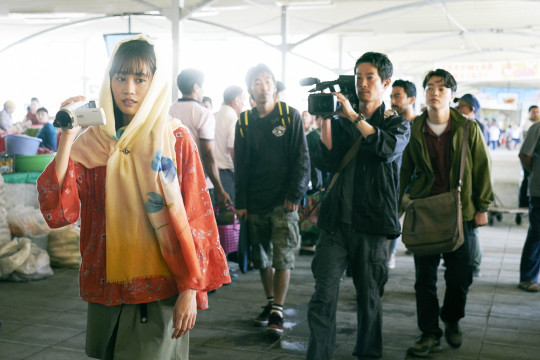
Yoko (Atsuko Maeda) and her travel show crew in ‘To the Ends of the Earth’.
However, the general focus on his horror “side” tends to eclipse a filmography that’s far richer and more versatile than he’s usually given credit for. Over the past two decades, we’ve seen him seem forge a thrillingly chameleonic, unpredictable path that’s included an ecological thriller (Charisma), an Ozu-esque family drama (Tokyo Sonata), a metaphysical romance (Journey to the Shore) and an alien invasion sci-fi (Before We Vanish). No one is really doing it like Kurosawa, and To the Ends of the Earth is arguably his most exciting and enigmatic left-turn yet.
To the Ends of the Earth is a commissioned piece to celebrate the diplomatic relations between Japan and the Central Asian republic of Uzbekistan, but that doesn’t diminish that it’s unmistakably a Kiyoshi Kurosawa film, not a tossed-off, exoticized, postcard-pretty travelogue. His signature languorous pacing, shrewdly slippery tonal calibration, and acute spatial sensitivity are at full bore, servicing a loosely plotted tale of TV travel show host Yoko (former J-pop singer Atsuko Maeda) and her crew attempting to complete shooting an episode in the Uzbekistan capital of Tashkent.
If anything, this movie should really confirm him as a filmmaker of bold, fictive playfulness in a comparable register to Jacques Rivette, Olivier Assayas and Christian Petzold—something that 2013’s hour-long, similarly fish-out-of-water head-rush Seventh Code, also starring Maeda, hinted at. In To the Ends of the Earth, gentleness, compassion and dream-like bursts of song and fantasy percolate through a disquieting maze of displacement—cultural, artistic, gendered—and the result is an adventurous, unpindownable, thoroughly humanistic work of curiosity and imagination.
Some years ago you did a “double feature”-themed interview with the Belfort Entrevues Film Festival where you revealed the sources of inspiration for some of your films. What film, if any, was a chief influence for To the Ends of the Earth, and can you tell us in what way?
Kiyoshi Kurosawa: When I make my work, I often consciously refer to films from the past, but that’s usually the case with genre films. For example, Cure was greatly inspired by The Silence of the Lambs. However, To the Ends of the Earth is not a genre movie, so I wasn’t consciously thinking of any specific films. However, the composition of the story, that the main character appears in every scene, is based on films by the Dardenne brothers. Viewing their films The Child and Two Days, One Night, it’s clear to see how the depiction of just one person can turn trivial incidents into something serious and suspenseful.

Atsuko Maeda and Kiyoshi Kurosawa on the set of ‘To the Ends of the Earth’.
Watching Bright Future, To the Ends of the Earth and Creepy back-to-back recently, I noticed several parallels and motifs which may or may not be intentional. For example, a jellyfish makes an appearance in a scene on TV in Creepy, or there’s a TV report of a blaze in To the Ends of the Earth that momentarily hints at a bigger natural catastrophe that echoes the jellyfish swarm in Bright Future, or other apocalyptic moments in your films like Charisma and Before We Vanish. Do you find that some of these motifs work on a subconscious level for you, or were some of them intentionally threaded in?
It’s a very interesting point. Some of them were intentional and some were not at all. It’s true about jellyfish, they appear in both Bright Future and Creepy. However, this is the first time I’ve noticed. The endings of Charisma and Before We Vanish were already written in the script by necessity, so of course, it’s intentional. The depiction of the blaze on TV in To the Ends of the Earth was introduced to show something happening in Japan while the main character is taking a small adventure in Uzbekistan. I wanted to show that her boyfriend was in some kind of crisis there. While the fire on the TV is merely an accident, it does appear apocalyptic. I may have overdone that a bit. Perhaps some kind of unconscious thinking was at work.
That amusement park ride scene in To the Ends of the Earth has stayed with me in the way it suggests terror out of something seemingly mundane. What are some scenes from other films that have stayed with you?
The amusement park ride scene wasn’t introduced to express terror. What I wanted to show was how crazy the assignment is and Yuko’s professionalism. She takes on the assignment without fear. This may have been a bit overdone as well. However, I thought that Atsuko Maeda, who didn’t hesitate to actually ride it three times, was a real professional. Apart from that, if I think about the movies that force people to experience horror, what comes to me are Roger Corman’s Pit and the Pendulum. Tobe Hooper’s The Funhouse, George Miller’s Mad Max: Fury Road. I also remembered the episode in Freddie Francis’s Torture Garden, where a grand piano has a will to kill people, which was great.
Your films tend to be very location-based; environments and spaces appear to play a significant part. The pandemic has been the ultimate test of our relationship with spaces and each other. How has the pandemic impacted you as a filmmaker, and are there themes and ideas that you are interested in exploring further as a result of Covid?
As you pointed out, when I make a movie, I pay great attention to the location. The moment I find a good location, I feel that the script will be transformed into a movie. It is the moment when fiction and reality are fused. It’s hard to say anything though, I haven’t made a movie since the pandemic started. What I can say, at least, is that sitting in front of the computer at home is not cinematic at all. So far, I don’t feel that something new will be born from it. What should I do? After all, I feel that a movie can only be made by going out in the city with a camera after utilizing the best epidemic prevention system possible.
If you had to pick a film that’s a personal favorite, which would you pick, and why?
It's too difficult a question. Japanese movies and foreign movies have different viewpoints. Also, there are completely different categories of movies [that] greatly influence me when I make films and the movies I saw when I was young that make me nostalgic. It’s impossible to choose just one. But, well, the one that comes to mind is Sam Peckinpah’s The Ballad of Cable Hogue, which is both nostalgic and heavily influential for me.

You’ve spoken about your fondness for American filmmakers like Tobe Hooper, Robert Aldrich, Steven Spielberg et al. Are there new, or more recent American filmmakers and films that have caught your attention or that you’re particularly excited by?
I don’t know much about young American directors, but what I always care about is Alfonso Cuarón. Of course he is not a new, young filmmaker, but an auteur. Also, since this is a good opportunity, I’d like to mention Robert Zemeckis. He made such masterpieces as Cast Away and What Lies Beneath around 2000. For some reason, he has never been properly evaluated at all. For a time he was devoted to animation. However, he made a spectacular return to live-action films with Flight and continues to shoot unique masterpieces like Allied and Welcome to Marwen. Of course, not many people appreciate these works. However, he does not seem to care about public opinion at all and continues to boldly shoot new works. Perhaps Zemeckis is the American film director who makes the most authentic films today.
What are your movie-watching habits like? Do you continue to watch movies on physical media or prefer streaming these days? What was the last movie you saw in a theater?
Basically, I like to watch movies at an ordinary movie theater in the city the most. When I can’t go to the movie theater, or even though I know the film is going to be boring but I have to watch a movie for business, I have no choice but to watch it on DVD or Blu-ray. Of course, I also use VOD once in a while. The last movie I saw in the theater, as of today, was the Japanese film The Voice in the Crime. I saw that just yesterday. I saw it with my wife at a cinema complex in Shinjuku, Tokyo. It was the latest work by the director who made the previous masterpiece Flying Colors, and I expected much from it. It was speedy and quite well done until the middle of the film, but by the ending, it was too boring. Unfortunately, it wasn’t a good movie.
What’s a memorable film-related moment from your childhood, perhaps something you experienced with family or friends, or a film that scared you or made you cry?
The movies that my generation often watched growing up were mainly monster movies. The most unforgettable one was Matango. Like Godzilla and Mothra, it was directed by Ishirō Honda. I went to see this movie with my friends. It had a rather cute touch in the promotional materials depicting a mushroom with a monstrous appearance. However, the content was completely different from a normal monster movie. Shipwrecked survivors on an uninhabited island encounter monstrous mushroom creatures washed up on the shore. These are not unknown creatures such as Godzilla or Mothra, but the horrifying ending of a human being. The characters are being infected, changing one another into mushroom humans. All of us children trembled from the bottom of our hearts. In retrospect, the work is an extreme horror aiming along the same line as [Howard Hawks and] Christian Nyby’s The Thing from Another World. It was probably the first time I encountered horror which was not “to escape from destruction” but “when a human being becomes something not human”.
Is there a filmmaker or film you think about a lot that you don’t get to talk about much and would like to show some appreciation?
I haven’t talked much about the Battles Without Honor and Humanity series directed by Kinji Fukasaku. I don’t know how well this series of Japanese movies is known abroad, but when I was a high-school student I saw this and quickly became a big fan. I’ve watched a variety of yakuza movies since then, and it’s safe to say that nothing beats this series. As the title suggests, the films depict a yakuza world without “Jingi” (yakuza’s moral code), and it was really humorous and exciting to see the betrayals and the destruction. After I saw this, all those traditional yakuza movies dominated by the strange ideology of “Jingi” looked like a childish fantasy.
Related content
The Japanuary Challenge 2021
Explore more J-horror, ’80s J-horror and ’90s J-horror
Follow Aaron on Letterboxd
‘To the Ends of the Earth’ is available for rental in the US via distributor KimStim. From February 5-25, Japan Society’s virtual cinema hosts ‘21st Century Japan: Films from 2001-2020’, featuring films from Hirokazu Kore-eda, Naomi Kawase and Takashi Miike, the online US premieres of Sion Sono’s ‘Red Post on Escher Street’ and Yukiko Mishima’s ‘Shape of Red’, plus a special focus on Kiyoshi Kurosawa (‘Bright Future’, ‘Journey to the Shore’, ‘Real’).
#Kiyoshi kurosawa#to the ends of the earth#j-horror#j-horror films#japanese films#japanese cinema#japanese horror#japan society#japanuary#letterboxd#sion sono#tokyo sonata#robert zemeckis#aaron yap
4 notes
·
View notes
Text
‘Liz and the Blue Bird’ Recap Part 1
I recently watched KyoAni’s ‘Liz & the Blue Bird’ for the first time, and I have to say: wow, what a film. This is one of the few times where I finished a film and was left utterly speechless by the end of it. I’m not exaggerating when I say that this is my new favorite film. If you’ve ever felt like a movie had to have been made specifically with you in mind because it seemed to hit all the right notes with you emotionally, that’s exactly how I feel about ‘Liz.’ Part of me is wishing I had watched this movie around when it first came out so that I could’ve witnessed all the hype around it. However, I actually do think it was for the best that I waited until now to watch it. I honestly don’t think I would’ve understood it as well as I do now.
I really love this movie, and I really wanna talk about it. So, instead of harassing my friends about it, I’m going to be doing a scene by scene review of ‘Liz’ and share my thoughts. I promise you this is only going to be, like, half-serious.
This is going to be split into 3 parts uploaded sporadically.
Obviously this post will contain spoilers for the whole film as well as seasons 1 and 2 of Hibike.
Liz and the Blue Bird or Liz to Aoi Tori is an animated film directed by Naoko Yamada, produced by the prolific animation studio known as Kyoto Animation, and was released on April 21, 2018 in Japan, then November 9, 2018 in the US. To talk about Naoko Yamada for a minute, she started off at KyoAni as an assistant animator, doing inbetweens as so many animators do starting out in the industry. Eventually she was allowed to direct, where she has quite the impressive track record. She’s directed K-On!, Tamako Market, Hibike! Euphonium, and probably most notably, A Silent Voice just to name a few things. With that in mind, I’m not surprised why I enjoyed this movie so much. Yamada is known to show a real sensitivity toward depicting the different relationships between young girls in a naturalistic way.
EDIT: I began writing this on Saturday, April 18, just a day or two after I watched the movie for the first time, and I swear I didn’t even process that the two-year anniversary was coming up! What a wacky coincidence.
ACT 1

The first imagery in the film we see are gorgeous, picturesque watercolor-style background paintings.

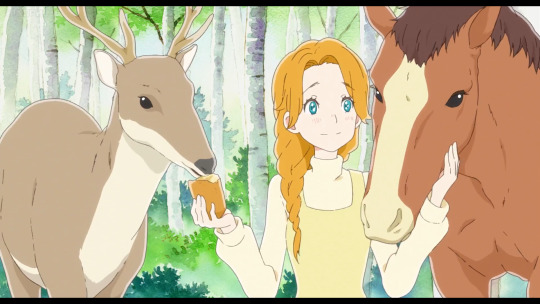
As the titular track plays, we are introduced to Liz; not the main character of the film, but certainly the main character of the book, also entitled ‘Liz & the Bluebird,’ featured in this film.
The first shot we see of her is a voyeuristic one; we are a good distance away and we are peeking from behind a tree at the intimate moment between Liz and her animal companions.I have to say, I had no idea what to expect when I first sat down to watch this movie, as I wanted to go in as blindly as possible. I certainly hadn’t been expecting to see this German picture book-esque art style with lush forest backgrounds in a Hibike movie, and I honestly thought for a moment that I had accidentally stumbled upon the wrong movie.

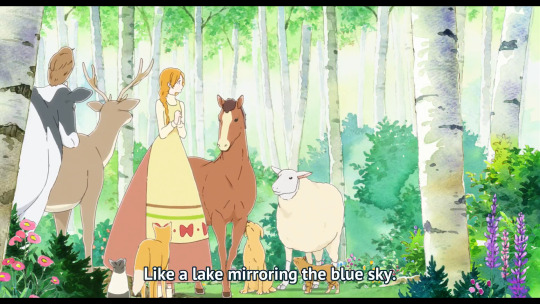
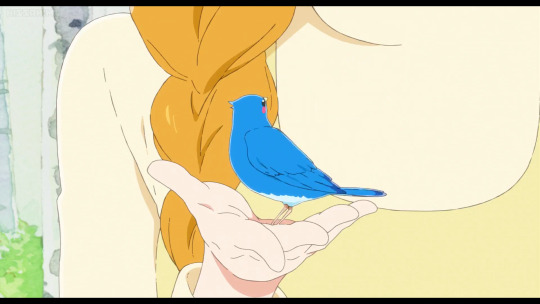
Liz spots a bluebird settled on a tree stump and she is immediately attracted to the creature. The bird flies over to Liz and lands in her hands as the music climaxes, but as quickly as it arrives, it flies away across the lake. A bittersweet moment.
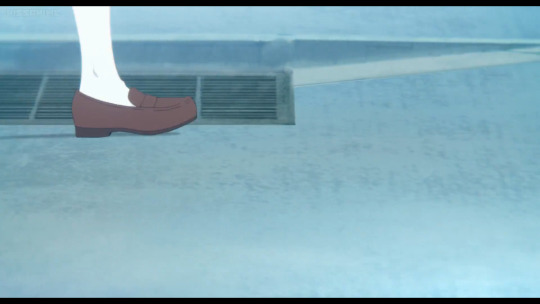
As the camera pans downward toward the flowers, the scene fades, and we are finally brought into the real world. This is punctuated by the titular track concluding, and being replaced by music that is more abstract and minimalistic. This world is notably duller with cooler, more subdued colors, directly contrasting with the bright, warm colors in the picture book world.
Shots with the camera focused on feet or legs are a common motif seen throughout this film.


We are finally introduced to one of our main characters, Mizore Yoroizuka, now a third year at Kitauji.
I was also slightly caught off guard seeing this new art style being used. Initially, I missed the art style originally used in the show, but after watching this movie I now understand KyoAni’s decision in changing it up, and I also completely agree with it. Looking back, I believe that the show’s original art style simply would not have worked at all, or at least not as well as it could’ve. This new art style with thinner linework, slightly elongated figures, slightly smaller eyes, and subdued colors makes the characters feel more mature to match the tone of the film. Also, while the old style is ideal for showcasing exaggerated and wacky facial expressions, this style is suited better for more subtle emotion, which, again, better matches the tone.



She waits.
Something I enjoy about KyoAni films is how the camera is oftentimes used to show the audience what a character is seeing through their eyes, instead of the camera just acting as a third person bystander all the time.


We hear more footsteps approaching, but they do not belong to the girl Mizore is waiting for.
This is turning into an episode of the ‘Gushing Over KyoAni Power Hour’ but I have to commend their sound design and the way they utilize silence and quiet moments in this movie. So far in this scene, aside from the very minimal track played over this, all we can hear is the foley of the atmosphere, footsteps, clothes rustling, etc. This quietness shows us the solitude of Mizore’s world. It’s also important to note that all the music, not sure if this includes the music in the picture book world, was recorded in the school that Kitauji is based off of. Regular school items were even being used as instruments!
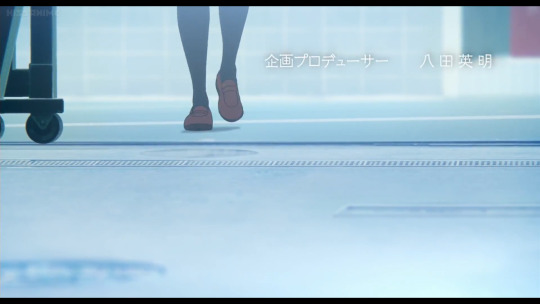


When the music suddenly picks up as another girl rounds the corner, we know she’s the one.
I like to believe that Mizore is so attuned to Nozomi that she’s memorized the sound of her footsteps and is immediately able to recognize that it's her as soon as she is within ear range.

:’)
Nozomi is in focus while everything else in the shot is out of focus. To Mizore, everything outside of Nozomi is irrelevant.

The two girls continue walking together, Nozomi leading and Mizore following behind. This statement alone accurately summarizes the dynamic between these two characters during the beginning half of the movie. Clearly there’s something of an imbalance. Mizore watches and waits for Nozomi to act before she does anything.

I read somewhere that Mizore’s seiyuu speculated that when Mizore is an adult and she looks back to her time at high school, she’ll find that her only memory of Nozomi will be the back of her head… and that got me… feeling some emotions….

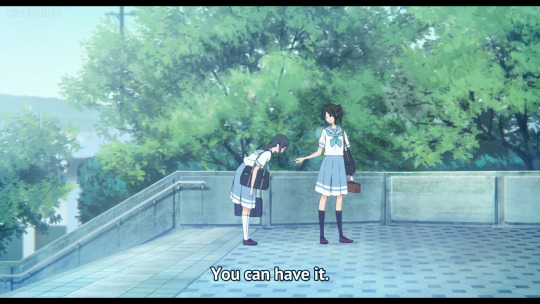
Coincidentally, Nozomi finds the feather of a bluebird on the ground, and offers it to Mizore.
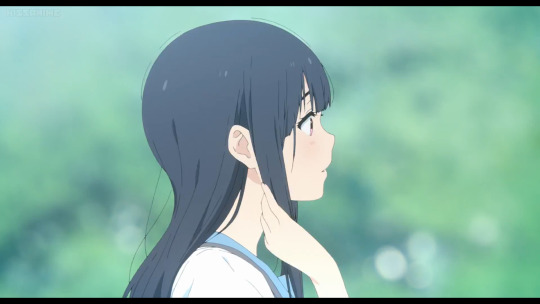
I have my own little theory that Mizore could be on the spectrum. Her habit of running a hand down her hair whenever she appears to be nervous or anxious, amongst her other mannerisms in this film lead me to believe that. I think I’ll elaborate further on that and explain my reasoning in a future post.


Mizore accepts it, but is still unsure of herself. Hence the questioning tone. Clearly Nozomi found the feather to be extremely pretty, but Mizore doesn’t know why she would give it to her of all people. She’s still under the impression that she doesn’t mean as much to Nozomi, as Nozomi means to her.


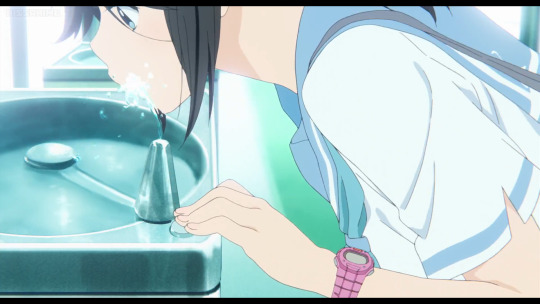
More shots of Nozomi and Mizore playing follow-the-leader as they walk through the school. Nozomi puts her hand on a locker as she rounds a corner, Mizore also puts her hand on a locker. Nozomi stops for a sip of water, Mizore also stops for a sip of water.
These walk cycles give us good indications as to who these characters are. Mizore is timid and hesitant, Nozomi is carefree and outgoing.

Kitauji has way too many different flights of stairs.



We are flashed back to a memory that mirrors this moment in time. Again, Nozomi walks with a skip in her step, her hips swaying, and her ponytail bouncing playfully.

Mizore puts the key in the door to the band room, but hesitates for a moment before unlocking it. When she does open it, Nozomi enters the room first with a twirl.
I’ve been watching a lot of video essays and reading a lot of discussions about this movie, and one of the points someone brought up really stuck out to me. This whole scene, from when they are walking through the hallways until now, when Mizore opens the door, offers the earliest hint in the movie that Mizore is actually the bluebird in the relationship. While Nozomi is the one ahead of Mizore on their journey, Mizore is the one who holds the keys to their destination. Mizore is the one in charge, but she holds herself back. While Nozomi makes it to the door first, she cannot enter until Mizore opens it.
That’s one of the many things I love about this movie, there are so many nuances that you pick up new things and make new interpretations with every single viewing.
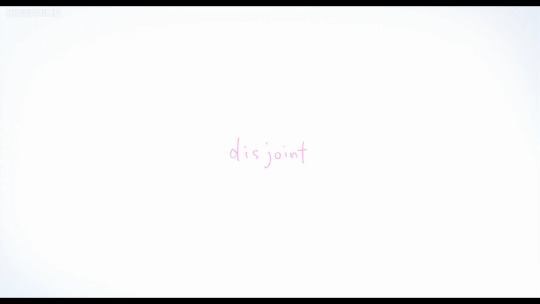
Uh oh.
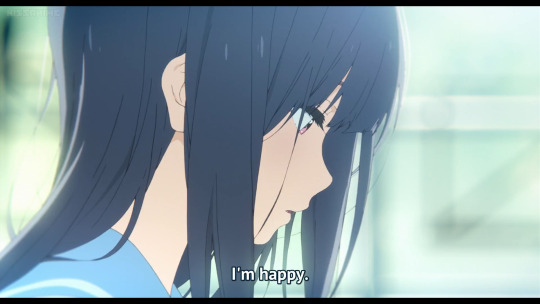
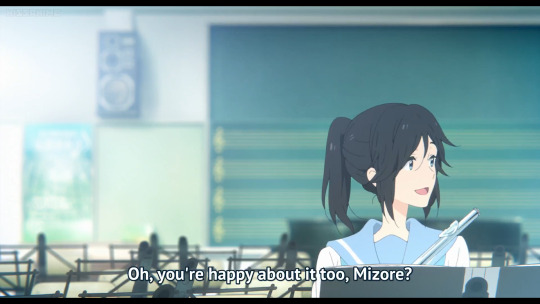
After putting their instruments together and warming up, in a rare moment, Mizore tells Nozomi how she’s feeling. Mizore is merely happy to have Nozomi at her side, but Nozomi misinterprets this as her being happy about the free-choice piece their band has chosen to play: Liz & the Bluebird. Mizore probably couldn’t care less about the piece, but doesn’t bother correcting her. She is only interested in the piece and the story behind it when she hears that Nozomi is interested in it.



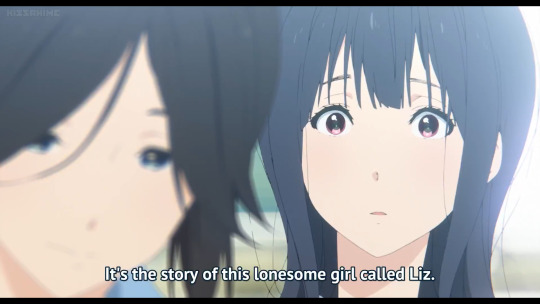
Remember how I said this art style was ideal for showing subtlety in emotions? This is what I was talking about.




In this visually experimental scene, Nozomi explains the story of Liz and the Blue Bird while we also see the story of Nozomi and Mizore’s friendship unfold.

:’)


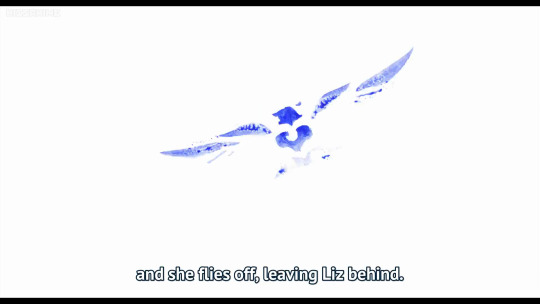
Sound familiar?
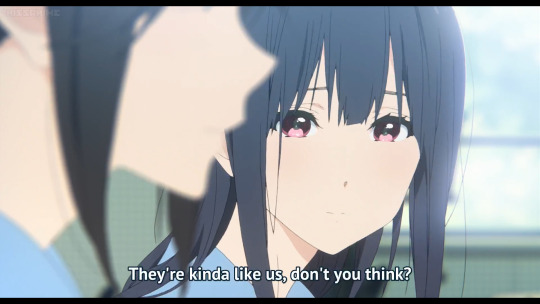


One of the first indications that Nozomi isn’t the best at listening.


Mizore: Same.
Me: Same.

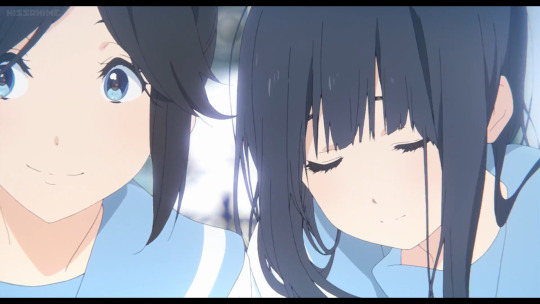
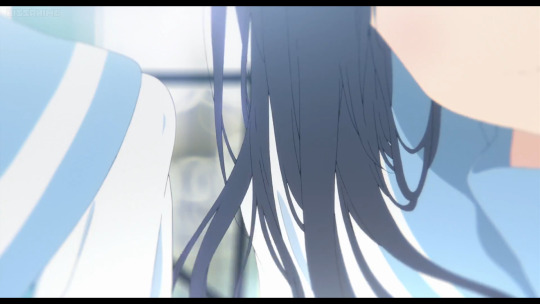

Scenes that physically hurt me #1
A lot of people love to bring up KyoAni whenever the topic of queerbaiting arises; that’s neither here nor there. However, I cannot deny the inherent queerness of this scene, and really of the whole film. It’s made obvious that Mizore loves Nozomi in a way that’s more than just a regular friend. Other people make Mizore anxious, but not Nozomi. Mizore enjoys Nozomi’s presence so much that she wants to lean into her side. For a second, the two of them are frozen in time and in a world of their own. Mizore is forced back into reality when Nozomi abruptly pulls away.


The movement title, “A Decision Borne of Love,” sticks out to Mizore.




Just like their intonation, there is that imbalance in their friendship and this is the film’s way of hinting at that if you haven’t already picked up on it.


Throughout the film, Nozomi is always wearing this pink watch, showing how eager she is for the future.


To Mizore, the watch on Nozomi’s wrist is just a constant reminder that their time left together is fleeting.

Listen. I absolutely love whenever these two are on screen together. Love-hate relationships can be hit or miss, but this pairing is one of the better ones of that kind. They’re both great characters individually, but they also have amazing chemistry together.


Don’t get it twisted, Mizore is good friends with Yuuko and Natsuki, but them entering the room means that her moment alone with Nozomi has come to an end. Mizore and Nozomi don’t seem to share any classes together, so this is likely the only time of the day where they get to have a moment to just themselves. Mizore cares for Natsuki and Yuuko, in fact Yuuko was the one who stayed by her side after Nozomi originally quit band, but her relationship with Nozomi is a treasure more precious than anything.
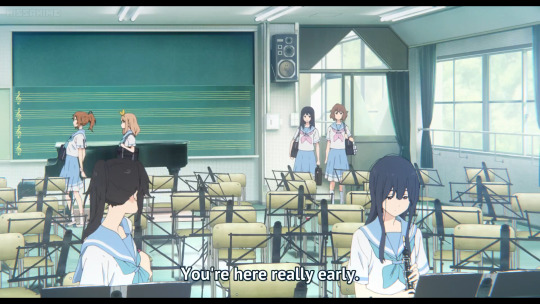

I was wondering if we’d be seeing these two in this film, and I’m so glad that they are. I’m more glad, however, that they are pretty much relegated to the background here. They’ve already had their seasons 1 and 2 character arcs wrapped up, now it’s time to give the secondary characters a chance to shine.
I’m also very glad to see these two attached at the hip in almost every scene they’re in.
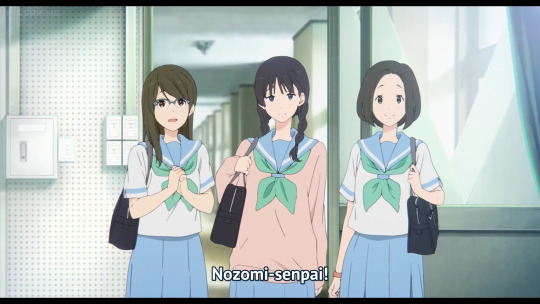


Nozomi leaves to go rehearse with her kouhais, and Mizore watches yearningly as she is being left alone again.
I’ll probably say this again multiple times throughout this recap, but I seriously identify with Mizore so much. I mean, we’ve all been that girl. We’ve all been paranoid that if given the choice, our friends would pick someone else to hang out with over you.

I admire KyoAni for including these casual moments of characters just chilling and talking about nothing. Of course they don’t add much to the overall plot, but they do contribute to the overall atmosphere of a high school. High school isn’t always about drama, it’s also about random conversations you have with your friends.
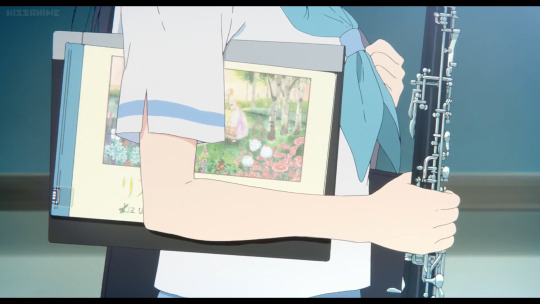
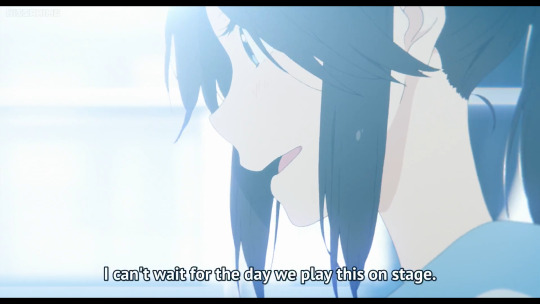

Mizore is still thinking about what Nozomi said earlier. In Hibike season 2, we know that for a time Mizore hated competitions until Kitauji won gold in the Kansai competition. I think that now in this movie, Mizore still hates competitions, but for a different reason. The national competition marks the last time the third years will get to play together. She fears that because they won’t be in the band anymore, Nozomi won’t have any other reason left to stay with Mizore.

As Mizore begins to read, we are brought back into the picture book world that strongly resembles a 1970s anime.


We see Liz again as she emerges from a train. This takes place in an early 20th century European town filled with friendly people, though Liz doesn’t seem to interact with them.
This world is also giving me Howl’s Moving Castle vibes?
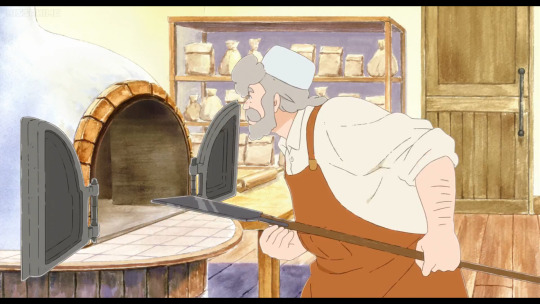

She works at a humble bread bakery owned by a man named Arlt.



Liz doesn’t look exactly eager to clock out for the day. It’s safe to assume that her shifts at work are the only times where she gets to have any real human interaction. I’m getting the impression that even though she’s introverted, she still gets lonely. Much the same as Mizore. As Liz waves ‘goodbye’ to customers, her face sinks ever so slightly.
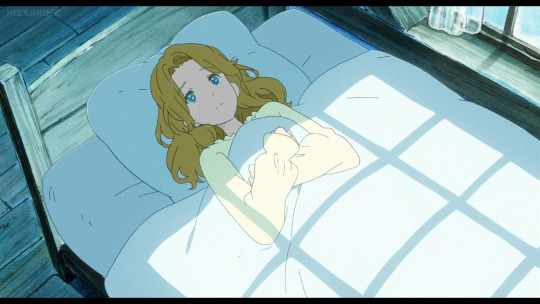
After work, Liz returns home to her cottage to prepare a meal for herself, eat it alone, and then retire to her bedroom to sleep.

In the morning, the same bluebird from earlier appears at Liz’s window and peeks inside the room.



Later in the day, Liz is caught in a storm as she is returning home from another shift at the bakery. After overdosing on berries, Liz wakes up the next morning still at the dining table, after the storm has already passed. She walks out the front door and notices a mysterious blue-haired girl passed out in the grass.

Liz realizes, “oh sh*t, I should do something.”

She’s dead.

After being woken up, the girl immediately recognizes Liz. The girl, who is actually the bluebird personified, reminds me a lot of Ponyo in how she pretty much claims Liz as her person, and quickly forms a bond with her, much like how Ponyo does to Sosuke.

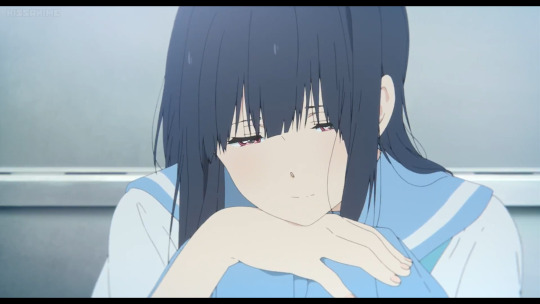
Act 2 of the movie begins and we’re brought back into Mizore’s world. She continues reading the book and smiles to herself.

In rehearsal, the band president Yuuko delivers a message about auditions for participating in the national competition. Mizore is anxious at the mention of the competition again.
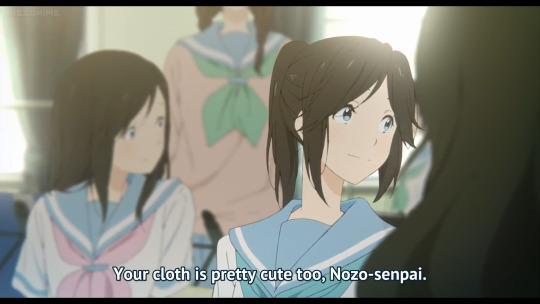
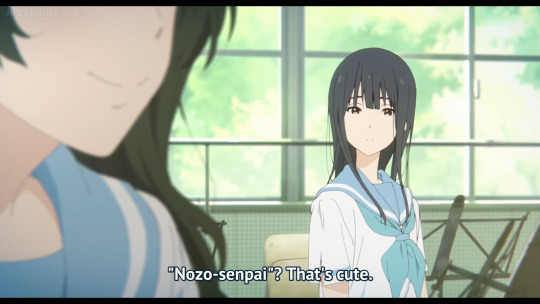
The flute girls have already given their senpai a cute nickname, and Mizore is understandably a little jealous. Maybe all of their problems would be resolved if Mizore and Nozomi would just give each other cute nicknames.

She’s literally so adorable??? I think she’d be considered a gyaru in Japanese culture based on the color of her hair and how she has it styled.
After some encouragement from her friends, a first year oboist named Ririka musters up the courage to approach Mizore.
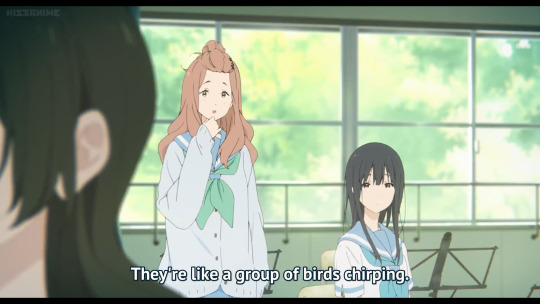
Uh Ririka, birds are a bit of a touchy subject for Mizore right now.
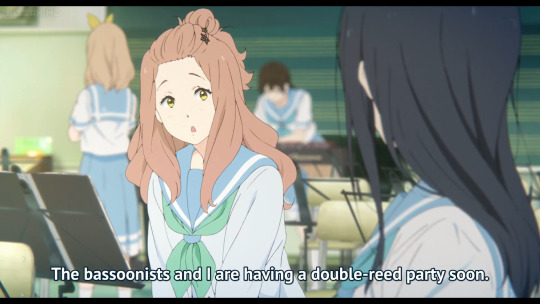
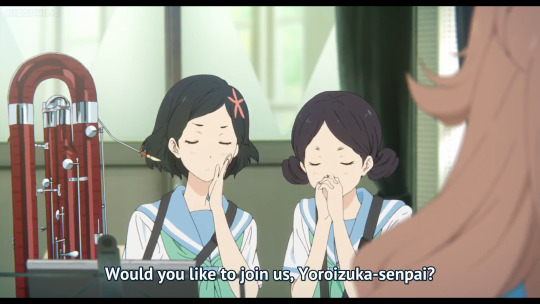
When I watched this for the first time, admittedly I was a bit anxious about what these girls’ intentions were with wanting to invite Mizore to hang out with them. However, my anxieties in regards to that were quickly relieved when I remembered that bullying is just not a concept that exists within the world of Hibike. I’m really glad that this is an anime where most people are at the very least cordial with each other.


F in the chat.
Mizore isn’t ready yet to branch out and meet other people. She’s still tunnel visioned on Nozomi.

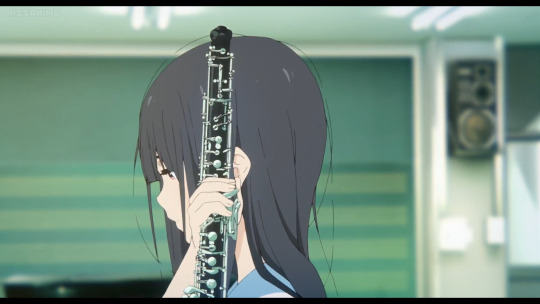
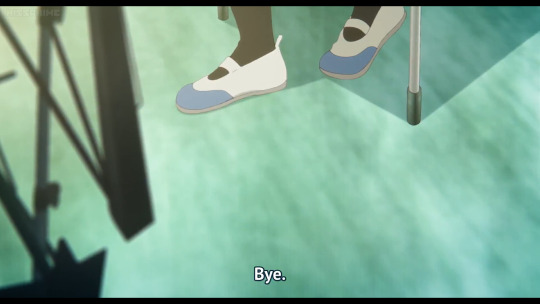
After rejecting Ririka, Mizore walks over to Nozomi. Nozomi tells her that she and the flute girls are going out to eat later today. I think that Mizore is unsure about whether this was an invitation for her to join them. Regardless, Mizore doesn’t want to impose seeing that she’d probably feel awkward around a group of people she doesn’t know very well.
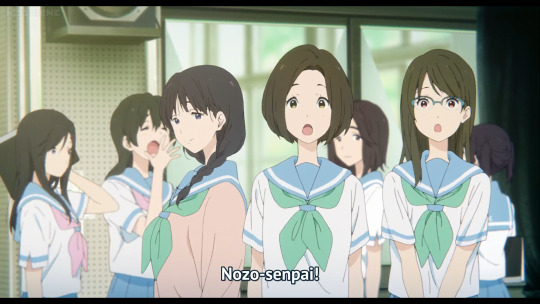

Nozomi likes spending time with Mizore, but she’s just too high in demand with her peers.



Mizore puts away her instrument, and then pulls out the bluebird feather Nozomi gave to her this morning. She clutches it close and treasures it as a gift from the person she loves.

Forever screaming at how gorgeous the environment art in this movie is.
On the way out, Mizore runs into Ririka and her double reed friends again. The first years make another attempt at starting a friendship with Mizore, though the third year only spares them a couple words before she departs.
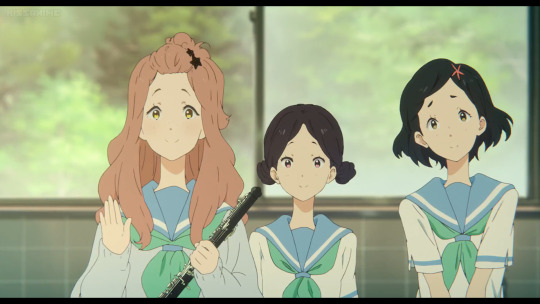

KyoAni is so good at creating such cute, appealing characters.

Ririka is really determined to get to know Mizore, so who better to ask for help from than the Mizore expert herself?
Was she about to call Mizore an ice queen? I thought that was Reina’s title.

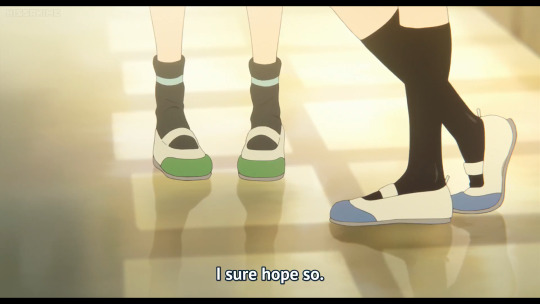
Uh, same.
Ririka is worried that she may have gotten off on the wrong foot with Mizore considering she doesn’t seem to be reciprocating. I understand this situation extremely well; I’ve been through it multiple times, although more so from the perspective of Mizore. Mizore and I are quite similar in many areas, including being aloof and taking a good while before feeling comfortable enough to open up with someone. So yeah, I do get the frustration on Ririka’s part.

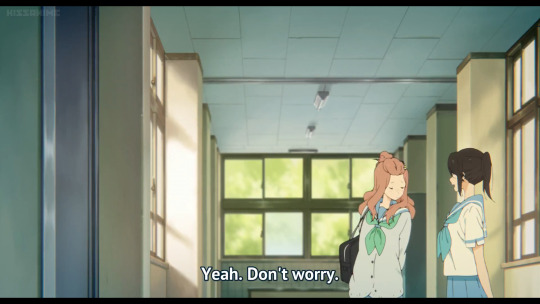
Nozomi, you literally didn’t actually offer her any advice at all, you clown.
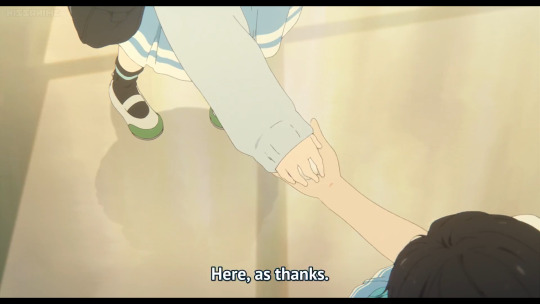

I--
A nice egg in these trying times?
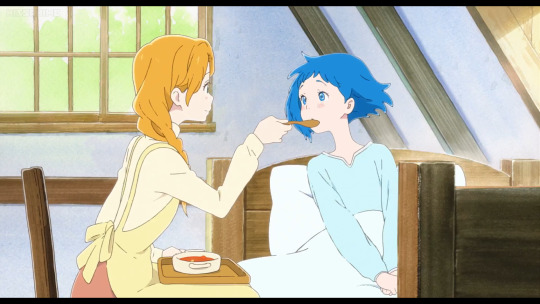
Back in the picture book, Liz has invited the blue girl into her home and is nursing her back to health. Apparently, she makes pretty good soup.

She’s offering the blue girl her home, so she might as well get some free labor out of it.


It’s a particularly windy day, and as the two of them are doing the laundry, a hankerchief gets caught in the breeze. The blue girl attempts to retrieve it but she remembers she’s lost her flight capabilities. She’s a human now, but at the cost of her wings.

Liz takes her to the local Panera Bread she works at. Arlt says... something?

The blue girl discovers she has a taste for human blood.

I’m declaring that these two are very much in love and I will not be taking any feedback at this time. The lighting in this shot is *chef’s kiss*.
The two girls have spent the whole day together, from going to the bakery, picking berries, and having dinner. The blue girl brings a light to Liz’s life that had been previously missing.


Now the duo are having a picnic on the side of a hill. It suddenly dawns on Liz that she actually doesn’t know anything about the girl she has living in her house. The blue girl doesn’t seem to know anything either. She lived a pretty nomadic lifestyle as a bird. However, one thing the blue girl knows for sure is that she came into Liz’s life so that she wouldn’t be alone anymore.



Liz is a pretty reserved individual and the blue girl is more of a free spirit. She fears that someday the blue girl will decide to leave her. So, Liz makes the very simple request that the blue girl should stay by her side forever.
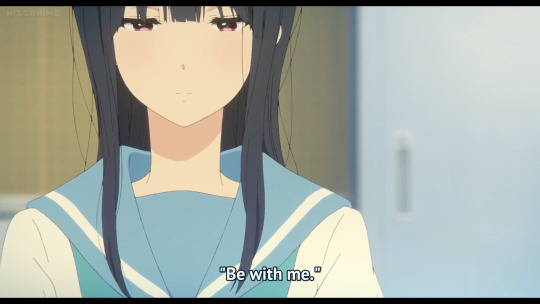
Mizore wants the same thing from her favorite person.



Mizore is interrupted from her reading by an unenthusiastic library assistant telling her that she needs to get out so that she can lock up. I imagine she isn’t quite too fond of Mizore after this movie.


First years really do be getting younger and younger...
Those two are Satsuki and Mirei, two first years who join the bass section in the next Hibike movie, Chikai no Finale. We get a better look at their relationship there.

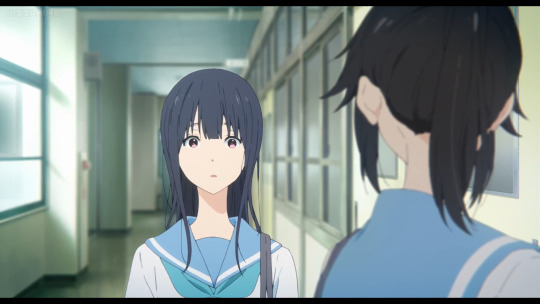
Mizore: !!!

Oh.
Nozomi explains the famous Minami Middle School ritual known as the “I Love You Hug,” or the “Daisuki no Hagu.” Basically you find a friend, give them a hug, and tell them all the things you love about them. Sounds very, very, gay.
Nozomi’s had her fair share of I Love You Hugs back in the day, but Mizore’s never had a chance to participate in one.


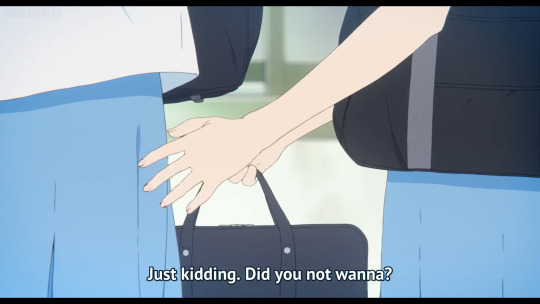
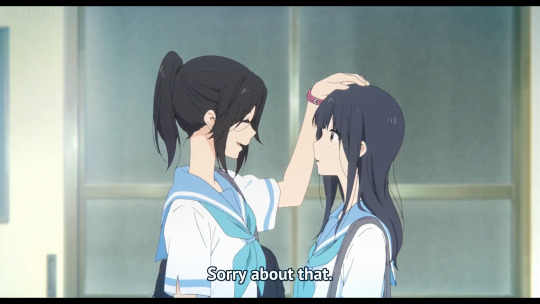
Scenes that physically hurt me #2.
Seeing that Mizore’s never experienced an I Love You Hug, Nozomi offers her one. She opens her arms waiting for her friend to reciprocate. Mizore is completely caught off guard, but she is more than willing to try it. Unfortunately, Mizore is too slow to respond and loses her chance.
Nozomi said “haha, just kidding… unless…”
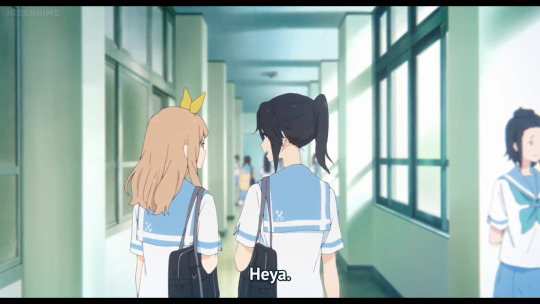

Nozomi has to leave Mizore behind so she can go to class with Yuuko. Mizore is frozen in place and Natsuki’s creepin’.

Best moment in the entire film.
I literally love Natsuki so much, she’s quickly becoming one of my favorite Hibike characters. My face lights up pretty much every time I see her on screen. She’s definitely the type of girl I’d wanna be friends with in high school.


Mizore would much rather not think about the future at all, and enjoy the time she has left with Nozomi.

And that’s how Natsuki beat Shaq.
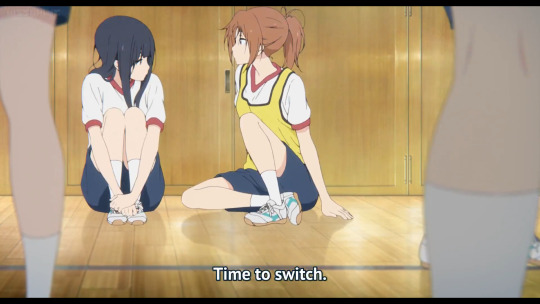
It’s time for Mizore to switch into their gym class’s basketball game, but she’s not really feelin’ it. I don’t blame her.

Okay I’m in love.
Being the excellent friend that she is, Natsuki takes one for the team and goes back in to play another round in Mizore’s place.

Nozomi listens in on her flute girls having a gossip sess’. Of course they’re talking about boys because what else do teenage girls have to talk about?
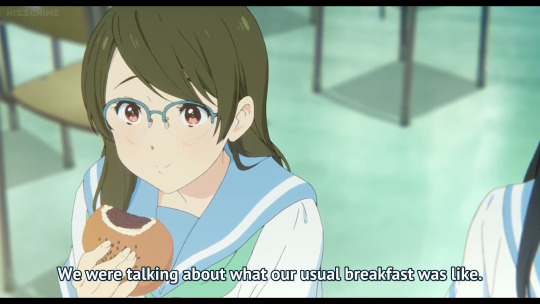
Hanayo Koizumi? When did you transfer to Kitauji?
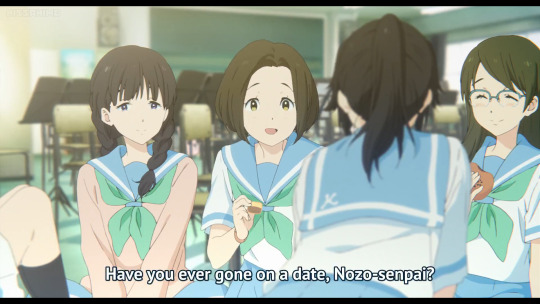
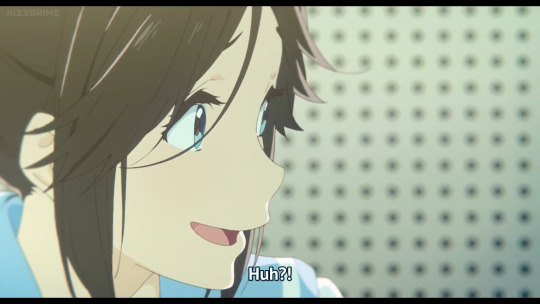
*side eye emoji*

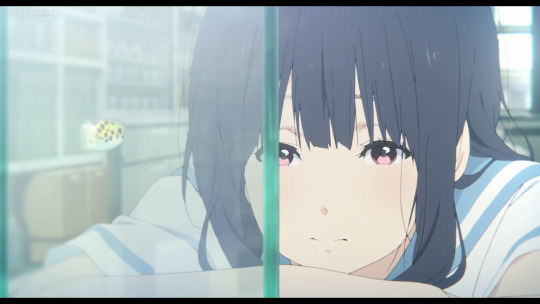
Mizore is in her usual hideout: the science lab by the blowfish tank. As of late, she’s taken a bit of an interest in feeding the blowfish.
She still hasn’t filled out the career survey; she can’t figure what to do for her future, and I don’t really think she wants to figure it out either.
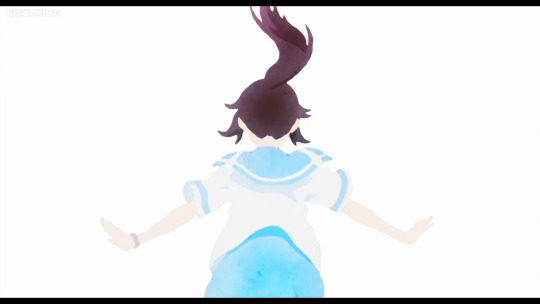
Mizore still can’t help but see Nozomi as the bluebird. Nozomi is her whole world, she’s her miracle. Ideally, she’d keep Nozomi all to herself, but she already knows that that wouldn’t be fair to her at all.

Through the window, she spots Nozomi on the other side of the school.
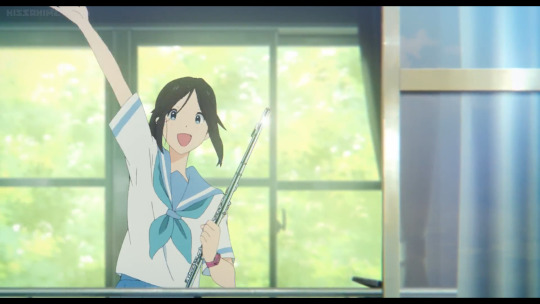
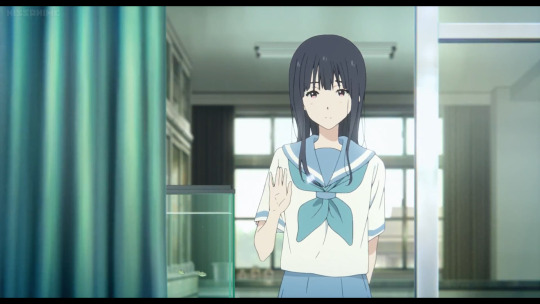

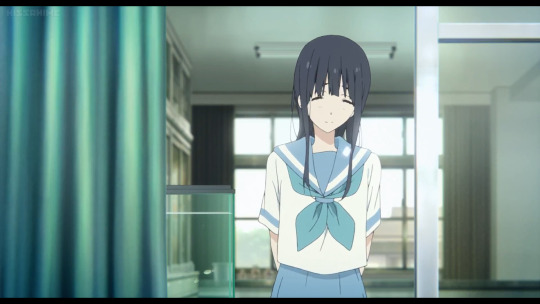
Nozomi notices that her flute is casting a dancing light reflection on her friend, and the two make a game of it.
I want nothing but good things for Mizore.


Scenes that physically hurt me #3.
It’s very easy to doubt Nozomi’s love of Mizore and to even call their friendship one-sided, but I don’t agree with that. In fact, we already know that she cares a lot about Mizore based on their arc in season 2 of Hibike. Not only can you see it in the way Nozomi looks at her, it's also clear from small gestures she does in this movie: giving Mizore the bluebird feather she finds, inviting Mizore out (which we’ll see coming up a couple times), offering her an I Love You Hug, and standing up for her when the library assistant nags Mizore about returning the book (again, a bit later on in the film) amongst other things.
The issue is simply that Nozomi is very high in demand. She’s very pretty and talented; it’s only natural for her kouhais to look up to her. So of course Nozomi wants to look after them and form a bond with them. It’s kind of her duty as a third year. Yuuko had Kaori to look up to, and Kumiko had Asuka. As a matter of fact, Ririka is trying to get Mizore to do the same for her. And yeah, Nozomi is also a bit dense. But hey, no one’s perfect.

The kids are back in rehearsal and are admittedly a little stressed about the upcoming auditions. One thing they know for certain, though, is that Nozomi is most definitely going to be given the flute solo in Liz.

“Ganbarou!”

Nozomi catches a glance at Mizore doing her warm up. She tells her friend to do her best in the audition. She also has no doubt that Mizore will do well and get the oboe solo.
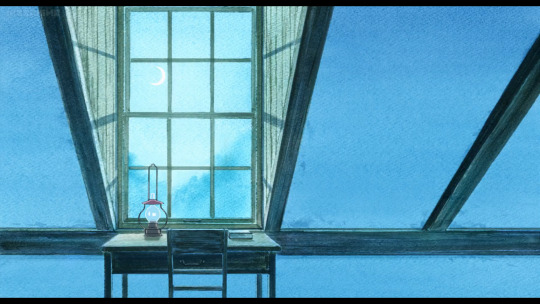

The title track is playing again, meaning we’re back in the fairy tale. The blue girl is enchanted by the moon and the night sky.

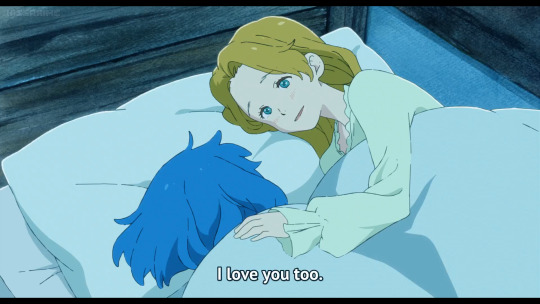
:’)


The blue girl is happy to be living with Liz, but she also loves her freedom. In the middle of the night while Liz is still asleep, the blue girl sneaks off and flies out the window.


Liz wakes up and finds her companion is missing.



Not much later, the blue girl returns from her night out at god-knows-where with god-knows-who, and climbs back in bed, relieved that Liz still seems to be asleep.

But she wasn’t.

Don’t make a Game of Thrones reference, don’t make a Game of Thrones reference, don’t make a Game of Thrones reference, don’t make a Game of Thrones ref--
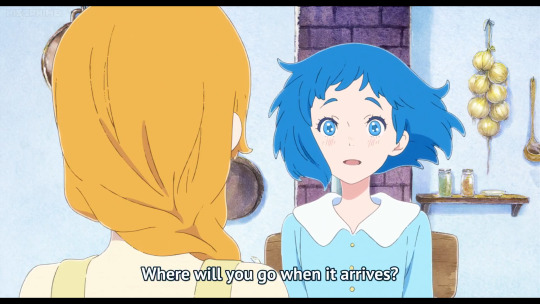
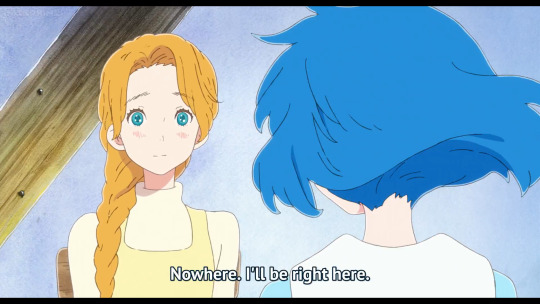

You mean humans don’t go south for the winter?
Where the blue girl realizes that she can go anywhere she chooses, while Liz chooses to stay grounded. I’m wondering, why does Liz choose to stay isolated at her cottage? She works in the city, and surely she could move there to save herself the commute? I’m guessing it’s that although she does appreciate interpersonal companionship, she’s still largely an introvert, preferring to spend time in nature.



Jesus Christ, you guys need a marriage counselor.


The blue girl sneaks back in again in the morning.

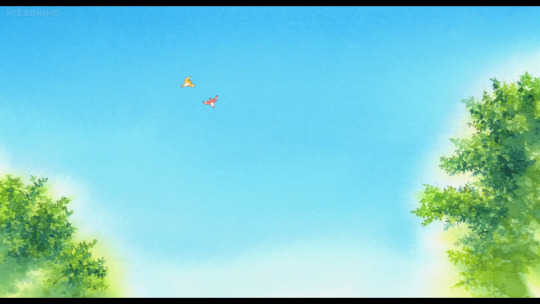

While the two of them are feeding the animals, they both see a couple of birds flying in the sky above them, as if taunting them. The blue girl wants to be with them, though she stays grounded for Liz’s sake. She made a promise to stay with her forever, after all and she intended to keep that promise. During the daytime, at least.


At this point in the story, Liz realizes that a sacrifice is going to have to be made.
Part 2
Part 3
#analysis#review#recap#animation appreciation#liz and the blue bird#hibike euphonium#anime#kyoto animation#kyoani#mizore yoroizuka#nozomi kasaki
23 notes
·
View notes
Text
AX3001: Oddyssey - TV Show Research and Development: Giygas and the Intrigue of having an unexplainable villain
When it came to making a TV Show, I always had an idea for an Earthbound spiritual successor since 2018 and over this last Summer when we were briefed to make three TV Shows. I had to really think about what ideas I wanted to do. However, during my downtime, I suddenly remembered one specific thing about my Earthbound experience...
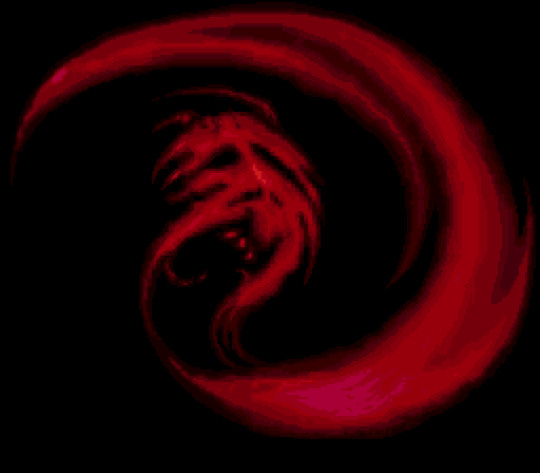
Giygas
The Embodiment of Evil, the Universal Cosmic Destroyer or the Almighty Idiot according to who you ask, Giygas is the main antagonist of Earthbound and appropriately serves as the game’s final boss before your adventure comes to a close. Granted, him being the very last thing you fight leads to you leaving with that boss fresh on your mind. But, I hadn’t played Earthbound for a few years... And Giygas just suddenly popped into my head. And a lot of the questions were “Why is he like this? This cute and friendly game has a boss that looks like a nightmare?” I was absolutely fascinated by this boss and it led to my second playthrough of the game.
Onett, the start of the Adventure

This is the hometown of our main character, Ness and effectively our window into the world of this game. We see the town he lives in, it’s so bright and colourful with all the town essentials! A burger shop, a town hall, an arcade, hospital, police station and library, it’s familiar to us as our hometowns most likely have similar locations. The vibrant colours of all the buildings is eye-catching and welcoming!
youtube
The music is also worth noting as it’s very peppy and upbeat, it feels like the theme of a small town with a nice community. Most of the music follows this formula.
Most of the towns in the game follow this design and it does feel like you’re exploring more and more of the world, like you’ve ventured further than you have ever gone before and you’re not going to stop because this world is so interesting and welcoming!
Some towns deviate from the formula, but the good people in the towns help to established the same welcoming energy that we’re used to.
Now, let’s take a look at the final map before Giygas’ lair...
The Cave of the Past, the end of the Adventure

Complete contrast to what has been established this entire game. There are absolutely no colours, there are no buildings, no operations of Giygas’ in the background. It’s just a path to the end of the journey and it’s so simple... But, it’s super effective! The lack of colour helps to make it feel otherworldly, makes it feel alien to the world that you’re used to and that’s exactly what Giygas is, he’s not from the world.

Even our main cast of heroes could not be transported back in time without being transferred into robot bodies, all of their colour is gone too. All except Ness’ hat, showing a small bit of colour almost as if it’s that one bit of hope of beating Giygas.
At the end of games, usually going to the final boss’ lair will be some huge event where you see all of their plans, what they’ve built over time and will be accompanied by some epic score. Earthbound does things differently.
youtube
Just give that a listen, it’s a eerie, droning piece that doesn’t sound like a great confrontation theme. It sounds like ambience more than a score to me and I think that makes it scarier, like you are in the positions of the kids who are probably incredibly scared of what they are going to have to face once inside that cave. It’s so incredible and it’s a sample of the Beach Boys song, ‘Deirdre’.
youtube
It’s the opening note and I find it amazing how a single sample can do so much! There is another Earthbound track that I will link here which features a sample of the trumpet in the intro of the Beatles song, ‘All you need is Love’ and again, it sets up so much with just a tiny little sample.
youtube
This is used just before going to the Cave of the Past, instead being the Cave of the Present. It’s technically just two notes with a reverb, but the sample adds so much and it just feels uncomfortable. However, we don’t need to talk about this for long, let’s go right to Giygas’ lair!
Giygas Lair, the true contrast to Earthbound’s style!

I apologise for the size of the image, but it’s pretty much a straight path but LOOK AT THIS! A trail of organs and entrails twisting and turning through this dark void until you find this uncanny monstrosity of a machine made of the same organic material you were walking on. This. This is what made me come back, it’s such a disturbing idea.

This is open to interpretation, but the way caves are represented in Earthbound is to only make sprites of the ground and walls. All the stuff you can’t see is black, just like how a cave should be. Giygas’ lair has this same motif, but there doesn’t really appear to be any walls around. So depending on your view, they’re either walking through a tunnel or entrails or walking through the void as previously stated. Personally, I think both are terrifically terrifying but I definitely see the void more.
youtube
The organs pulse as you walk up them, the only noise complimenting the atmosphere is the clanking of robo-feet and the breathing of Giygas which is what I feel gives it the whole void feeling. It’s so unnerving that this is the final confrontation, but the fact that it is actually puts us in Ness and his friends shoes.
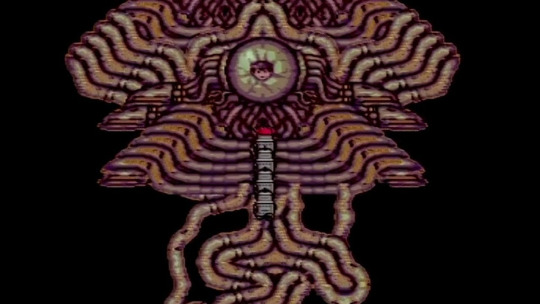
Getting to the Machine causes everything to stop, the ambience vanishes. Giygas’ intro music plays as the Machine changes to show the robots a picture of Ness’ face. Ness was prophesied to be the one who brings down Giygas and the first thing we see from the Machine is Ness, already suggesting to us that Giygas knows that we’re here...
Pokey, Ness’ childhood friend and eventual enemy over the course of the game, descends in a Spider Mech and just like that the Final Battle is about to begin!
The Final Fight
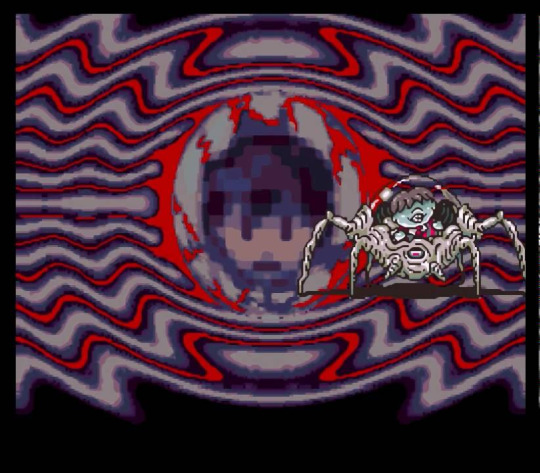
Of course, the final boss begins with Pokey standing before you with Giygas’ number one thought right now... Ness is here and he’s come to defeat me. This is a pretty standard affair for a boss, only Pokey can be harmed and he is much more a threat in this Spider Mech than he was previously in battle.
Giygas has a shield that is impervious to any kind of physical or psychic attacks and cannot be destroyed or disabled. He attacks using the special power that only Ness knows ‘PSI Rockin’’. His shield will always reflect your shots back at the character who attacks him and even when they have shield themselves, they will get hit regardless. The Machine is what keeps Giygas stable and alive, making him completely invincible...
However... He has one big idiot on his side...
Pokey can be damaged and the strategy of the fight is to focus on him and avoid any attacks that hit the both of them. Pokey, like the main cast, is a kid and he’s incredibly immature. So as soon as his mech is defeated, he taunts the main gang and turns off the Devil’s Machine... The one thing preventing Giygas’ defeat...
Giygas Released
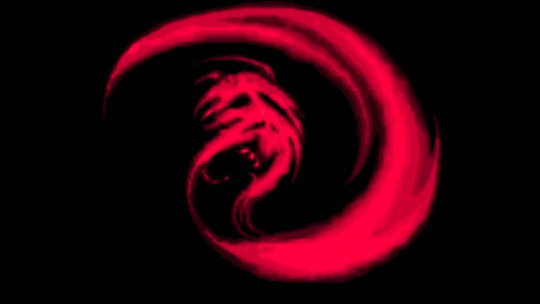
Once released, Pokey explains that Giygas isn’t even himself anymore. He became so powerful that his body was destroyed and had to be contained into a machine in order to maintain some sort of grasp on his thoughts. Without that machine, the four heroes are taken into a dimension of Giygas’ thoughts and since we play as Ness we hear his thoughts directed towards us the player.
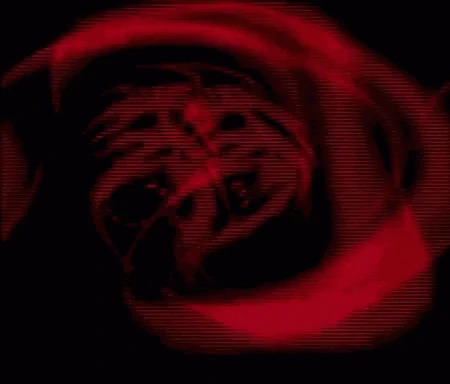
He reaches out with such thoughts as repeating Ness’ (The player’s) name, saying “I feel... Sad.” or “It feels good.” and added upon these thoughts Giygas’ attacks cannot be comprehended by our characters. It really helps to add a sense of hopelessness because we have no idea what is truly going on and we can’t fight what we don’t know.
An Unconventional Resolution
Attacks don’t work, defending won’t work either, you can’t heal or save yourself. All hopes seem lost until you notice a certain act that Paula can do. Pray.
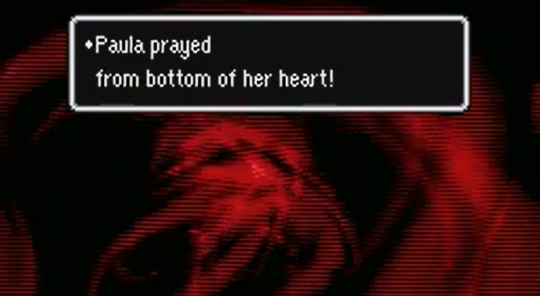
When Paula prays, she reaches out to the world she left behind and the folks that are waiting for their return get the feeling that something bad is happening. So, they too pray from the bottom of their hearts...
https://youtu.be/cptFVD3eTEs?start=320&end=374
If you watch the small clip above, once he feels the support from the Earth. The sound cue to signify that Giygas has been damaged and that Giygas is not okay.
Onward to his next form.
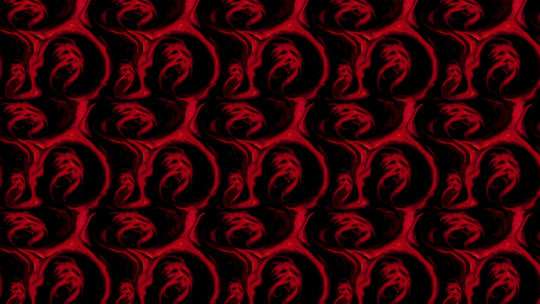
Now I would like you to take a close look at this image, I’ve asked a few people about this and sometimes they get it without me saying anything and others don’t. So, just take a moment to find an image amongst the Giygas’.
Got it or have you given up? In the realm of Giygas, here in the black void is a pretty damn distinct shape of a baby. And this is what fascinated me about Giygas, there is a theory that this is symbolism for abortion as you go back in time to kill Giygas but that theory has been disproven by Shigesato Itoi, the game’s creator. There’s evidence that goes against this theory anyway, but this fetus imagery always stuck out to me.
It’s said to be a coincidence that the Super Nintendo generated these sprites and in this pattern. But, it’s such a definite shape of a baby and I find it absolutely mental that it’s just a coincidence. And that curiosity is what brought me back to Earthbound, just this happy go lucky game where you make friends with a little monkey that chews bubblegum, make friends with a man who converts himself into a huge dungeon man and at the very end, you’re faced with this.
It’s not only impactful imagewise, but storywise it’s just as impactful for the opposite reasons. As Giygas can now be damaged by feeling the love and support coming from the friends Ness has made across the world. Each time Giygas is hit, it gets worse, but the moment he really breaks down is when Ness’ Mother wakes up in the middle of the night and rushes downstairs with Ness’ little sister and their dog. They all feel uneasy and begin to pray for the safety of Ness and his friends.
https://youtu.be/cptFVD3eTEs?start=702&end=738
This is the moment Giygas truly breaks down, feeling the support of a loving Mother looking out for her son is a feeling he had long since buried. It’s about time I talk about the backstory of Giygas, while it’s not touched upon in Earthbound/Mother 2, in Earthbound Beginnings/Mother we see Giygas as an alien and we learn about how he came to be.
Giygas and Trauma

Giygas was an alien that was raised by Maria and George, a couple that was abducted by the other members of Giygas’ race. Maria adopted Giygas and looked after him while George studied their powers without their approval and eventually escaped with this knowledge, never being seen again. Once Giygas grows up, he was instructed to ensure that no human is capable of using PSI powers and not wanting to betray the people who raised him, he forcefully detached himself from Maria to prepare for the invasion.
Maria was sent back to Earth, but with amnesia and once the Eight Melodies are obtained, she regains her memory and explains that it was a song she used to sing to Giygas when he was young. This is very important.

Giygas’ first attempt to take over the world. He comes down, looking upon the gang and the battle begins. Starting the trend of Mother/Earthbound games having a unusual way of defeating the final boss. This time, the group begins to sing the Eight Melodies which brings up emotions in Giygas that he thought he had long since repressed or even got over. Giygas has a complete mental breakdown and recalls his forces, swearing revenge on the planet and that he will return.
In Earthbound, Giygas has worked on himself and made sure that what brought him down before cannot bring him down again. However, he didn’t do enough since the feeling of a loving Mother reaching out to her son in his time of need still hurts him severely and it’s at this point where Giygas can hardly do anything. His sprite starts contorting, the colours shift and the audio turns into a droning whirring noise.
Ness’ Mothers love is one thing, but it’s not enough. Giygas is wounded, but he is still fighting. Paula keeps praying for one more person and with a few more attempts, that person is you. There’s a moment in the game where the fourth wall is broken and asks you to enter your name. It can even be your full name, my name is pretty long and my name fits into it perfectly. It’s emotionally engaging since it includes you and you feel like in a way you are defeating him rather than Giygas being defeated by the world of the game.
https://youtu.be/cptFVD3eTEs?start=838&end=938
After this Giygas loses control, the whirring increases, his sprite distorts further to the point where he is unrecognisable, the visuals cutting in with static occassionally. Static that appears at the very beginning of the game, suggesting the approach of Giygas and showing pictures of the invasion, and at the end of the game it suggest that he’s retreating, he’s getting out of reach and eventually he is gone.
And after all of that craziness, the robots are outside of Giygas’ lair. Everything is quiet, “The War against Giygas is over.”
What was Shigesato Itoi thinking?
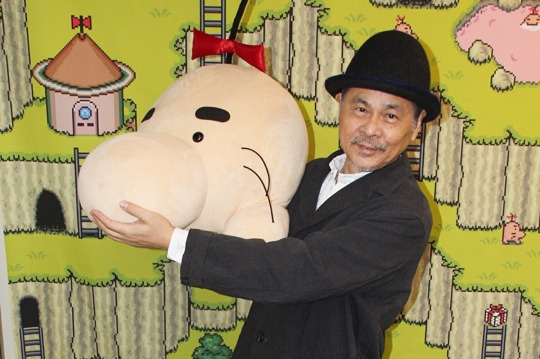
Shigesato Itoi drew inspiration from an event of his childhood, where he had walked into the wrong screen at the theatre. He walked in on a murder scene which as a kid he mistook for a rape scene which had such a potent effect on him. He drew inspiration from it for Giygas’ final battle and some of the things Giygas says.
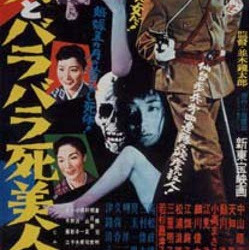
In an interview, Itoi claims that there was a scene where a guy grabbed a woman’s breast which distorted it into a ball shape. He said “It all hit me really hard. It was a direct attack on my brain.” despite the fact that this doesn’t actually happen in the movie, which Itoi admits that his memories are a little fuzzy. It’s probably because it all happened so fast and his child brain may have created false memories or just failed to understand it. Itoi also goes onto say, "this sense of terror having atrocity and eroticism side-by-side, and that’s what Giygas's lines at the end are. During the end, he says, “It hurts,” right? That's... her breast. It’s like, how do I put it, a “living-being” sensation." and the purpose of the scene is to get the player’s mind working.
Another interesting part of this interview is when Itoi talks about typical villains and says this, “Well, you know, having a villain there who simply goes, “Wahahaha!” and the like would clearly be bad. But, actually, when I think about it, having villains go, “Wahahaha!” is a really intriguing pattern. But there’s no point in wondering all by yourself for days on end what it means for a bad guy to go, “Wahahaha!” at the climax of a game, you know? I get the feeling that there aren’t many people in the game industry who would do that sort of thing, though.” Which is something important to consider, Earthbound is such a colourful game bursting with personality, so having it end with just a standard final boss affair probably wouldn’t feel satisfying.
What the Earthbound/Mother series taught me about final confrontations?
Giygas’ character and what it taught me that even “Universal Cosmic Destroyers” can have trauma that they are trying to avoid and bury. It humanises them in a way and it can make the final confrontation that more powerful as it’s a problem we can all relate to. They’re not all evil for the sake of being evil, sometimes they don’t have a choice.
I think this is a good thing to take on board and I have already begun planning on my main antagonist’s motivations on Oddyssey. It might be changed since it’s a sensitive topic for me right now, but these motivations won’t be brought up in Season 1 anyway
2 notes
·
View notes
Text
Isak season rankings (so far)
I’ve seen people doing this, and while we wait for SKAM Austin to get renewed 🤞 I thought I’d rank the Isak seasons that are out so far, according to my personal preference. People who wanted to read my Matteo and Cris meta, this is the very short version of it.
Warning: I am super critical in this ranking. If you’d rather read only compliments, don’t click the Read More.
SKAM s3 – Isak: I don’t consider myself a Skam supremacist or whatever the term in vogue is these days. There are many things about Skam that I’m not happy with. I wasn’t really into the idea of the remakes at first, but when they started coming out I hoped that some of the stuff I had issues with in Skam was handled better in the remakes. That said… I never had issues with season 3. I think it’s as perfect a TV season as it can get. The writing, the acting, the music, the cinematography… Everything has a reason for being there and nothing got unresolved. I don’t feel Isak’s season needs “fixing.” A good remake of Isak’s season, for me, is one that takes what Skam did and flips it and does entirely different things with it, not one that aims to tell the same story with cosmetic changes here and there.
DRUCK s3 – Matteo: I’m not sure if Matteo’s season would be as high for me personally if it weren’t for David, tbh! I fell in love with David before I even knew his name was David. My main issues with Druck s3 are these: Druck put a lot of effort in adapting the original storyline to David and Matteo’s personalities, but I don’t see the same effort with the internalized homophobia storyline. I don’t think the writing is consistent there. I also didn’t like the way they hinted at Matteo having a MI, but never committed to it. In fact, I’m not even sure the writers think Matteo has a MI? When the writers have done interviews they’ve talked of Matteo as a “slacker-type” character, not a character with mental health issues. I also have really mixed emotions about the way David’s outing clip was scripted and shot. But overall I had so much fun watching the season, I love David, I love David and Matteo together, and I love a lot of the musical moments. And honestly, it’s amazing that the writers decided David’s movie was going to be Only Lovers Left Alive, built the whole character around that idea, and that single trait explains so much about how David views himself, Matteo and the world.
SKAM España s2 – Cris: If it weren’t for David’s existence, Cris’ season would have the second spot. My issues with Cris’ season are that I feel like the writers had a much firmer hand when adapting Eva’s season. With Eva, they seemed more confident about getting rid of iconic moments or putting their own spin on them. With Cris, I felt like the criticisms they got in Eva’s season about getting rid of iconic moments made them try and include them even when they didn’t make sense for Cris and Joana. I’m thinking specifically of using 21:21and the pool scene, which had no significance for Cris or Joana’s characters. I also thoroughly hate Lucas getting hate crimed, and yes, it was handled better than in other remakes, but still. I’m from Spain, so yes, I’m aware of the cultural reasons for doing it, and I still think it was unnecessary on every level. (I’ll probably write something longer on this, because I do want to get into the ~cultural reasons,~ but not right now.) The music isn’t amazing because the music licensing costs in Spain are more expensive, but it does affect my overall enjoyment when the use of music was one of the things I loved about Skam. I also think Skam España tried to keep every fandom satisfied, which led to a more scattered season. (That said, compared to Skam’s Sana season, the POV was tight as fuck.) I don’t like that Cris and Joana didn’t have a sex scene. I understand that Irene was a minor at the time, but it doesn’t make up for the fact that Skam and Druck delivered extremely beautiful, non objectified sex scenes, and Skam España didn’t. Now, for the good: aside from the moments I mentioned, Cris and Joana were fully their own characters, Cris isn’t Isak and had her own struggles and character flaws she had to overcome, same for Joana. Cris and Amira’s friendship is everything, and considering how other remakes have handled friendships between a LGBTI character and a character of color, it’s almost enough to declare Skam España the holy grail of remakes. Also, one of the reasons it’s sad that the focus on the girl squad moves to the boy squad for Isak’s season is that the squad is at its most supportive and loving of the main in Isak’s season. By contrast, Eva, Noora and Sana’s seasons are full of betrayal and infighting. It was really so gratifying to get to see the girl squad support and love Cris. I also really liked that it was almost two queer seasons in one, with Cris and Lucas having their own journeys on Youtube and the episodes, which sometimes converged. I also loved the exploration of Viri’s character. Loved the borderline PD awareness content on instagram, for me the only valid use of Minutt for Minutt by a remake. I’m aware of the elephant in the room I’m not mentioning, but I feel like if it hadn’t been for the actors going wild on social media, that scene would have been a non event. Which brings me to…
SKAM Italia s2 – Martino: I really liked Eva Brighi’s season and I was really looking forward to Skam Italia’s take on Isak’s season. I really liked Martino in season 1. Martino’s season opened with a very powerful, factual voiceover of queer Italian people calling into a helpline to set the tableau of what it means to be queer in Italy. And then… it just got off the rails, man. Now, I did finish season 2 (racial slur and all), but I’m not sure I would have if it hadn’t been the first remake of Isak’s season. First off, they switched the order of the seasons, but instead of doing their due diligence and keep developing the Eleonora and Edoardo relationship (like Skam España did), they simply sent Eleonora to the cornfield to avoid having to deal with it. Second, the Skam España writers forced a few Isak and Even elements on Cris and Joana that didn’t fit them… Bessegato forced plenty more elements that didn’t have any relevance to Martino and Niccoló onto them. The obvious network interference when it came to Martino and Niccolò’s intimate scenes. And when I say intimate, I don’t mean sexy sex sex scenes, I mean the scenes that in Skam were Isak and Even existing in their own bubble. In Skam Italia, these scenes were intruded upon by the boy squad again and again. I’m not sure whether the Skam Italia fandom realizes that the reason the Italian boy squad is so loved is because they had a much larger role in Martino’s season that infringed on Martino and Niccolò’s dynamic. Anyway, I thought the boy squad was gross, honestly. The way the volleyball scene was shot was less about Martino’s discomfort and more about close up shots of a 14-year old actress’ sweaty butt and crotch. And for my money, I can’t understand why keeping Francesco Centorame meant they absolutely couldn’t cast an actor of color to play Luca. People talk about wtFOCK using certain tropes for shock value, but can we talk about the way Skam Italia had Niccolò literally run around Milan naked and giggling for the viewer to see? It appears that Skam was too tactful only giving us a glimpse of Even’s bare ass leaving the hotel room. We really needed to sensationalize the whole event, or otherwise it would fly over our heads how serious Niccolò’s crisis was. And Bessegato’s instagram tantrum when called out on Niccolò randomly dropping a racial slur mid-conversation was just the cherry on top. Oh, and I also hated the inclusion of Martino’s mom, but that’s more personal, so I’ll leave it at me having an issue with that decision because of hugely personal reasons I won’t go into. (Edit: I forgot to say that Filippo’s Pride speech is one of the best remakes of that scene, if not the best so far.)
Didn’t finish:
SKAM France s3 – Lucas: Okay, so here’s my Skam France story. Unlike a not small part of the fandom, I did watch s1 shortly after it came out. Now, I love Eva and Isak on Skam, they are two of my very favorites. I didn’t like Emma or Lucas. However, I love Jonas Vasquez and I felt like Yann was the only phase 1 remake Jonas that really did Jonas V justice. Not Jonas A, not Giovanni G, not Marlon F. Yann. So I came into s3 not very interested in Lucas (or Eliott to be completely honest), but fully pumped to see my boy Yann be the supportive friend Jonas had been in Skam and Yann had been in s1 and s2. Folks… I ragequit Skam France the moment Yann abandoned Lucas in that bench. And yeah, it can be argued that, while they used that moment for shock value, they stuck the landing. I personally disagree, the damage was done there, but it can be argued. Anyway, that was the end of episode 6, and by then I knew I didn’t vibe with Lucas (hadn’t liked him since s1 as aforementioned), Eliott had done nothing to get me onboard, couldn’t care less about the girl squad being forced into the season through network mandate, hated Basile and the Daphné/Basile storyline, and was bored as hell of people fawning over Arthur when the character was as lacking in substance as Mahdi, but fandom never went crazy over Mahdi in the same way (fun fact! Despite Skam fandom being much larger than any remake fandom, there were never essays about how great Sacha’s acting was, how carefully constructed his character, there weren’t people fighting for Mahdi-related usernames… I could go on). I simply can’t understand how the writers came up with the whole Polaris thing and then dropped it entirely after episode 4, and didn’t bother coming up with a twist on that motif. (You know, like the R+J and Pretty Woman twist, or how Druck used the vampire motif, or how Skam España used the Dangerous Liaisons motif throughout the season.) Like… Instead of using an existing piece of media, they created one tailored to what they wanted to do, but they didn’t follow through with it? Almost completely wasted the potential of the Lucas/light/darkness symbolism/motif. And, as I’ve mentioned with Skam España, I realize that the music licensing costs for France are astronomical, but again it does affect my overall enjoyment of the show, and the piano music didn’t make up for it.
wtFOCK s3 — Robbe: I gave Skam France six episodes before I quit. By the middle of week 2 of wtfock I was already checked out. The decision to delay Sander’s intro just completely ruined the pacing and anticipation for me. The lack of a tight POV was another nail in the coffin. How utterly loathsome Moyo and Jens were in that first week and a half was another factor. The way they resolved the issue of Milan leaning in for the kiss with Robbe was yet another. The wtfock characters having no nuance (most of them have one character trait, the most any of them have is three) was another. Initially I quit watching because I thought I’d write episode by episode posts, and I wanted to keep my reactions fresh. So I just read the transcripts. And every single thing I read in those transcripts only served to prove I was right in dropping it. But here’s one thing I liked! I liked the blurring of the fourth wall with the spray painting of the garbage truck and the garbage truck servicing Antwerp at the time the season aired. (I could draw a parallel between the garbage truck being the first motif the season deployed, and how the rest of the season turned out, and... well, I guess I just did.)
46 notes
·
View notes
Note
Extremely detailed asks for Atlaki please!
@salamanderapocalypse also asked about Atlaki so I’ll tag you here if that’s alright!
Thank you!! 💗
Sorry for no cut, I’m on mobile
The basics
1. Age, birthday, star sign
He’s 8 years old and /whispers/ I don’t know his birthday, shame, shame on me
2. Gender Identity
Masc-aligned nonbinary (he sees himself as ’male’ but how he relates to gender is from a non-human perspective that would be considered nonbinary)
3. Orientation and Relationship status (single, taken (by who?), crush (on who?)
Bisexual, taken by Cassien
4. Race and Ethnicity
Sylvari
5. Height and Body type
6”0, fairly lean body type.
6. Headcanon VA
I forget the actor’s name, but Hazel from the 2018 Watership Down remake.
7. Occupation
Commander and griffon trainer.
8. Weapon of Choice(?)
Axe and torch with a heavy touch of firebrand magic thrown in.
9. Hometown and current residence
The Grove; currently lives aboard a large airship.
10. Do they have any markings, piercings or scars?
Aurene-branded scar from where Bangar shot him, just over where a human heart would be. Ears are a bit torn here and there. Scar on his stomach from Balthazar.
11. Do they have any notable features, like horns, tails, or so on?
His canines are very pointed, and his nails tend to grow into claws, but he keeps them cut short.
12. Own any pets?
Two griffons, Buttercup and Orion!
13. Have any kids?
Nope. Unless you count Aurene.
14. Can they cook? Can they bake?
Don't let him in a kitchen unsupervised.
15. Can they sing? Can they dance?
Not fantastic, but he does, and yes, he enjoys dancing in private.
16. Can they drive?
Nope
17. Can they fight?
Yes, very well
18. Have any special keepsakes?
Caladbolg, although he doesn't use it. A magically preserved pressed flower from the Grove, to remind him of his roots (pun intended)
Interests
19. Hobbies
Griffon riding! He also enjoys sparring, and likes to paint in his (limited) free time.
21. Clothing/Aesthetic
Usually formal / armour, to present a strong appearance as commander. In casual settings he prefers to wear soft fabrics, as he struggles to grow his own armour nowadays.
23. Fave food(s) and drink(s)
Soups, potato dishes, bacon, chocolate, and for drinks he enjoys hot cocoa and just water. Isn’t too keen on alcohol.
25. Fave Color
Gold.
27. Fave Genre
Romance
29. Fave Season
Winter
31. City or Country?
Country
33. Guilty Pleasure
Eating way too much candy whenever he gets the chance.
Storytime
27. What’s their family like? Who’s in it? What’s their relationship with them?
Cassien is his partner, and Aurene he considers a daughter. The rest of Dragon’s Watch is like a family to him. The Pale Tree he feels conflicted towards - he is loyal to her, but also has some resentment towards her.
29. Are they literate? Did they go to school? How long? What level?
Yes, he learned to read during the war on Zhaitan. No school, being a sylvari.
31. What was childhood like?
N/A
33. What was adolescence like?
N/A
35. What’s their current main conflict?
Stopping Bangar and figuring out what Jormag’s deal is.
37. What steps have they taken to overcome this conflict?
Aside from canon story stuff: he’s started deeply researching Jormag, from old spoken legends to written accounts, in order to try to determine whether they are trustworthy or not.
39. How have they changed over time?
He went from an idealistic and naive sapling to someone desperate to make the world a kinder place even if it costs him his own life.
For Fun
34. What’s their room look like right now?
He lives on an airship and his room is pretty small. It’s kept neat and tidy, save for a few clothes on the bed. There’s one of Aurene’s glittering scales on his bedside table, and a vase of blue, night-blooming flowers
36. What are they like as a friend?
He’s loyal, attentive and sometimes overbearing. Always there if you need him, but needs encouragement to learn to have fun.
38. What are they like as a partner?
Supportive to the max, to the point he can be suffocating if he doesn’t get a hold of himself. Very loving and considerate, and again, extremely loyal.
40. Do they have any phobias?
Mind-control.
42. Did/do they go anywhere special for vacations?
He enjoys going the Labyrinthine Cliffs for the Festival of the Four Winds!
44. Your character walks into a cafe. What do they order?
Hot cocoa with whipped cream and marshmallows, and a chocolate chip cookie.
46. What time do they go to bed, usually?
11 pm - 3 am
48. What’s their morning routine like?
Get dressed, wash face, feed griffons and let them out to fly, have breakfast, contact Dragon’s Watch.
50. What’s the dumbest thing your character’s done?
Attempted a nosedive on his first griffon. Immediately passed out from the G force and fell off. Luckily the griffon caught him in midair and set him down on the ground. It isn’t a story he likes to tell.
52. What pokemon would your character be (if they’re already a pokemon/gijinka tell us what they are, and how that’s affected them)?
I know like 5 Pokemon, rip
54. What’s their pokemon team? Try to pick all 6.
Again, my Pokemon knowledge is sadly limited.
56. Theme song (and a playlist if you’ve got it!)
Perseus - the Unknown Brain
58. If this character was in a musical, what would their motif be (what kind of instruments do you hear, what’s the tempo, ect).
Strong but sad violin, slow tempo.
The Deep Lore™
47. What was this character’s biggest turning point in their life, something that changed them almost completely?
Trahearne’s death. The entirety of HoT marked his turn from “everything will work out in the end, good always wins, etc” to “maybe I can’t do this, but I have to try, even if it kills me.”
49. What was their lowest point? What was their highest point?
Lowest point was again, Trahearne’s death. It shook him to his core. His highest point wasn’t really one specific thing, but when Cas began to recover from the Nightmare. Every victory felt like a step towards healing for the both of them.
51. What are some themes tied to your character’s story?
Doing what’s right no matter the cost, found family, recovery from trauma.
53. What are some motifs associated with your character?
Deep blue, birds of prey, ancient ruins, stars, fire, pine trees.
55. What were some inspirations for your character (people, movies, games)?
Katara was a big one! I can’t recall any others by name right now but I really like how Katara’s anger and her kindness are so intertwined and I wanted to incorporate that into a character of my own.
57. How are you and your character the same? How are you different?
We both have a strong sense of morality and get angry when people cause unnecessary harm. We’re also both pretty stubborn, and shy. The main difference is Atlaki is a lot better with words than I am, I think xD
59. Expectations vs Reality: what did you expect and what did you get with this character?
I made him just wanting a sylvari character, and I ended up with my main commander.
61. What does your character want, and what do they need?
He wants to save Tyria.
He needs to learn he doesn’t have to carry that burden on his shoulders alone, and it’s okay to not do all things all the time.
63. What’s your character’s core trait? What’s their best trait? What’s their worst trait? When happens when these all interact with each other?
His core trait is determination.
His best trait is kindness.
His worst trait is how he can have a single-minded focus on things to the detriment of other issues.
Put together, he can be very determined to help someone in what he thinks is the right way, but in reality he could be missing the underlying cause of their problems.
65. What’s your overall goal with this character? Will they get a happy ending or will they succumb to their faults?
My goal is to get him to a point where he can balance his own life and desires with his job as Commander, and move on from his trauma to a happier future. He will absolutely get that happy ending!
6 notes
·
View notes
Text
Best of DC: Week of December 18th, 2019
Best of this Week: Doomsday Clock #12 - Geoff Johns, Gary Frank, Brad Anderson and Rob Leigh
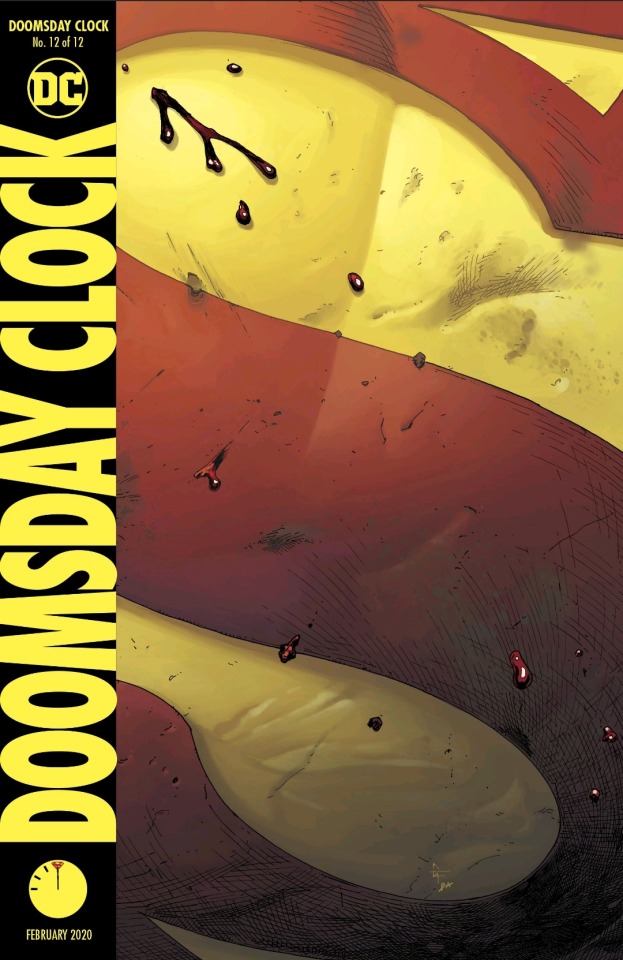
It’s finally over.
Doomsday Clock started in November of 2017. I remember the Wednesday when it came out. I chose two copies, the main cover for a friend and the Superman Variant cover by Gary Frank for myself. I even received a button that I still wear, faithfully on my signature hat. I was excited for this crossover - this confrontation between Alan Moore’s greatest creations (in my opinion) and the bright and colorful heroes of the DC Universe. At first, everything started off so well. The book came out monthly and it was amazing...for all of two or three issues.
Soon after, the book switched to a bi-monthly schedule so that Johns, Frank, Anderson and Leigh could tell the story right. I was willing to wait and every single issue was worth it...up until more delays. If the math were correct, the story should have finished in December of 2018, but here we are in December 2019...at the end of this long ass journey and I can honestly say that it was all worth it.

By God, was it worth it.
It’s hard to discuss what goes on in this book because I feel like it’s less about what happens in it and more about the meaning behind specific actions, reveals and reappearances. One of the things that we were sold on during this series was the inevitable confrontation between Superman and Doctor Manhattan and Geoff Johns manages to subvert our expectations n a good way in that the fight never quite happens, but is more of an ideological debate between cynicism and hope, something that’s been at the heart of this story and DC Rebirth since the beginning.
*MAJOR SPOILERS AHEAD*
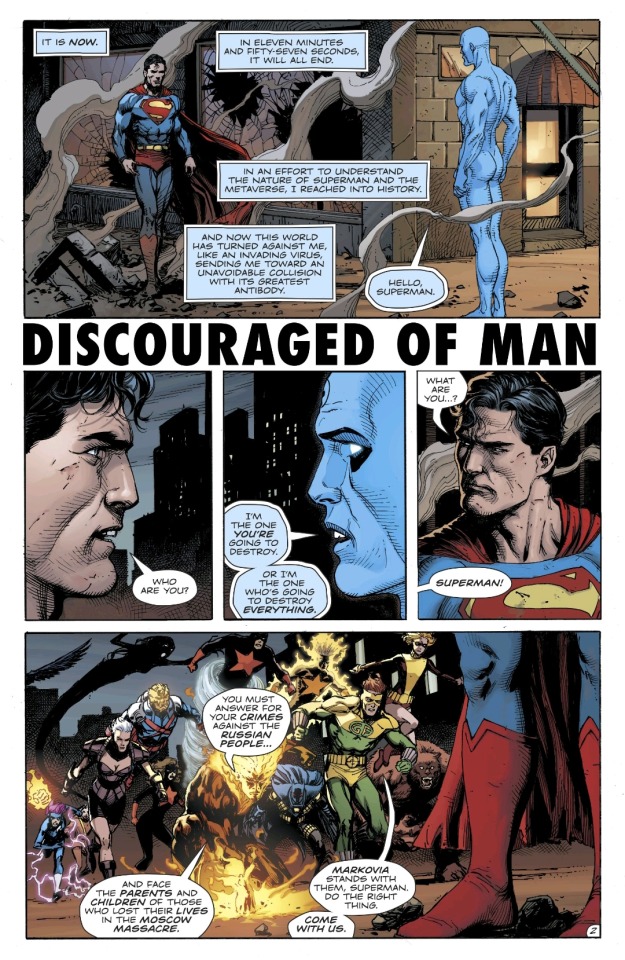
Finally confronting each other, Superman asks Doctor Manhattan who he is Manhattan explains that he is either the one who will destroy Superman or be destroyed by Superman. Before they can delve deeper into that conversation, Superman is beset on both sides by the forces of Russia with Markovia and those of Khandaq. Pozhar and Geo-Force order Superman to answer for Firestorm’s supposed crimes against Russia and Black Adam tells them that he will be held accountable in Khandaq. Tensions rise and the battle is on as Manhattan looks on at the powder keg that he has created.
Because of his curiosity and meddling with time, he has created this timeline where hope is fleeting and the Metaverse, as he calls it, is fighting back with Superman caught in the middle. Because of him, the Superman Theory has caused a palpable amount of distrust between the various nations and his causing Firestorm to explode only made those tensions worse. In an effort to understand his final visions of the future, he staged everything in an effort to get in front of Superman.
He has a monologue in his mind where he states that he is caught in a question of two answers, the answers he gave Superman earlier. Superman fights back against both sides as they fight each other. Meanwhile in Gotham City, Reggie Long, the new (former) Rorschach, is saved from an attack by a red hat wearing man by Alfred. Alfred tries to get him to don the mask of the man who killed his father again and Reggie violently pushes Alfred against a wall and decries his former hero and says that he sees no future, no hope, much like Doctor Manhattan.

Gary Frank makes excellent use of the nine-panel grid to show the emotion on Reggie’s face and how much all of this is affecting him. Interspersed between these panels are shots of Superman fighting before we get an AMAZING double page spread showing the block wide battle between the forces of Russia-Markovia and Khandaq. Vostok-X is thrown into a building, Black Adam fires lightning at Tara Markov, Giganta fights another giant hero, even the Batman and Superman of China make appearances as a past panel noted that heroes from around the world have gone to help Superman or oppose him in Washington.
In the middle of Reggie’s breakdown, Batman shows up and offers him encouragement, apologizing for not believing him earlier in the story. He tells Reggie that even if he hates what the mask stood for, he can give it his own meaning, become his own Rosrschach. This is when the theme of hope begins to build up more as in the middle of the big brawl, Superman does everything he can to save people. As a car is about to crush a family, Superman steps in to save them, he then pleads with Doctor Manhattan to do the same.
Up until this point, Doctor Manhattan had been operating on the idea that there were only two possible options to end his fight with Superman, he even reveals that he’s the one who erased Superman’s friends, mentors and killed his parents. Frank and Anderson then draw four amazing panels. Superman cocking his fist back, eyes full of rage, Doctor Manhattan closing in as to accept his fate, Superman lunging forward with the fist outstretched to the reader and concluding with one punch to an attacking Pozhar, saving Manhattan.

Manhattan is almost left dumbfounded and asks why he’s done this. Why did he save him? Superman replies that there’s a third choice to be made. Superman takes note of the pictures of Janey that Manhattan leaves around when he appears and questions that maybe the darkness that he sees is a result of him using his powers to save the universe like he wishes he could have saved himself and his world.
Doctor Manhattan raises his hands and says that he understands, releasing a surge of energy that makes everything fade away. One of the most powerful shots of this entire book are of Superman’s logo slowly dissipating and then thirteen panels of darkness before we see the Rebirth of everything and Clark’s place in the Metaverse. The fight goes on, but as Superman begins to fall, he receives help in the form of...Everyone. The New Legion of Superheroes and the Justice Society of America bring up the rear in quite possibly one of the most beautiful double page spreads in the book.
It’s easy to understand what Hope is to Geoff Johns. He’s a classic man. He sees hope in the DC Universe as the old heroes. The ones who aspired to do good and be good for reasons above themselves. The JSA inspired Superman to become a force for good and in turn, Superman inspired the future Legion. There’s a reason he wanted this series to reintroduce them in the wake of the darker, grittier New 52 and reinforce that darkness isn’t the only way to find the light. At the same time, Johns uses this book as an opportunity to explain the structure of the Metaverse, Superman’s place in it and inform future stories, crises and timelines for the DC Universe.

*SPOILERS MOSTLY OVER*
When Superman lifted that car in 1938 it was just the beginning, but when Barry Allen created the Speed Force, the universe had its first divide and Superman’s timeline shifted up. This split created Earth-2 where Golden Age Superman still resides. The first Crisis divided the Earth again, creating Earth-1985 and at the center of that is still Superman. After Flashpoint and subsequently Rebirth, Earth-52 was spawned.
Superman is the glue that holds everything together.

Superman is the quintessential hero that everything revolves around and he will always show humanity the way. He’ll appear on many Earths at many different points in many different timelines to inspire hope where none can be found. That’s why I love this story so much. Even though Superman and Manhattan didn’t appear in it very much in the first half, their presence was still felt throughout. There was always this air of hope versus despair and we see who won out. The Watchmen Universe served as the perfect deconstruction of superheroes, but what we’re witnessing with Doomsday Clock is the reconstruction.
It’s the returning of the ideal that’s been lost to so many following endless gritty reboots, terrible political conflict in the modern day and lack of truth, justice and the American - no, Human way. In an age where people don’t know how to write a Superman movie, Doomsday Clock should be the example. Against all odds, Superman managed to inspire a being that has shunted away their humanity for the black and whites of logic instead of focusing on all possible options based on hope.
Doomsday Clock may not exactly stand on the same pedestal as the story that inspired it, but it absolutely should stand high. Gary Frank is an amazing artist that gave this book the weight, scope and respect that it deserved throughout. Amazing faces, body language, scene framing, use of visual motifs such as the Carnival picture puts this story above and beyond in terms of art quality. The way he managed to cram so many heroes on only two pages with insane amounts of detail for each is a testament to his ability and similarity to Watchmen artist Dave Gibbons.

Brad Anderson’s colors gave each individual issue their own unique feel with this one making good use of Doctor Manhattan’s blue light in the form of being a new symbol of hope in the face of the dark inks and oranges of the destruction taking place. Even when the mass of characters appear, no one gets lost in the pages because their colors are so distinct and recognizable amongst each other.
This story also couldn’t have been told without Rob Leigh’s amazing lettering. The way that we can distinguish between Manhattan’s dialogue, feel the weight of every character’s words and the bubble placement shows a level of skill that allows us to enjoy the flow of dialogue without losing any of the art.
It’s been a long journey to finally get here, but it has been worth the wait. Even if the current state of the DC Universe has either gone past this story or if it’ll need to be retconned to have been before the current events of Year of the Villain, there’s still a place for it in the overall landscape. I loved all of this and this is the kind of story that makes me glad to be a comic book fan. There’s nuance to everything, a good few messages and amazing art. Better yet, it ensures Geoff Johns future legacy will be one of hope and inspiration thanks to the time that he loved so much and hopes to get back to.

I welcome the return of the Legion of Superheroes even as I’m not the biggest fan of Brian Michael Bendis. Even more so for the Justice Society of America whenever they get a new series announced. It’s great to see the classics again and I’m interested as to how they’ll do in this new modern age.
As for Doctor Manhattan and the rest of the Watchmen characters, without a doubt I think we’ll be seeing some of them again at different points. They didn’t overstay their welcome or absolutely destroy everything like I thought they might, but we know that they’re around and we know there’s still stories to be told despite Alan Moore’s own feelings on such things.
This isn't the perfect sequel to Watchmen, how could it be? But it is an amazing Watchmen adjacent book that builds off of the themes of that story and injects the DCUs vision of hope and justice into these characters. For that, I am glad to have read it.

Doomsday has been avoided and we have several hours before midnight, at least for now.
#doomsday clock#doctor manhattan#superman#justice society of america#legion of super heroes#geoff johns#gary frank#brad anderson#rob leigh#dc comics#comics#comic review
32 notes
·
View notes